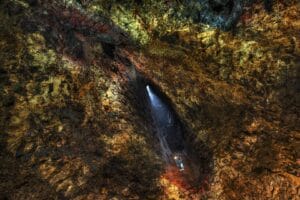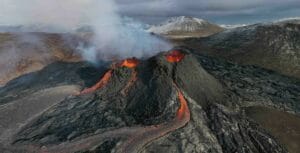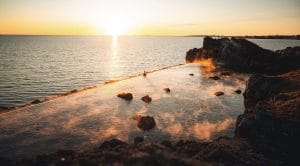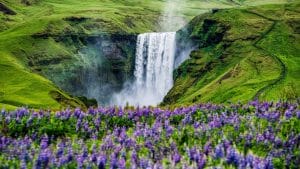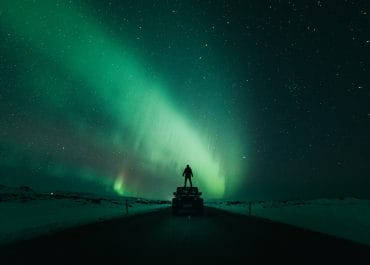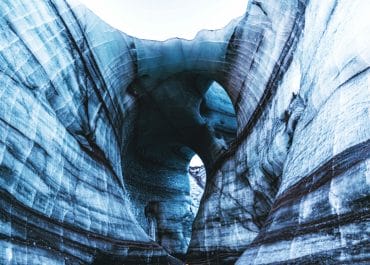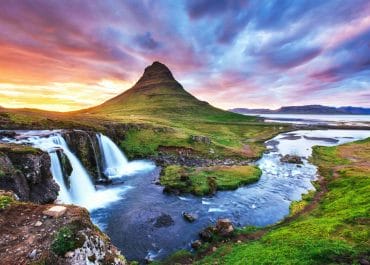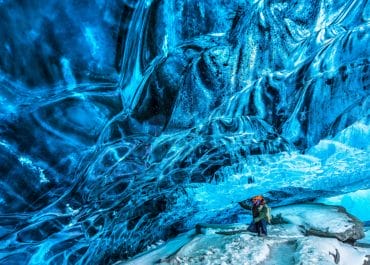Iceland is an incredible country with stunning landscapes and geological formations. Included in the top 20 largest islands globally, Iceland is located in the North Atlantic Ocean in the northern hemisphere. The country is known for its incredible beauty and unique land of fire and ice.
This list of top 100 locations in Iceland is carefully listed to ease your travels. We have divided the sections into categories spanning from North and East to South and West, and popular spots. This detailed listing contains everything a traveler wants to know. These choices are based on individual experiences and data compiled from different online sources.
So without further ado, let’s get started with the incredible list.
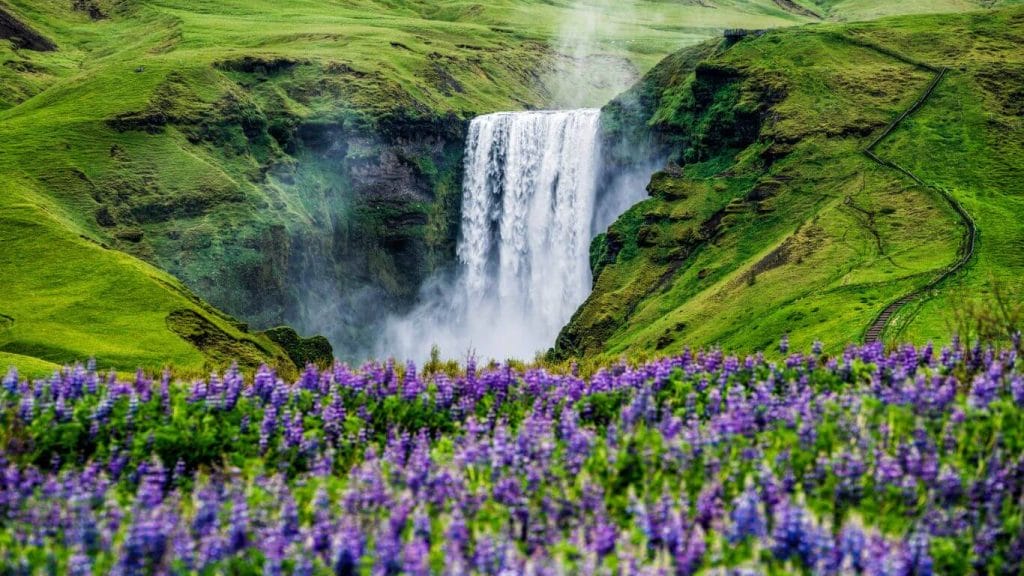
SOUTH ICELAND
The South Coast is a picturesque amalgamation of glacier lagoons, a national park, lava fields endlessly dried, awe-inspiring cliffsides, and unforgettable fishing villages. Numerous volcanic lava flows during the Ice Age make the coast geologically young. The Hekla and Eyjafjallajökull are two of the most active volcanos in the region.
The Quake 2008 exhibition at the Hveragerði displays the splitting of the Eurasian and North American tectonic plates. South Iceland is easily accessible through Ring Road Route-1, and most of the attractions in the region lie within 2-hours of driving distance via jeep, car, or bus from Reykjavik.
The area comprises marshlands, diverse landscapes, bays, estuaries, cultivated pastures, and black sand deserts. The Þjórsárhraun lava fields also rest underneath the soil, and early southern Icelandic settlements are based on fishing. Þorlákshöfn town is the most significant harbor in the area.
1. Seljalandsfoss Waterfall

Fed by the Eyjafjallajokull volcano’s glacier cap, the Seljalandsfoss waterfall goes directly into a pretty meadow. The attraction running beside the Southern Coast offers a mesmerizing view of the surroundings while walking behind it and is often a tour staple stop. The waterfall has been a part of Justin Bieber’s “I’ll Show You” music video.
2. Skógafoss Waterfall

Renowned for the legend of a treasure chest and 60-meters drop, Skógafoss waterfall offers a rainbow view during summers. Five hundred twenty-seven steps lead to the observation platform and surround it with photogenic landscapes. Unfortunately, the base rocks become icy and dangerously approachable during winters.
3. Reynisfjara

Lying between Dyrhólaey, and Vík í Mýrdal village, Reynisfjara, a black sand beach formed with volcanic shorelines, distant mountainscapes, rock formations, and towering cliffs. Infamous for sneaker waves and surrounded by ice-cold water, Reynisfjara is associated with Viking folklore. The locals refer to the rock-filled sea stacks on the shoreline as Reynisdrangar.
4. Dyrhólaey
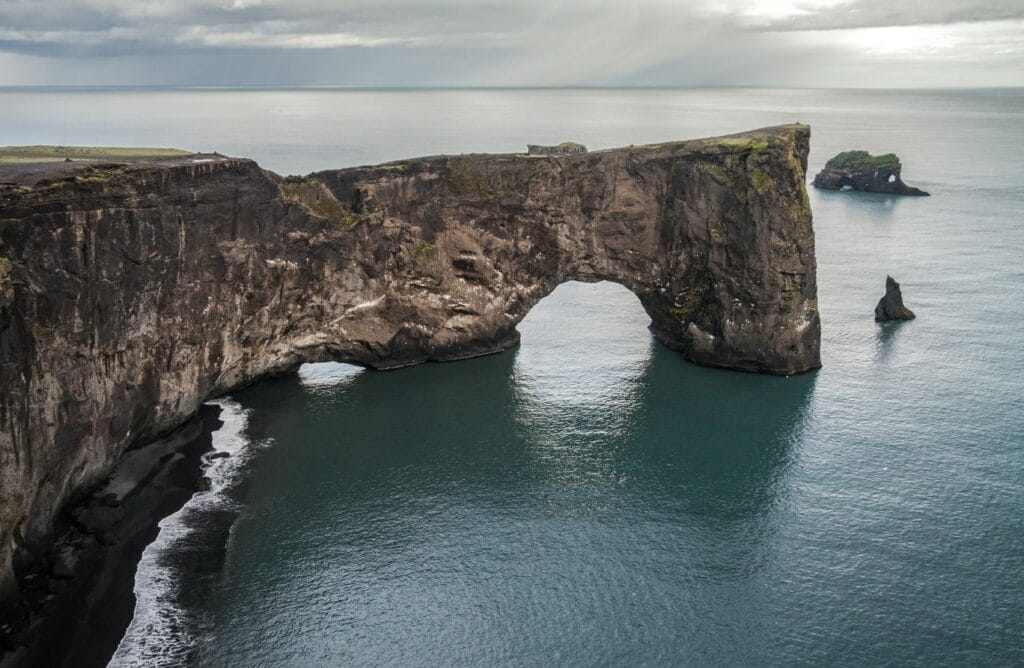
A small peninsula and a former volcanic island separated from the mainland, Dyrhólaey offers a spectacular view of birdlife from the cliff and a scene dominating the rock arch. You can view Puffins and Arctic Terns, except during the nesting months, May and June. The 120-meter promenade also has sights of glittering Atlantic waves, mountainscapes, and black sand beaches.
5. Vík
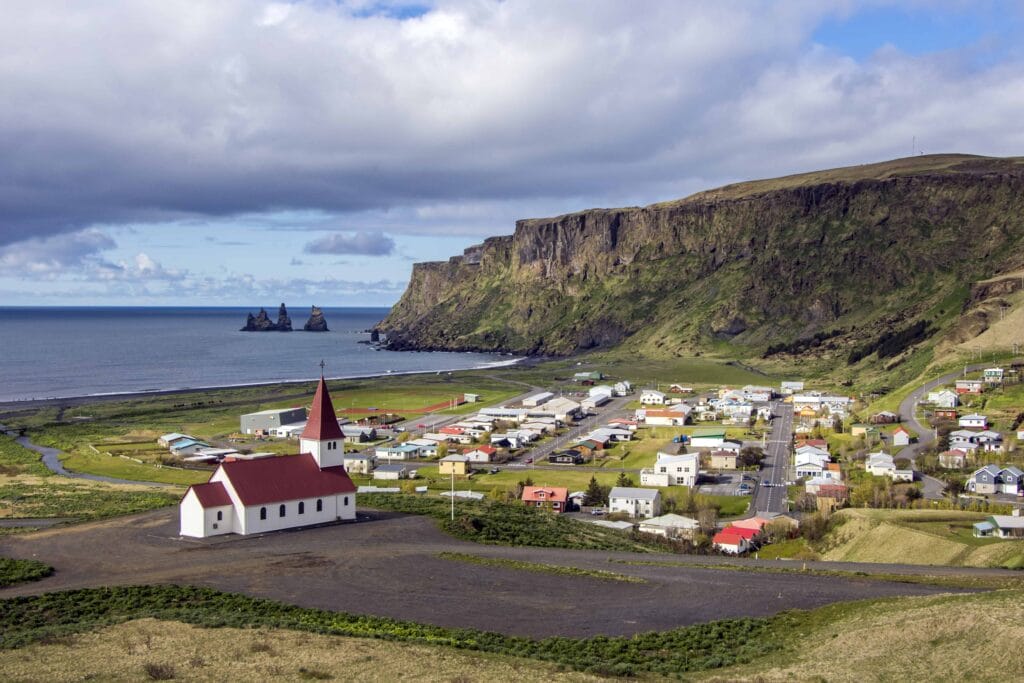
A village, souvenir shopping hub, and lunch stop, Vík í Mýrdal houses no more than 300 people and lies on the southern side of Mýrdalsjökull glacier. Inexperienced with eruptions, Vik offers Katla volcano excursions for natural ice cave explorations. Situated 186 km from Reykjavík, Vík has the warmest temperatures by two degrees compared to other country regions.
6. Jökulsárlón
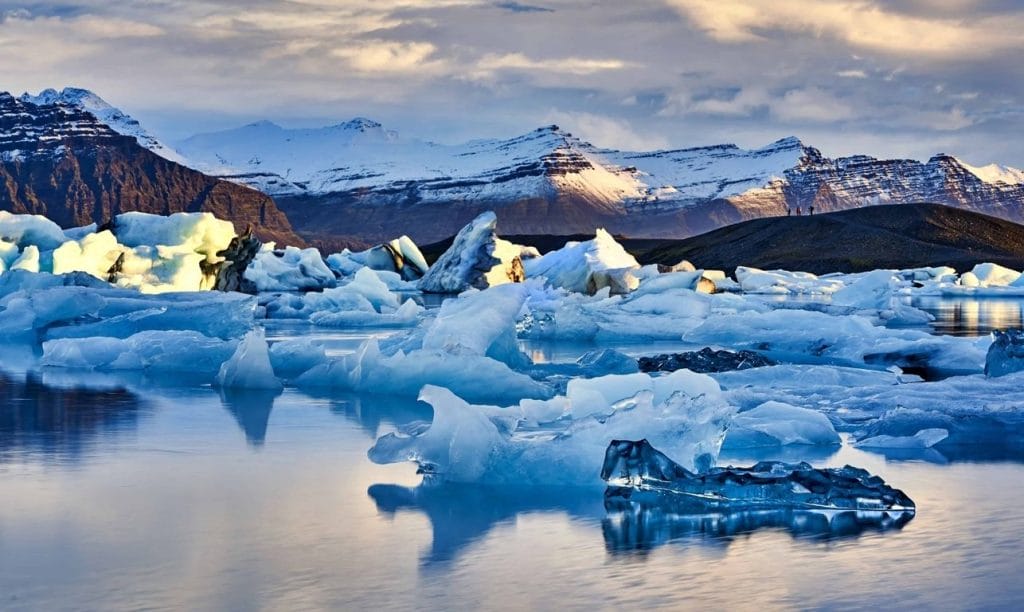
Renowned as Iceland’s Crown Jewel, Jökulsárlón offers scenic views of icebergs, seal colonies, ice caps, and Vatnajökull National Park mountains. The Jökulsárlón glacier lagoon is rapidly enlarging because of the large ice chunks and has expanded up to 18 square km since 1934-35. As a result, Jökulsárlón seems more like a lake formed with glacier outlet meltwater.
7. Diamond Beach

Almost five minutes from Jökulsárlón, the Diamond Beach is a photographer’s hub with black volcanic sand and pale blue ice. The naturally formed icebergs and rolling tides offer a distinct picture capturing experience and showcase ethereal nature. A plain strip of the greater Breiðamerkursandur, the diamond beach creates at stark contrast with washed-up Jökulsárlón glacier lagoon icebergs.
8. Skaftafell

Lying amidst Öræfi or the Wasteland, Skaftafell nature reserve, a former national park, is home to Hvannadalshnúkur and Morsárfoss, the tallest peak and waterfall of the country. The fertile green birch land also coincides with the Vatnajökull glacier, making it a hiking hub. The rich and growing flora between the glaciers and sands is an amazing contrasting scenery for most visitors.
9. Fjaðrárgljúfur
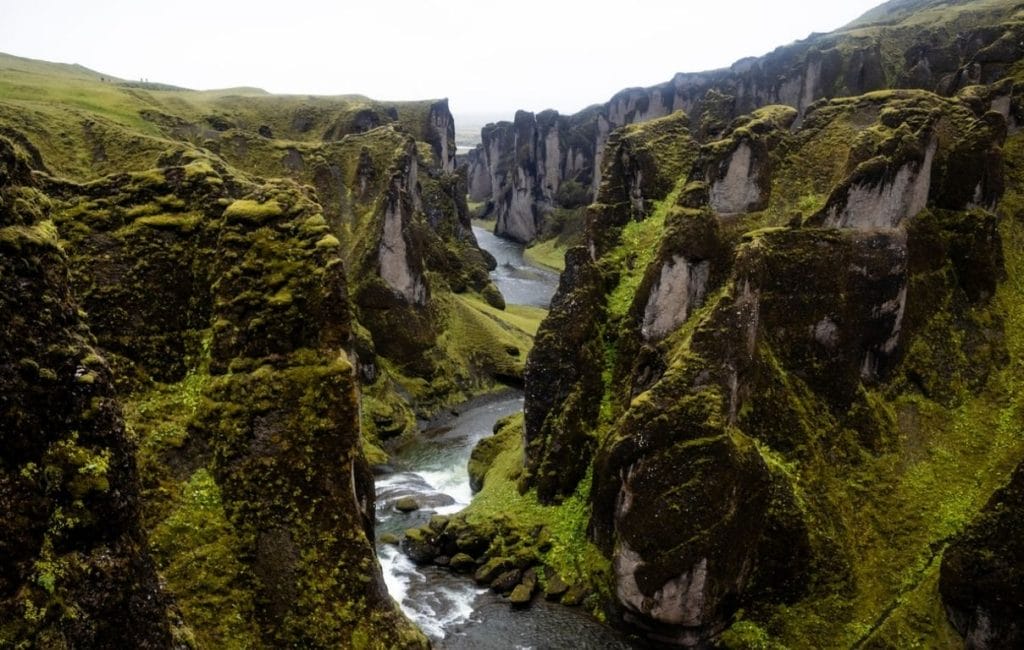
Transformed over 9,000 years, the Fjaðrárgljúfur canyon has a 2 km and 100-meter deep river, narrow pathways, and steep walls. The ice age palagonite bedrock and Fjaðrá river arriving from Mt. Geirlandshraun have made a winding canyon shape. The dramatic canyon lies next to the historic Kirkjubæjarklaustur town.
10. Seljavallalaug
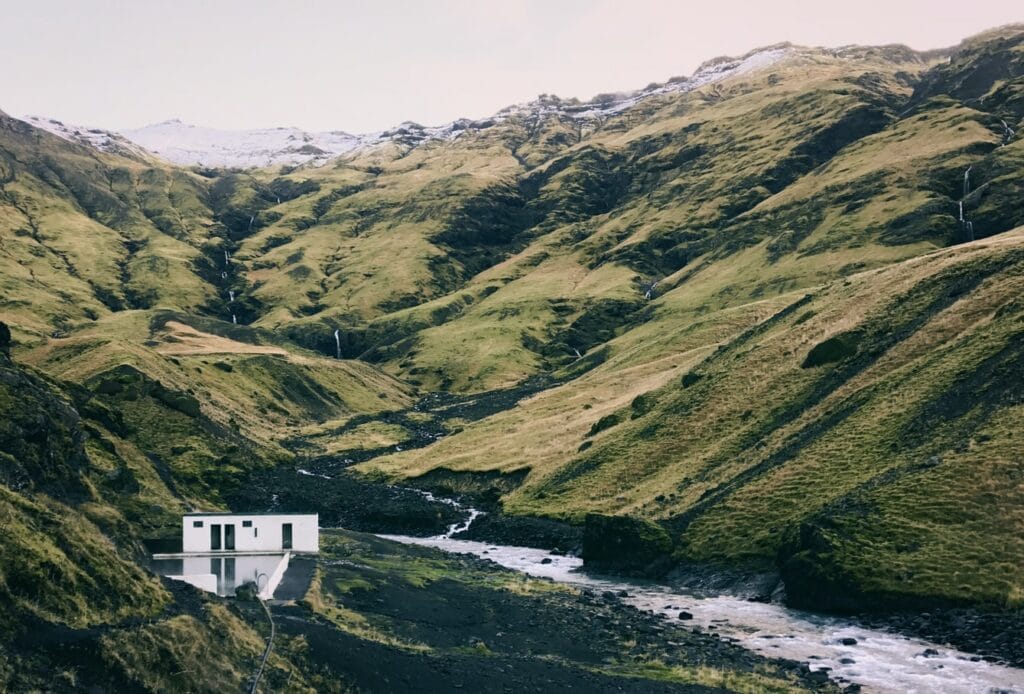
Located 23 km east of the Seljalandsfoss waterfall, the Seljavallalaug outdoor pool dated 1923 and remained the most extensive country pool with a 25-meter length and 10-meter width until 1936. Algae grow underneath and on the sides of the pool and are reachable by driving east from the Ring Road while arriving through Reykjavík.
11. Reykjadalur Hot Spring
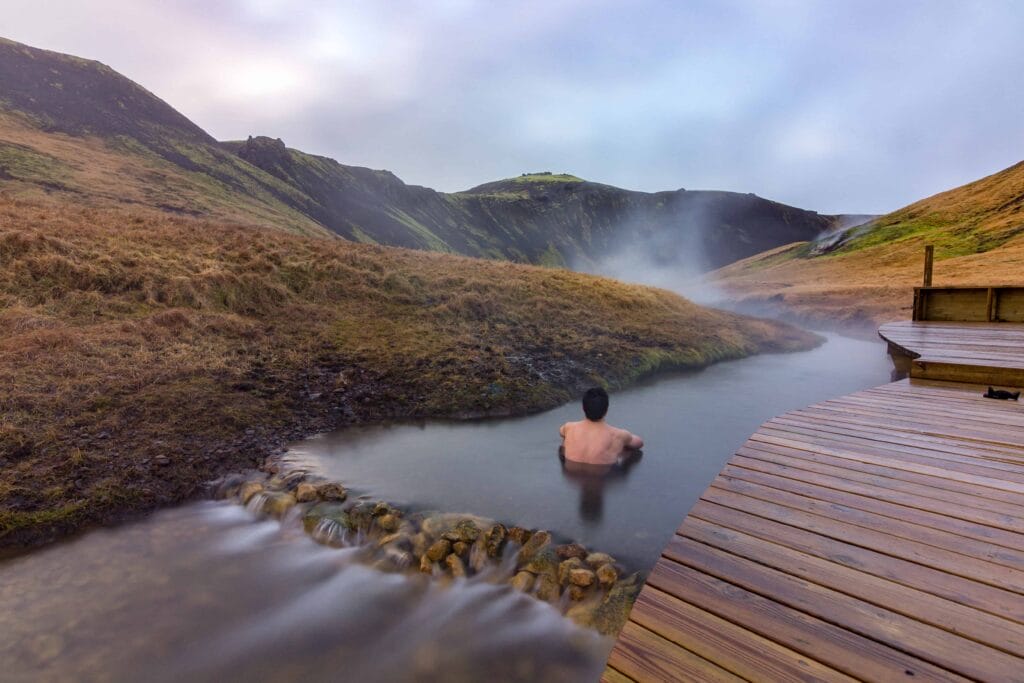
The Reykjadalur valley is home to many hot springs and is famous as “Stream Valley.” The hot springs are surrounded by lush green hillsides, waterfalls, and geothermal springs. The Reykjadalur hot springs lie beside the 2,500 people town Hveragerði. The hot spring lies 45 km from Reykjavík and is part of the Hengill area.
12. Gljúfrabúi
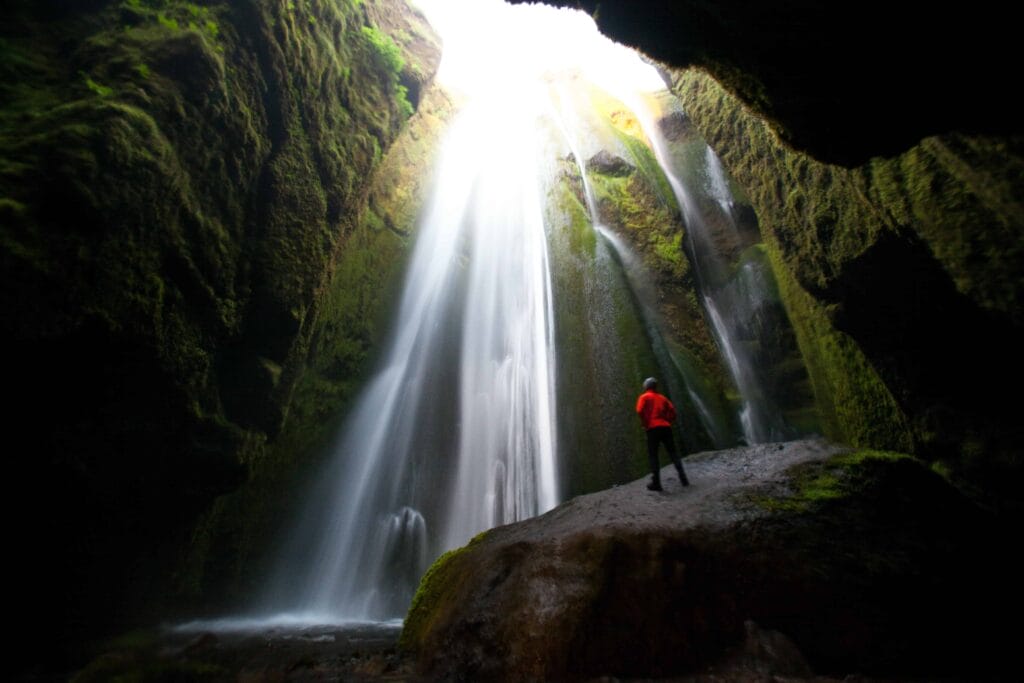
A small waterfall beside Seljalandsfoss, Gljúfrabúi, is hidden inside the ancient sea cliff’s gorge. Photographers often appreciate the surrounding greenery and water drawing from the Gljúfrabúi, a.k.a. Canyon Dweller, from a height of 131 feet. The waterfall is situated at Hamragarðar, and its cliff faces the Atlantic Ocean and the South Coast.
13. Kvernufoss
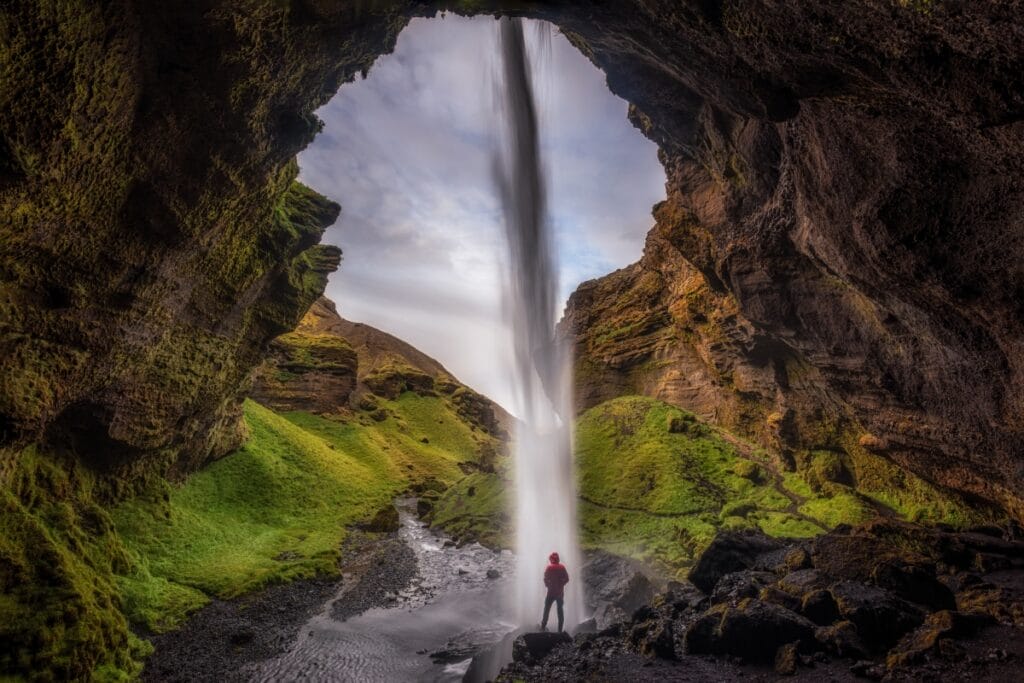
The 98-feet Kvernufoss waterfall is partially hidden in the gorge and lies on the eastern end of the Skógafoss waterfall. A 20-minutes hike beginning from the Skógasafn museum to Kvernufoss by the river also offers a view of gorge and gravel. Then, the trek leads towards the Kvernugil gorge and the Kvernuhólsá river.
14. Sólheimasandur
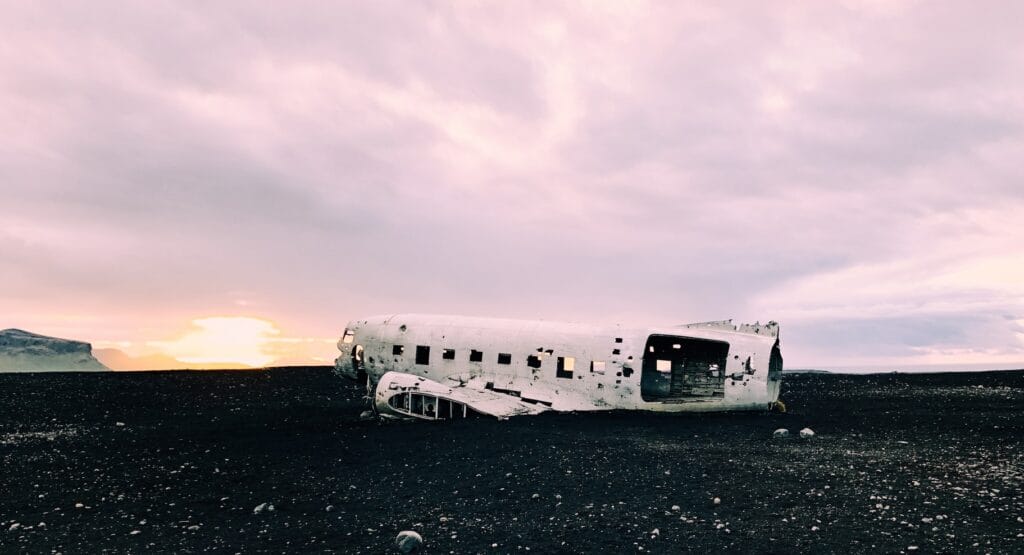
A vast gravel and sand area amidst modern shoreline and interior cliffs, Sólheimasandur was constructed due to a glacier burst. The site offers scientific unpredictability and glacier flood vulnerabilities. Sólheimasandur offers haunting and ethereal beauty with black sand resembling a lunar landscape. One of the most prominent attractions of the place is the DC-3 plane wreckage sight.
15. Svartifoss Waterfall

Lying 1.5 km uphill from the Visitor Centre in Skaftafell, Svartifoss waterfall is accompanied mainly by viewing other gorge waterfalls. Invisible from the road, the magnificent waterfall takes 90-minutes to hike both ways and is an oasis. The 20-meter tall waterfall is an oasis and surrounded by columnar basalt structures.
16. Lómagnúpur
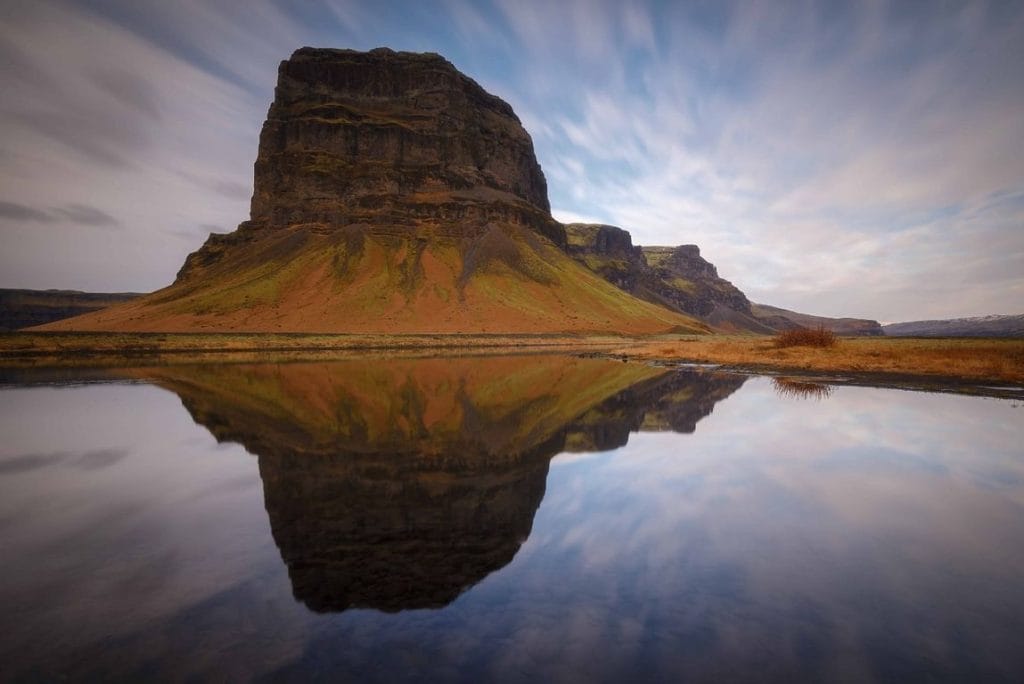
The million-year-old Mt. Lómagnúpur offers garden surroundings, a base open blue fjord, and cliff faces. The mountain base consists of lava beds, palagonite, and sediments and holds cultural and historical significance and folklores. The 767-meter tall mountain has been clearly defined in the poem Áfangar by Jón Helgason.
17. Sólheimasandur Plane Wreck
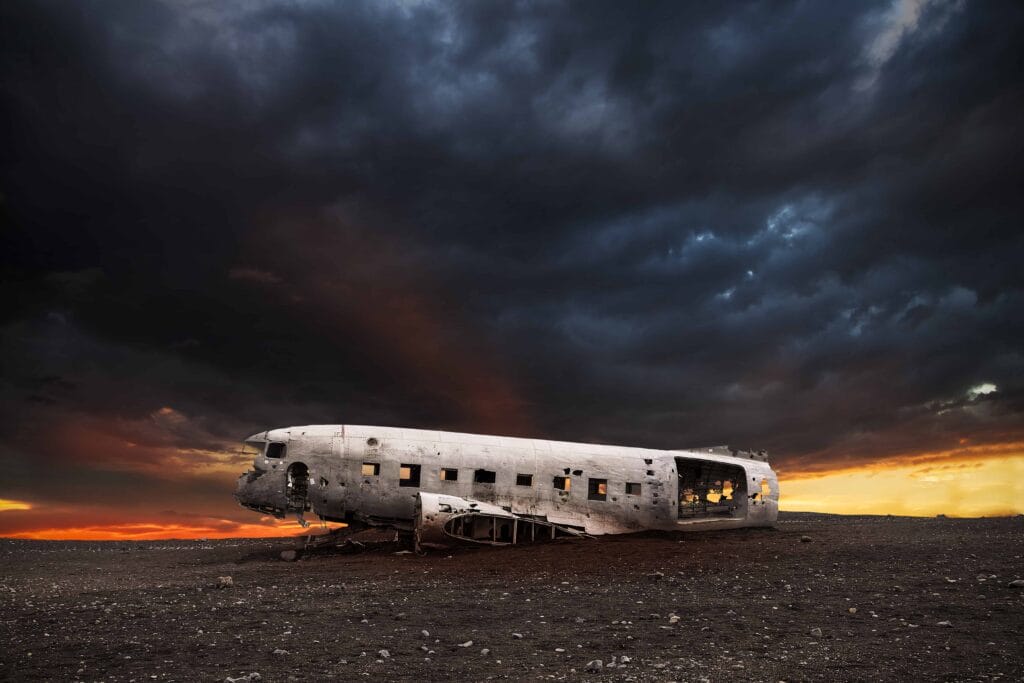
Located amids the Vík í Mýrdal fishing village and Hvolsvöllur, Sólheimasandur plane wreck is a prominent US Navy DC-3 plane wreck site. The wreckage destination resulted from the 1973 crash and offered a stark contrast of history and natural resources. Visitors can go inside the abandoned plane for shooting and playing.
18. Foss á Síðu
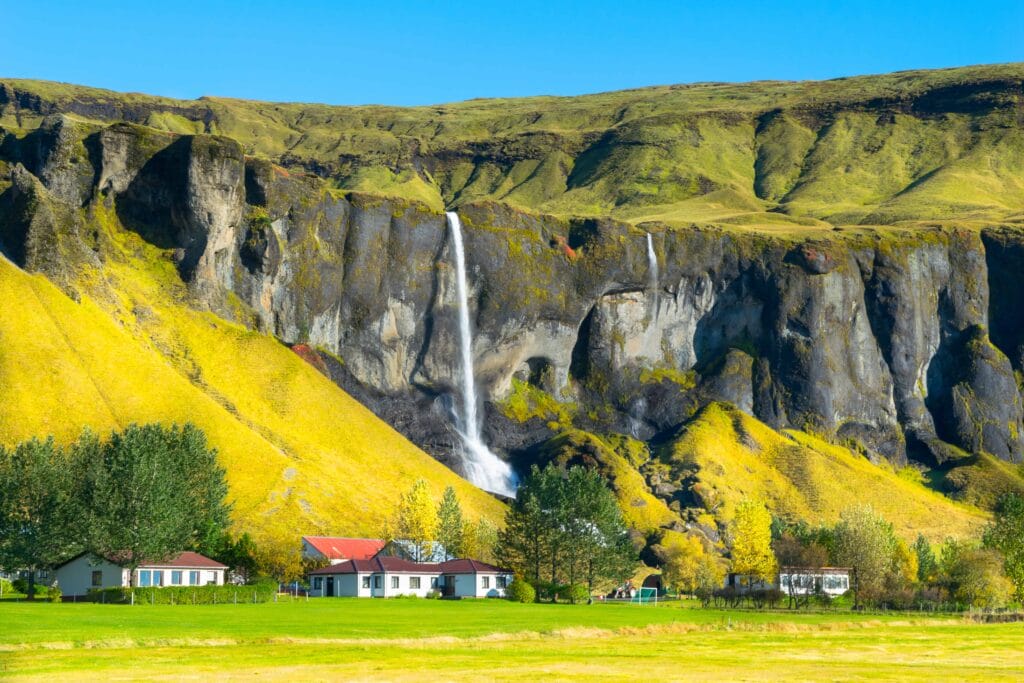
A historic farm, Foss á Síðu inhabited since the Settlement Era of Iceland is associated with a cursed man’s mysterious 16th Century legends. The place is 10 km from Kirkjubæklaustur village, former piety, and religious center. Foss á Síðu is also mentioned in the Book of Settlements.
19. Hofskirkja Turf Church
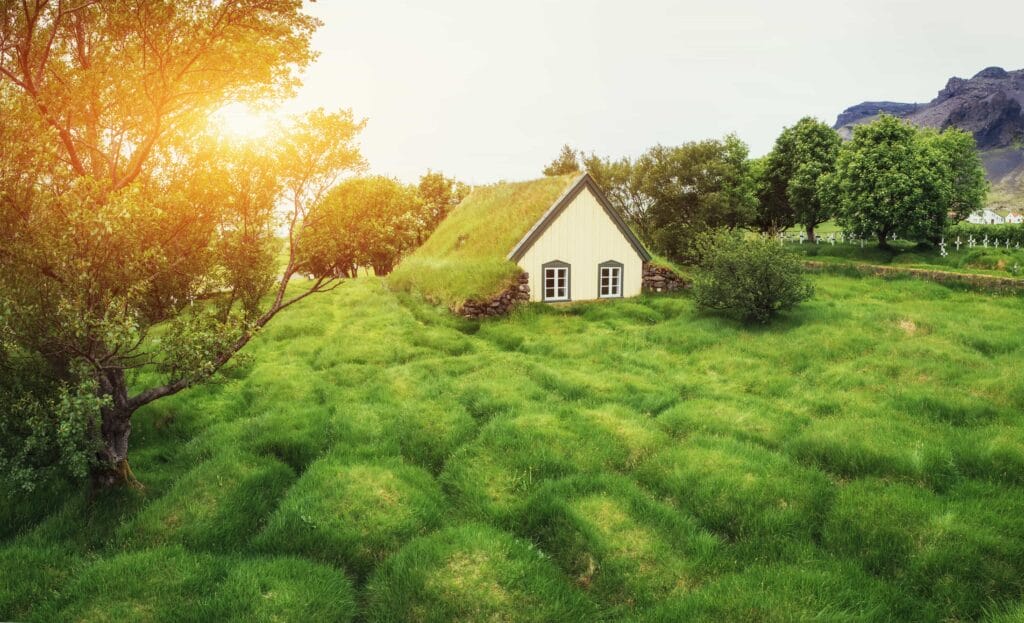
The Öræfi regions Hofskirkja is one of the six Icelandic turf churches bearing the traditional style and was built by Páll Pálsson. The 16th or 17th-century Danish tin candle lights are visible inside St. Clement dedicated attraction. The chancel screen divides the church into two parts, namely choir, and nave.
20. Fjallsárlón Glacier Lagoon
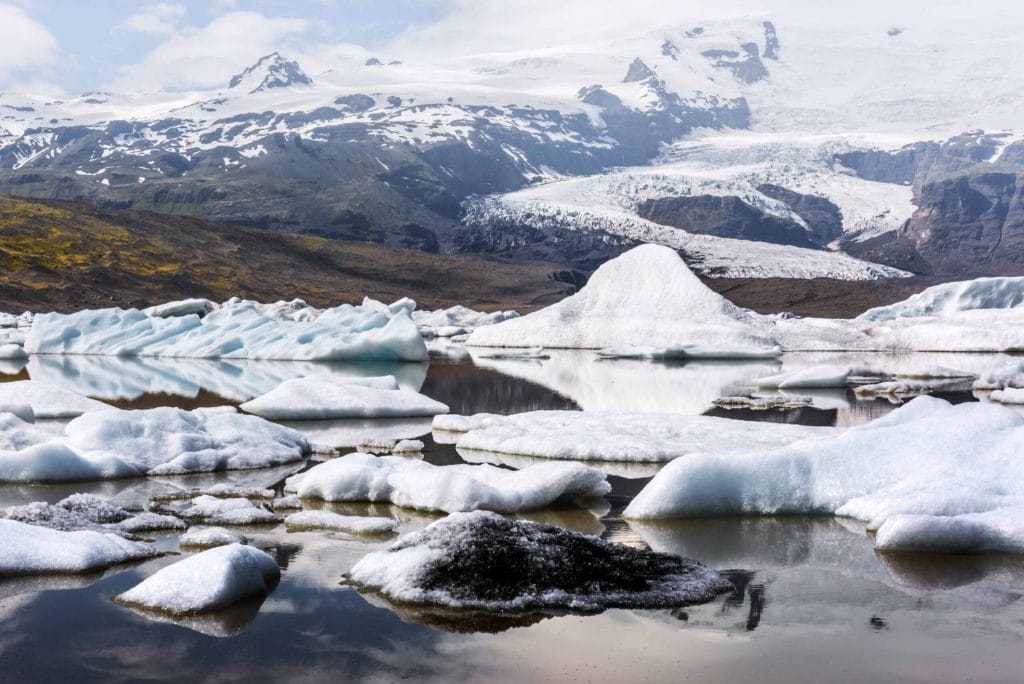
The iceberg-filled Fjallsárlón glacier lagoon lies in the vicinity of the Vatnajökull glacier and Jökulsárlón glacier lagoon. The glacier snout of Fjallsárlón offers a better view than Jökulsárlón, and diminished height gives a chance to go close to the ice cap. The Fjallsjökull glacier outlet of the Vatnajökull reaches the lagoon surface.
21. Katla Ice Cave

One of the most visited places in Iceland, the Katla ice cave offers colorful and shimmering ice formations with a sight of surrounded gravel & snow roads and rivers. The cave forms unique ice formations every year during winter. The snow walk towards the cave provides unforgettable views.
22. Sólheimajökull Glacier
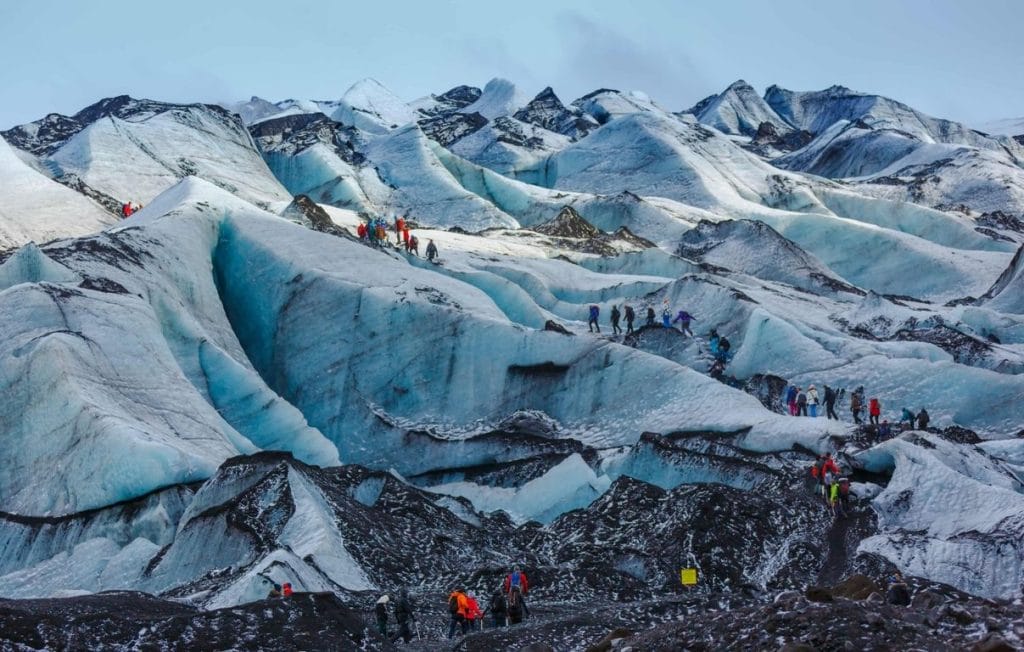
Rugged ridges, crevasses, and sinkholes form the Sólheimajökull glacier lying at the Mýrdalsjökull glacier’s tongue. A hiker paradise, the glacier is constantly changing and retreated almost a kilometer in the past decade. The rich sulphuric acid smelly Jökulsá river runs here, and Sólheimajökull may not exist after a few decades.
23. Svínafellsjökull Glacier
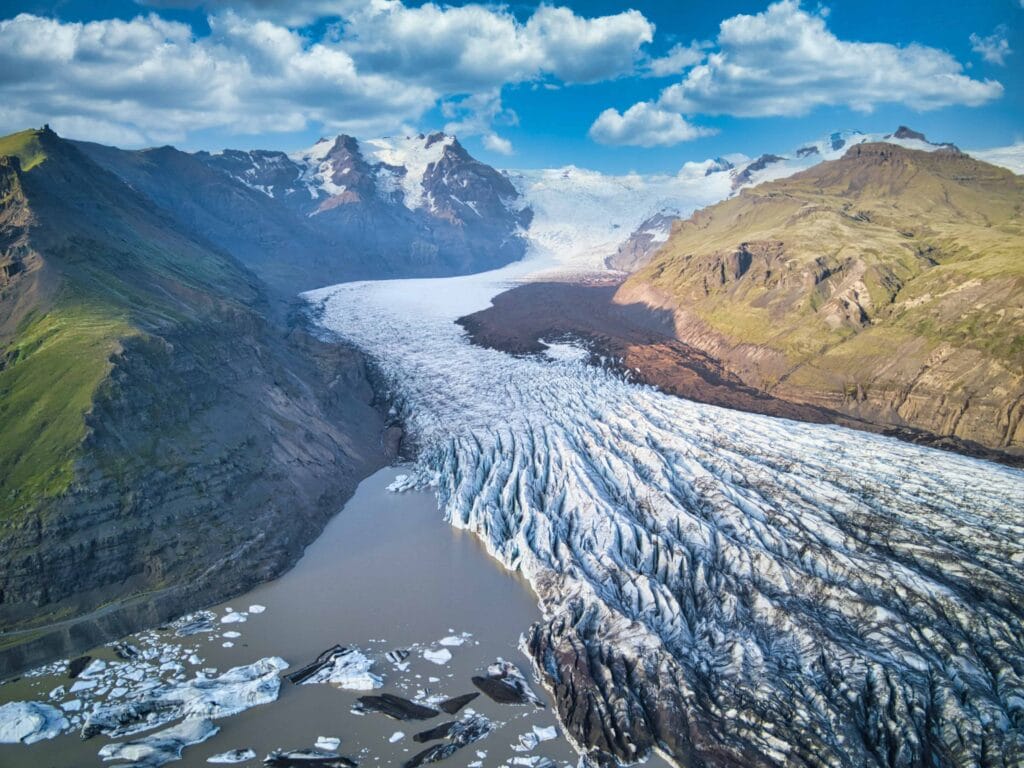
The Svínafellsjökull glacier stretches 8 km in length and 800 meters in width. The ice monster seems more awe-inspiring than the Vatnajökull and Öræfajökull glaciers. Walkers can experience sublime blue colors while glacier climbing for viewing the ice tongue. Svínafellsjökull is in the Skaftafell Nature Reserve, and the reserve was formerly a National Park.
24. Stjórnarfoss
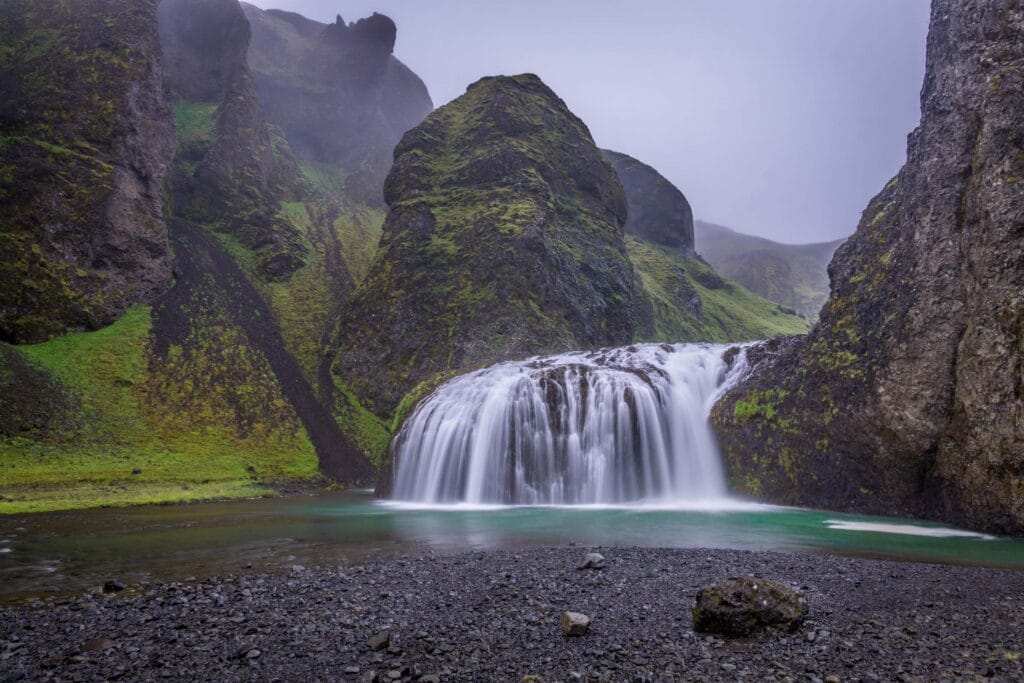
Located near Kirkjubæjarklaustur on Ring Road 1, Stjórnarfoss is famous for its waterfall and surrounding rock formations. Stjórnarfoss’s sloping water sounds and captivating surrounding landscapes make it a perfect camping and picnic spot. You can find a campsite next to the waterfall called Kleifar. On warm summer days, you will find the locals jump in the waterfall for a swim. The water gets warmer in the evening when the sun has been shining all day.
25. Dverghamrar
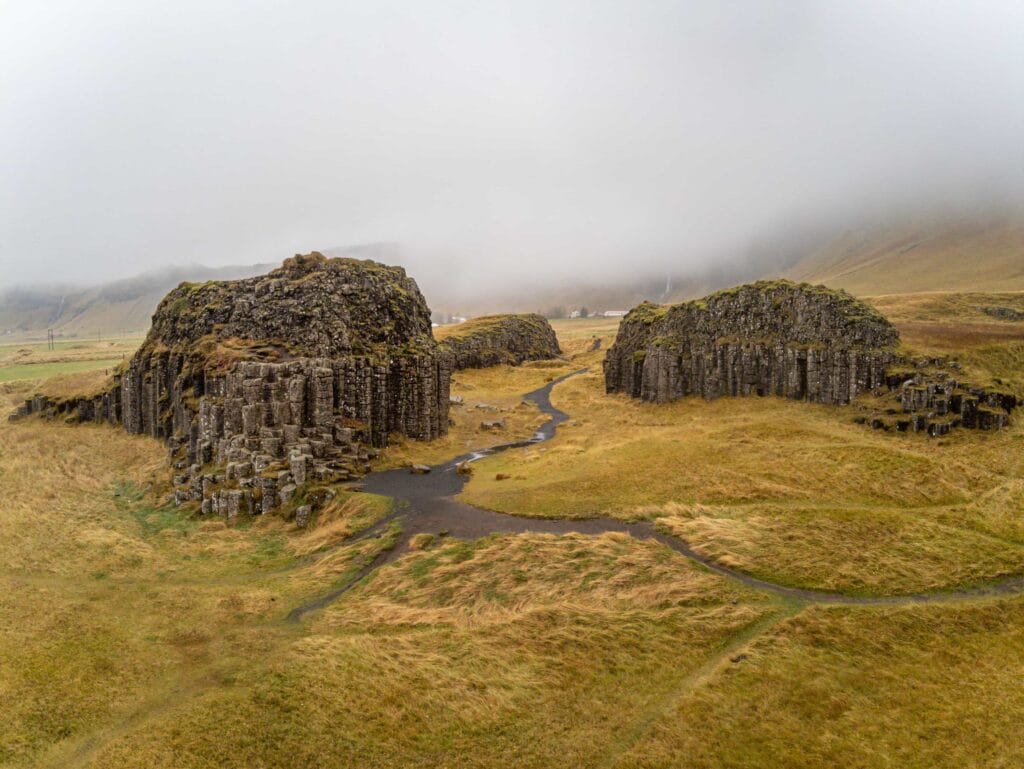
A basalt column formation, Dverghamrar, a.k.a. The Dwarf Cliffs, lies 10 km east of Kirkjubæjarklaustur village. The hexagonal basalt cliff columns also have horseshoe-shaped cube-jointed basalt at the top formed during the ice age and associated with folklore. The columnar basalt is a result of cooled lava flow and the building of contraction forces. When you stand at Dverghamrar you can see Foss á Síðu between the cliffs.
26. Fossálar Waterfalls
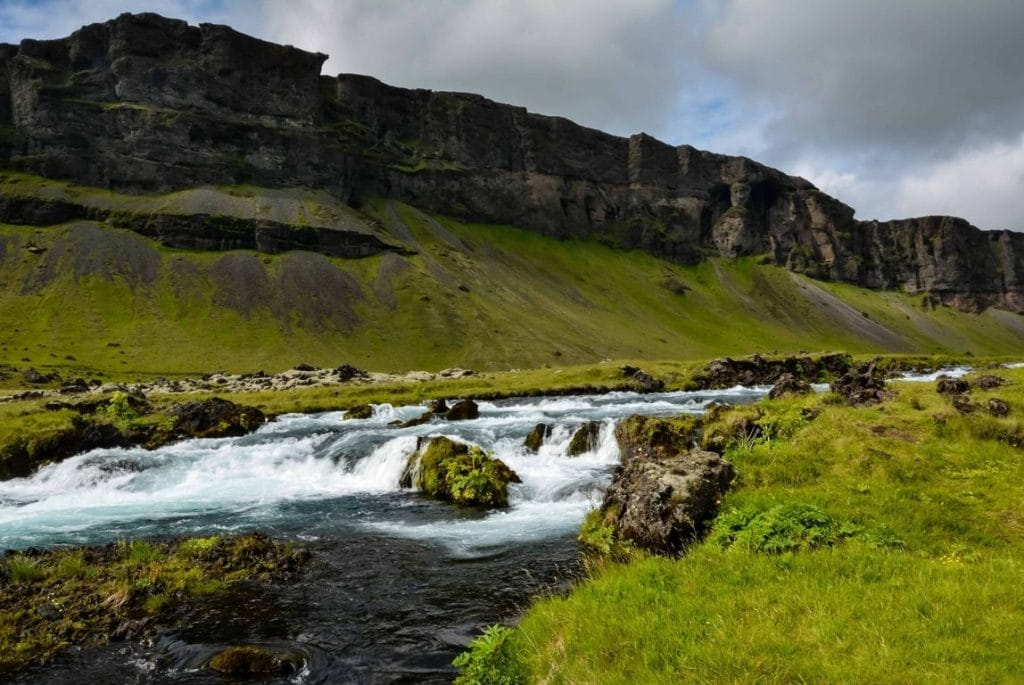
A lesser-known Icelandic waterfall, Fossálar, is captured around geological foundations that seem like a landscape painting. The eye-capturing sight lies 16 km east of Kirkjubæjarklaustur. The waterfall is located a few meters from the Ring Road so you will see them as you drive along the road. You can adore the scenic view of a gentle and tumbling cascade through the gigantic cliffs. The graceful cascade and Fossálar river are easy to reach by walking from the nearby parking lot. However, the sight is not well marked and the parking lot is very small.
27. Vestmannaeyjar / Westman Islands
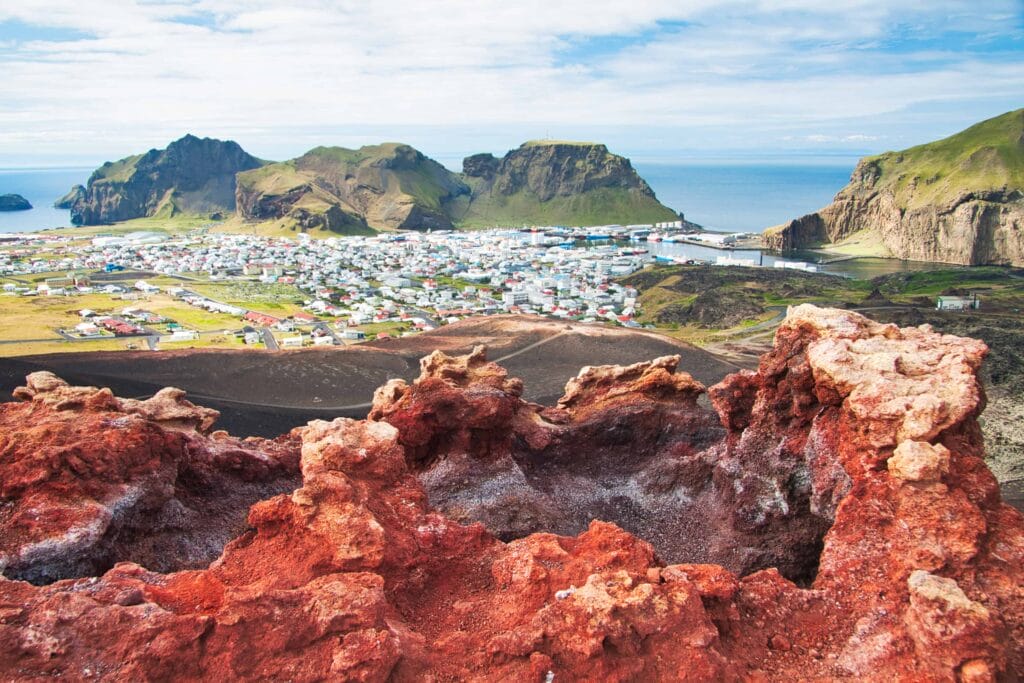
Vestmannaeyjar is a volcanic island located just south of Iceland. Incredible natural beauty is everywhere around in Vestmannaeyjar and if you are a history enthusiast, this place will surely be of interest. The population of the island is around 4300 people. See where the eruption in Eldfell volcano happened in 1973 and forced a month long evacuation of the entire population of Vestmannaeyjar. Explore the magnificent cliffs, restaurants and see the puffins in their natural environment.
GOLDEN CIRCLE
The famous Golden Circle tour takes you through promising south Icelandic destinations like waterfalls, Geysir, a national park, and geothermal fields. The 300 km natural attraction tour is top-rated in Iceland, and excursions include activities like snowmobiling, snorkeling, helicopter rides, and hot spring bathing.
The Golden Circle is Iceland’s finest example of magnificent landscapes, geological forces, and rich culture. The route is often a precursor to South Coast exploration and Ring Road detour. The vicinity to Iceland’s capital city and visiting the most famous attractions make the Golden Circle a favorite.
The Golden Circle was named after the Gullfoss waterfalls, and the second part represents the circular route. Likewise, you can even spot a Diamond Circle in northern Iceland covering famous attractions.
28. Gullfoss
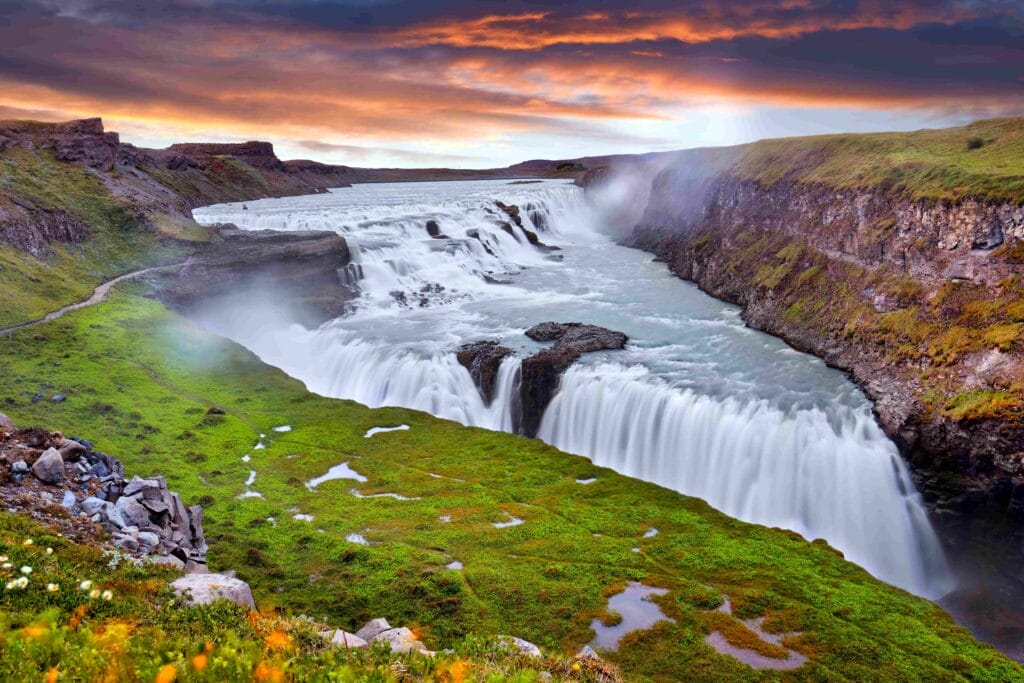
Golden Falls, a.k.a Gullfoss, is a loved Hvítá river canyon attraction with a total height of 70 meters from the Gullfossgjúfur canyon. You can drench in mighty waterfall sprays through 140 and 109 cubic meters of surging water during summers and winters. The waterfall is one of the most popular attraction in Iceland and for a good reason. The photos of the waterfall are breath taking, but it is nothing like seeing it in real life. The feel is totally different. You can even add nearby activities like Langjökull glacier and ice cave visitation or snowmobiling on the Gullfoss tour itinerary.
29. Geysir
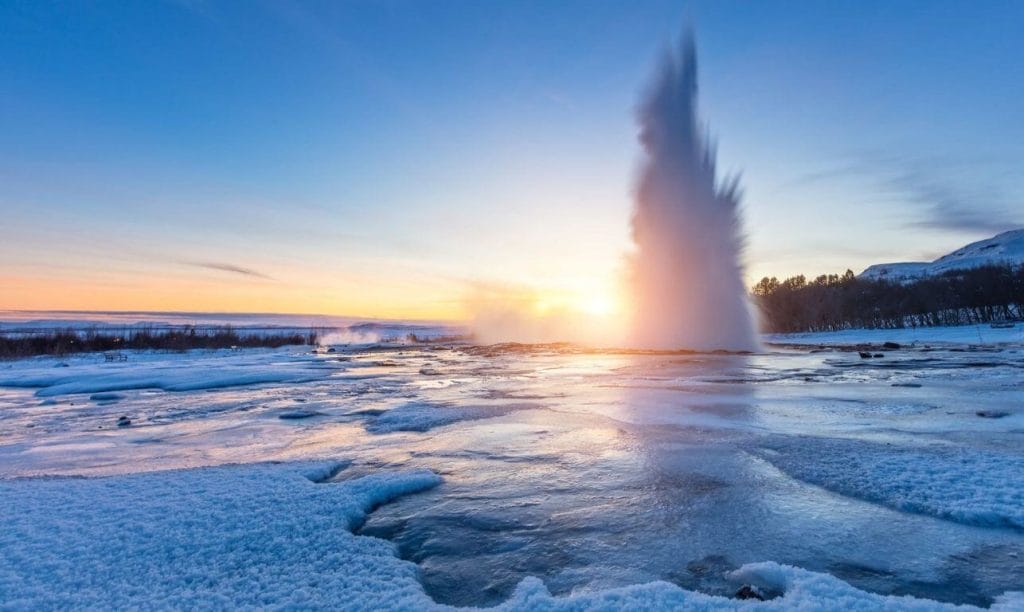
In a geothermal area called Haukadalur valley, Geysir erupts water up to 70-meters and surrounds the area with fumaroles and yellow sulphuric stains. Geysir, also known as The Great Geysir, is one of the most famous hot springs in the world. Geysir lends its name to all the geysers that are present around the world. The famous Geysir is rarely active, but the site has many hot springs, including Strokkur who erupts 30 meters up in the air every 5-10 minutes.
30. Þingvellir
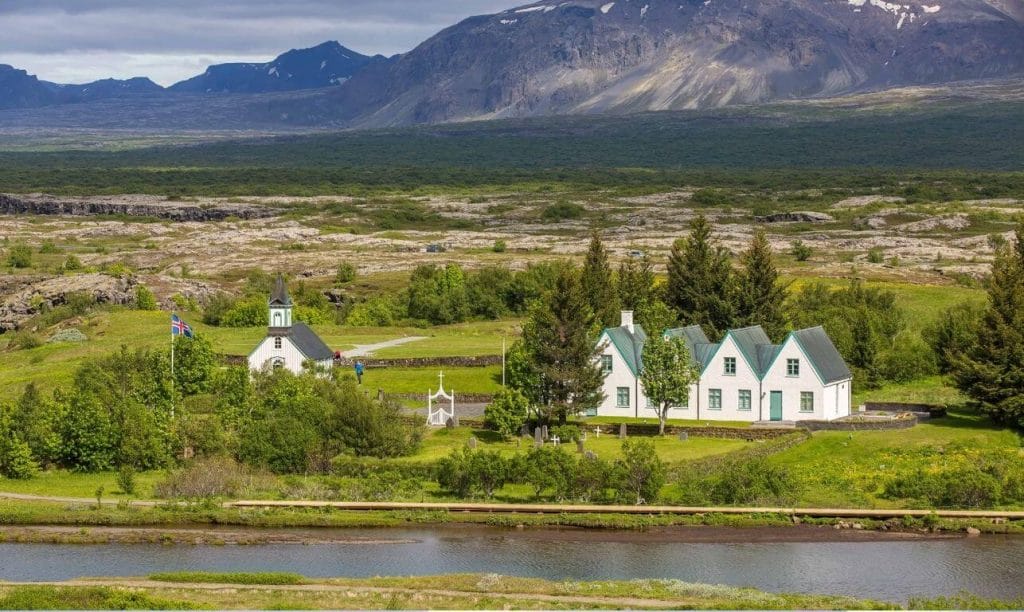
Þingvellir National Park is The Field of Parliaments also known as Alþingi, the globe’s first elected parliament through democracy, in 930 AD. In addition, the place is home to Silfra fissure where you can snorkel between the continents. Þingvellir National Park is a part of UNESCO World Heritage sites. The ground also has remains of 10th Century and 18th & 19th Century agricultural remains.
31. Secret Lagoon
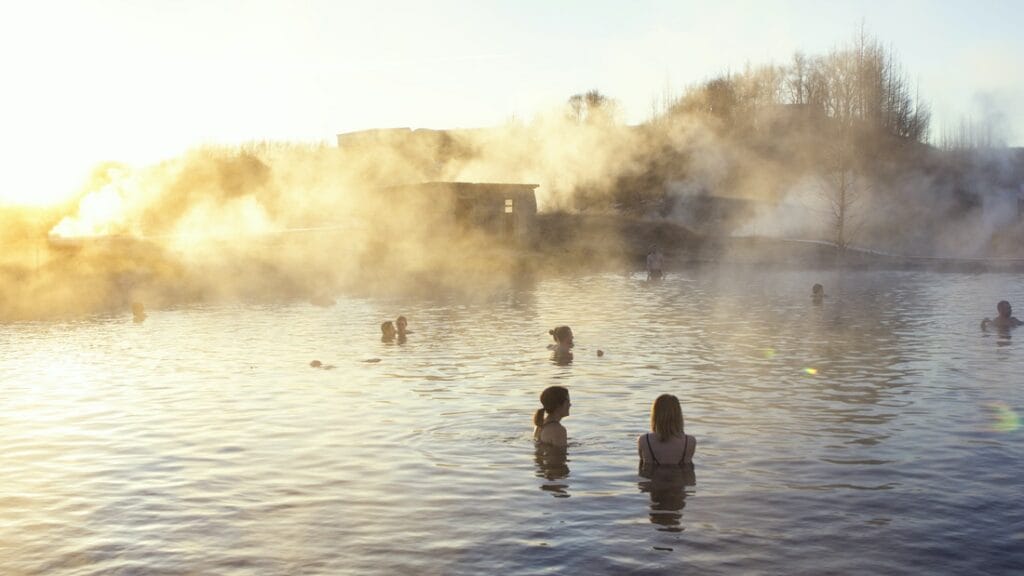
Gamla Laugin or Secret Lagoon is Iceland’s oldest swimming pool surrounded by the Hverahólmi hot springs and Flúðir villages geothermal area. The 1891 artificial pool has a water temperature of 38-40°C with visibility of erupting geyser and lava fields. Located in the Flúðir village, the Secret Lagoon receives steam from the natural hot springs.
32. Kerið Crater
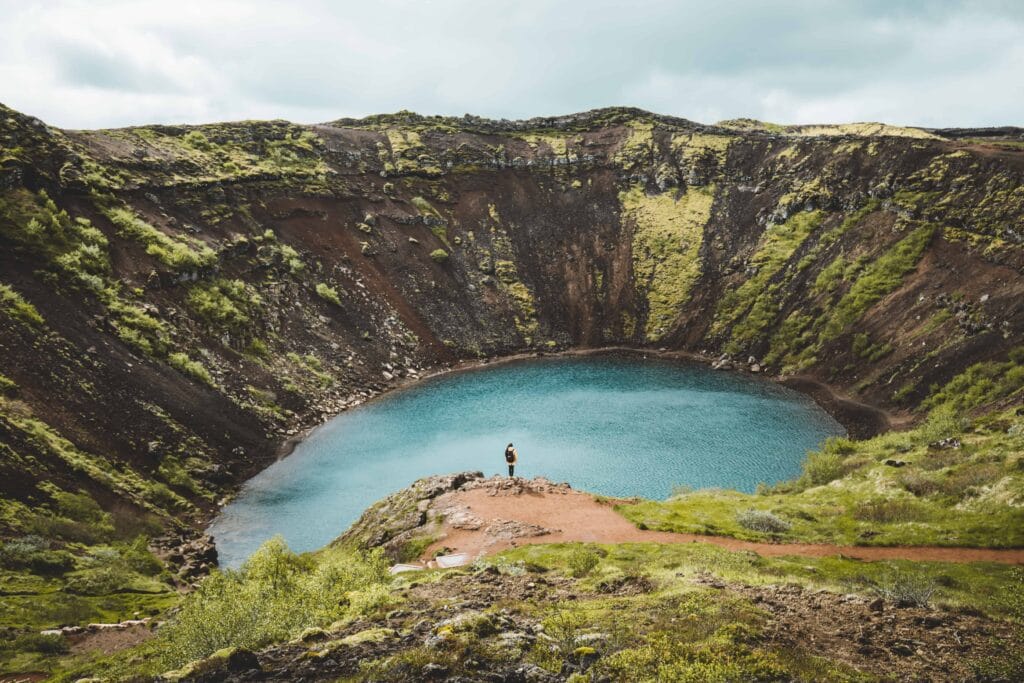
The 3000-year-old and 55-meter deep Kerið crater lies in the Tjarnarhólar area, a home for crater hills. Kerið has a bowl lake believed to rise and fall in the Mt. Búrfell, and is a natural protected site. The crater is in the vicinity of the Golden Circle attractions and appears vividly red.
33. Hrunalaug Hot Spring
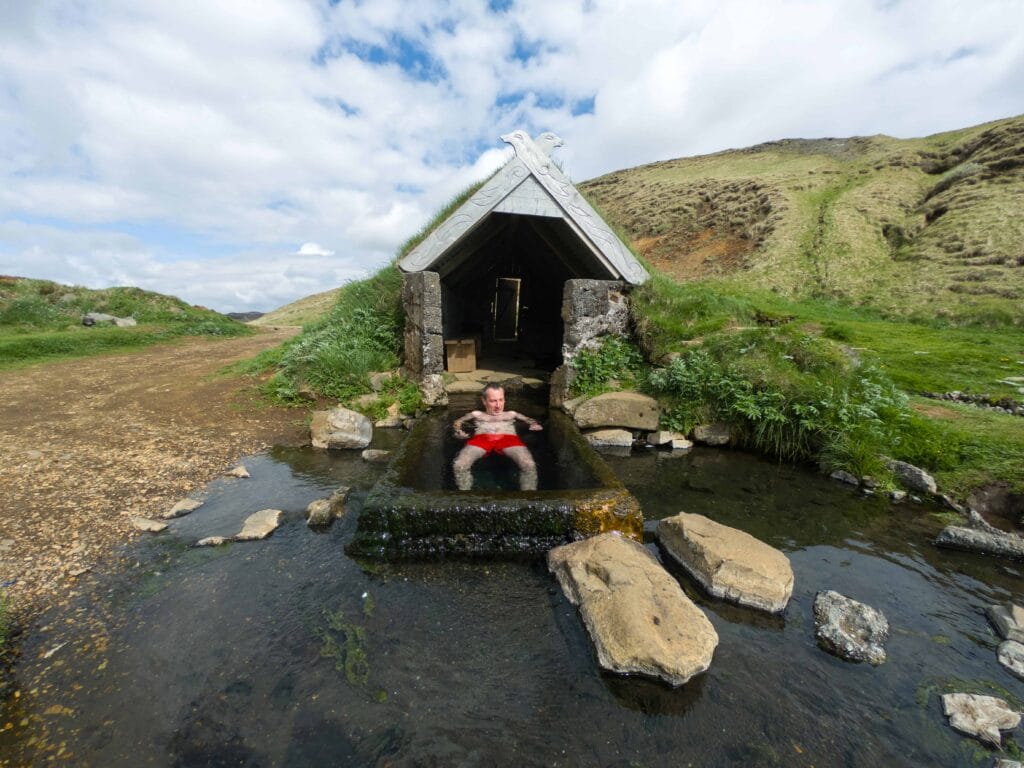
The Hruni hot spring or Hrunalaug remains open throughout the year and has a temperature of 40°C. Dramatic artificial improvements surround the eight-person capacity hot spring, and a private land attraction lies in the vicinity of the Secret Lagoon. The best time to visit the hot spring is during the early morning as it allows you to stay away from the crowd.
34. Faxi Waterfall
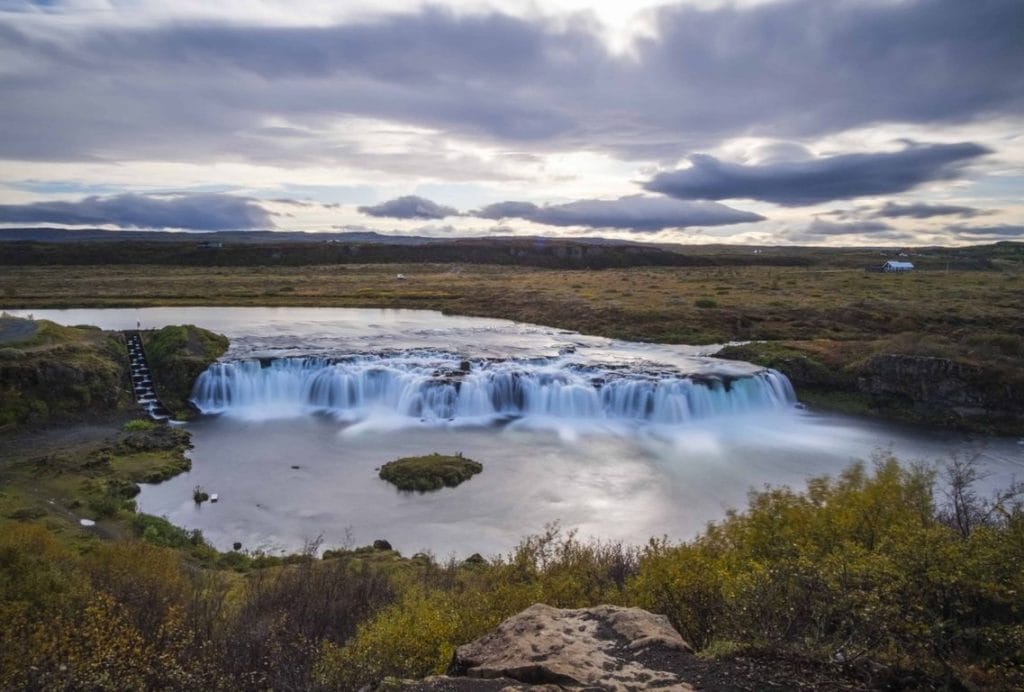
Faxi waterfall, sometimes called Vatnsleysufoss waterfall lies 12 km from Geysir and 20 km from Gullfoss waterfall. A part of the Golden Circle, the waterfall is a vast, impressive, and natural sight. You can experience the drizzle up close and even enjoy the peacefulness, unlike the Gullfoss waterfall.
35. Snorkeling in Silfra
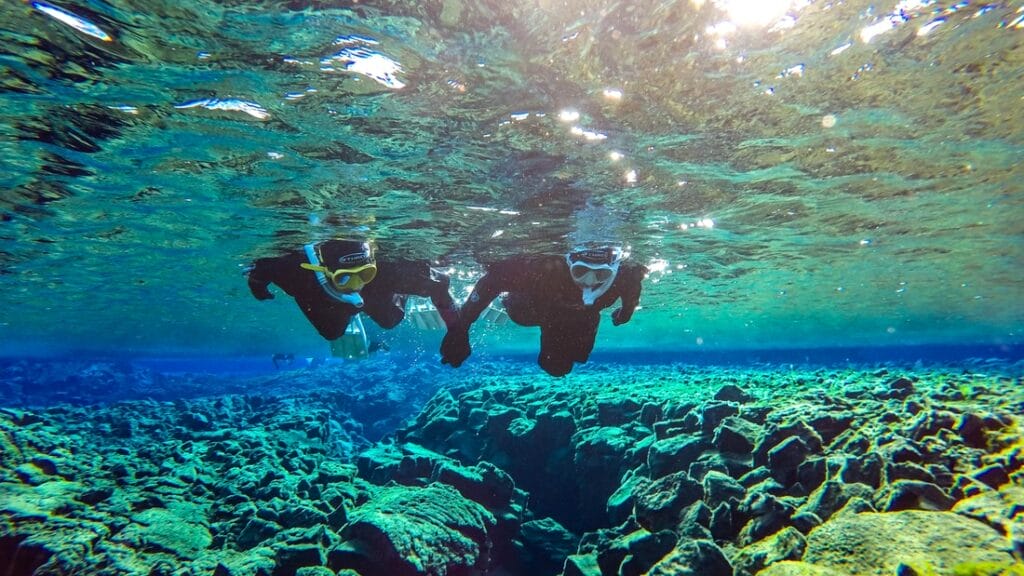
The Thingvellir National Park’s snorkeling in Silfra is one of the most famous activities that take people through glacier-like crystal clear waters and offer an experience of incredible rock formations. Silfra fissure allows snorkeling between the slowly drifting Eurasian and North American continental tectonic plates and provides an unforgettable sub-aquatic life experience.
36. Öxarárfoss Waterfall
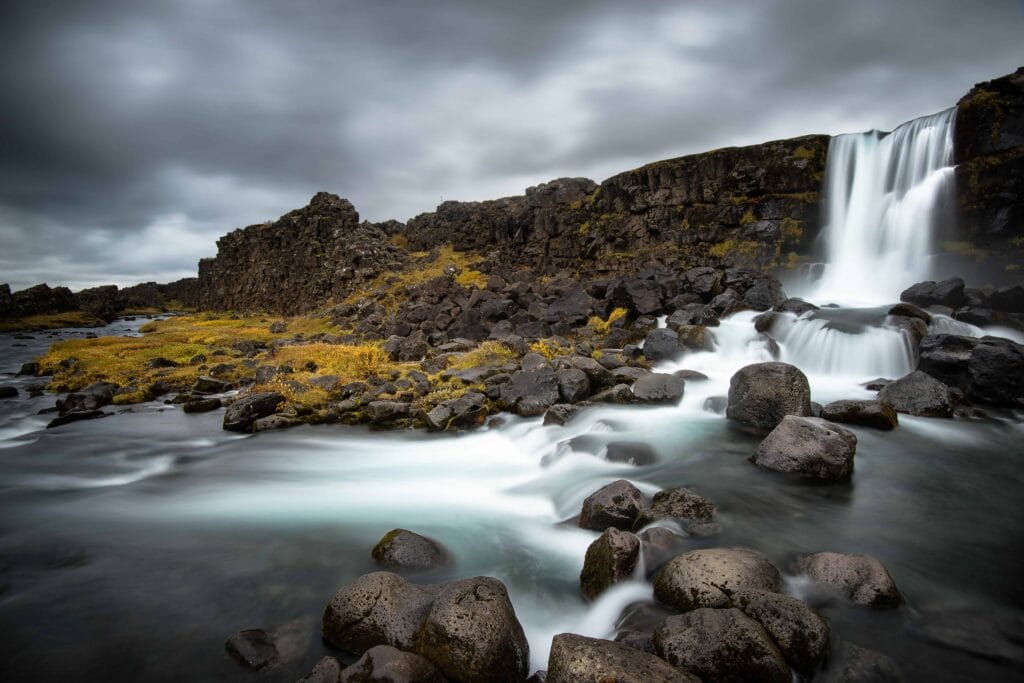
The water of the Þingvellir National Park’s artificial Öxarárfoss waterfall arrives through the Öxará river and runs towards the Þingvallakirkja church. The 44-feet high and 20-feet wide waterfall has a rock-filled base, and the water freezes during winter. The waterfall is surrounded by lava fields and the ravines of the national park. It is the ideal stop if you are visiting Thingvellir National Park.
37. Laugarvatn Fontana
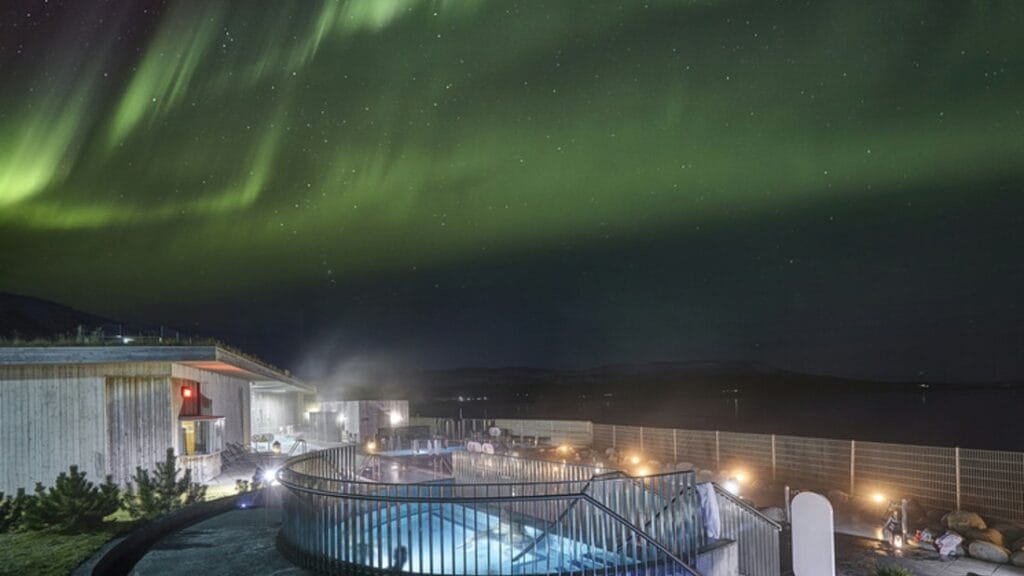
The geothermal baths of Laugarvatn Fontana are in the midst of the Golden Circle route. The geothermal springs offer a healing experience, and you even admire the natural lake pool besides steam baths with temperatures between 40°C and 50°C. Geothermal energy changes the temperature of the green beaches, pools, and streams.
EAST ICELAND
Covering approximately 22,721 square kilometers, East Iceland houses almost 16,000 people and is a peaceful and beautiful area. The site has a dramatic coastline, small villages, narrow fjords, mountains, and waterfalls. Since East Iceland is located farthest away from Reykjavik, it is not visited by travelers as much as some of the other parts of Iceland. Because of this, you will not find as many travelers at the best tourist locations and everything is more quite and peaceful.
The most significant Icelandic rhyolite foundations of Borgarfjörður Eystri with inhabited area accessibility are visible in East Iceland. The region is also known for colored mineral deposited magma chambers visible and reachable from the east coast. In addition, creatives and millennials from around the globe make it a hub for arts and music festivals.
The place is even an adventure area with activities like hiking, skiing, horse riding, and others. Filled with art history and a rich palette landscape, East Iceland has hometowns of painters like Jóhannes Sveinsson Kjarval and restores the art in a nearby museum.
38. Seyðisfjörður
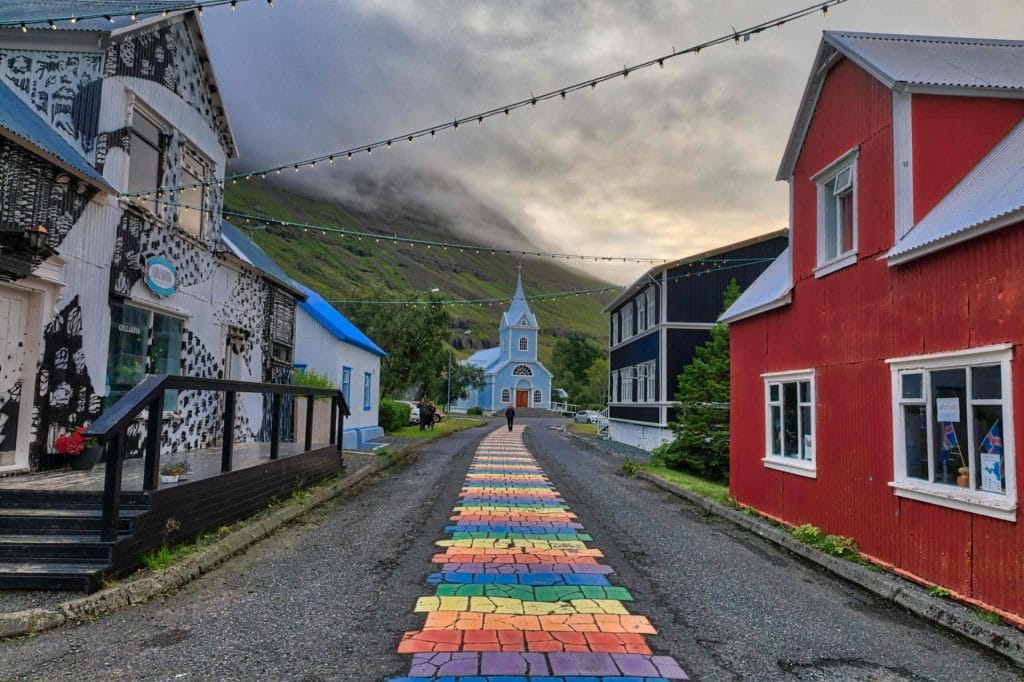
A town with 668 people, Seyðisfjörður lies in the fjord’s inner corner surrounded by waterfalls and snow-capped mountains. Prone to avalanches, the small village is 17 km from Skalanes nature reserve and was a base for Allied Forces in World War II. The ferry that comes from Europe to Iceland stops at Seyðisfjörður so it is a first stop for many travelers. Seyðisfjörður is known to be the best place in Iceland for art and you can find young artist all over the town.
39. Stokksnes
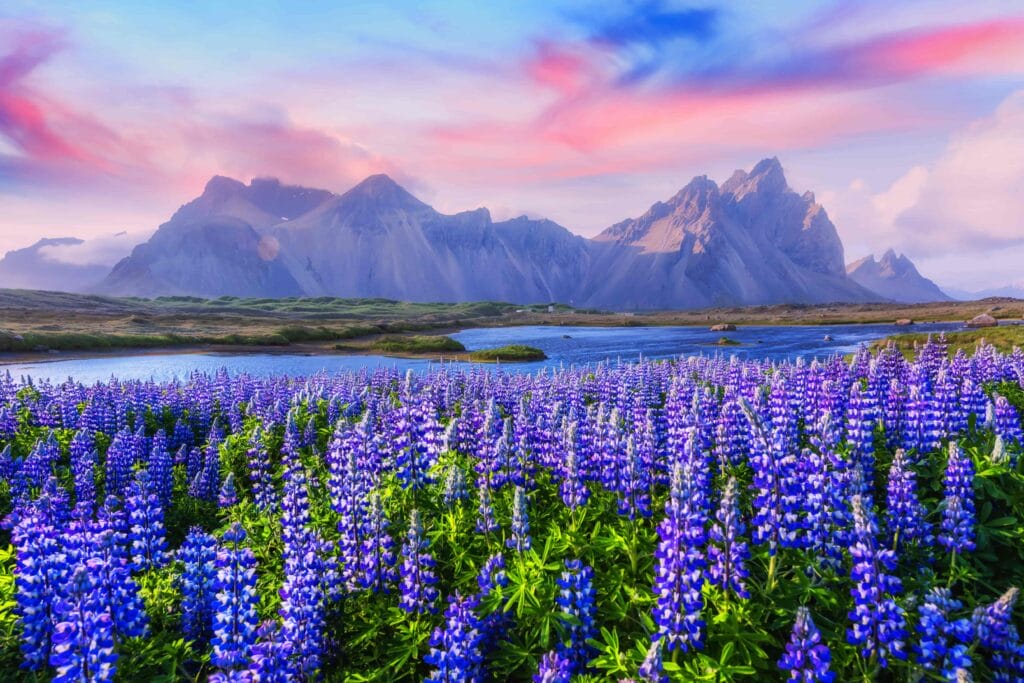
Stokksnes is home to the black sand beach at Stokksnes peninsula and Mt. Vestrahorn. The landmark is surrounded by black sea beaches, stunning lagoons, and cliffs. Lying on Mt. Kastarárfjall’s south side, the place also houses the H3 Radar Station. The Stokksnes peninsula dates back to the 9th Century and is associated with the first Horn settlement. The view from the black sand beach and over to Vestrahorn Mountain is simply amazing. It is one of the most popular location in Iceland for photographers.
40. Höfn
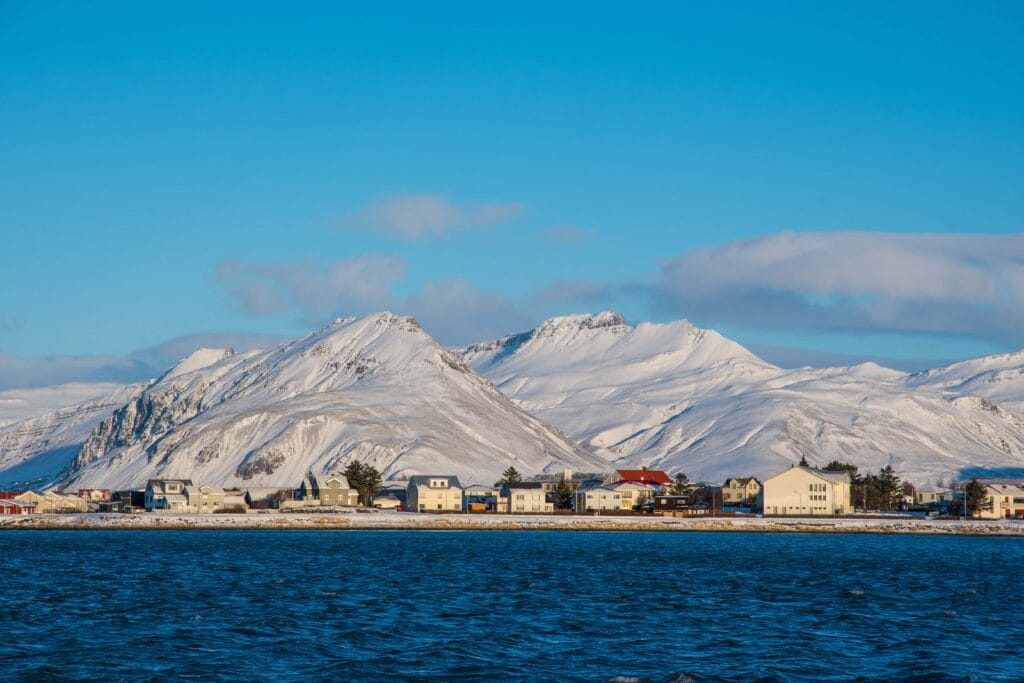
A 2,000 people fishing town, Höfn is a natural harbor located in the southest part of East Iceland. The city has three-sided ocean surroundings, and Vatnajökull glacier, the largest glacier in Europe,vlies within the town’s vicinity. The town is one of the few Icelandic places with a domestic airport.
41. Borgarfjörður Eystri
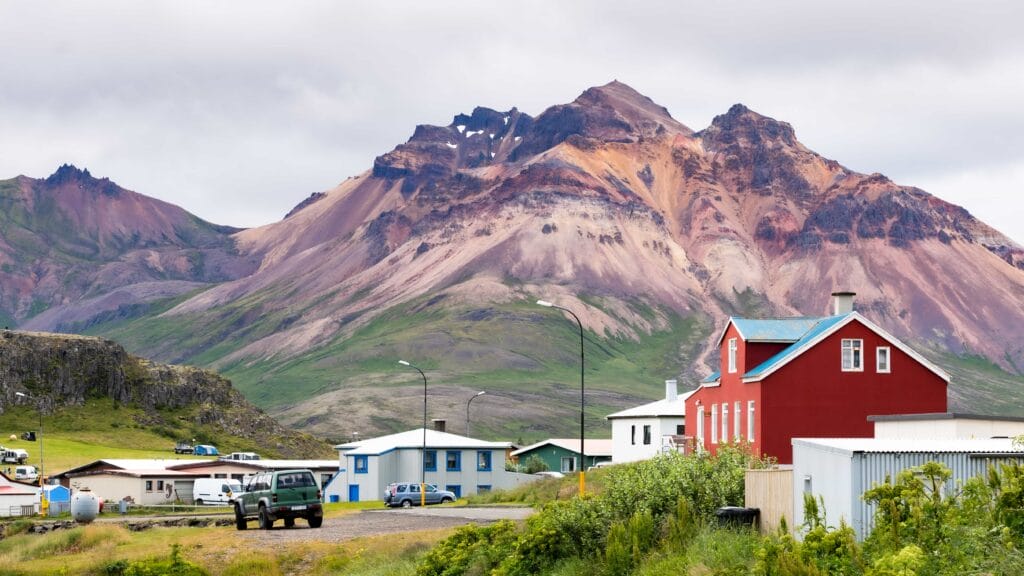
A 130 people village, Borgarfjörður Eystri is famous for fish works, fishing, and sheep farming, especially during summer. The area is even a popular hiking hotspot, especially on the Stórurð and Dyrfjöll. Braedslan music festival, has been held annually in Borgarfjörður Eystri since 2005 June.
42. Egilsstaðir
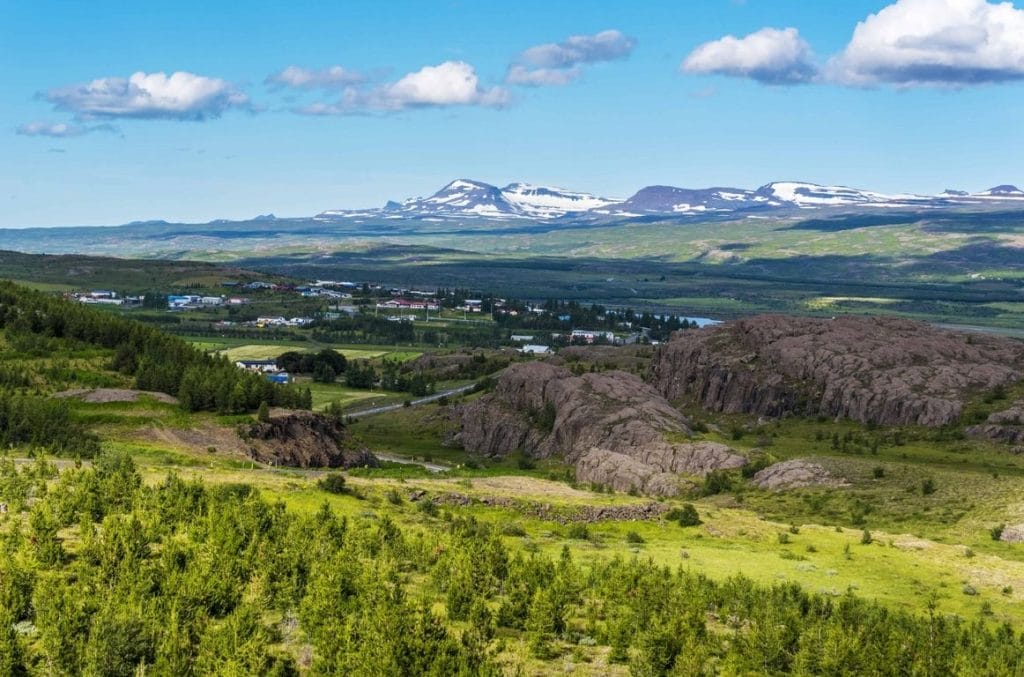
Egilsstaðir is the largest East Icelandic town with 2,464 residents. The town lies on the Lagarfljót river banks within the Fljótsdalshérað district valley. The town is near Hallormsstaðaskógur forest and Lagarfjlót lake. Egilsstaðir is a famous reindeer region and unspoiled nature. It serves as a service center for East Iceland, being the largest town in the area.
43. Hengifoss
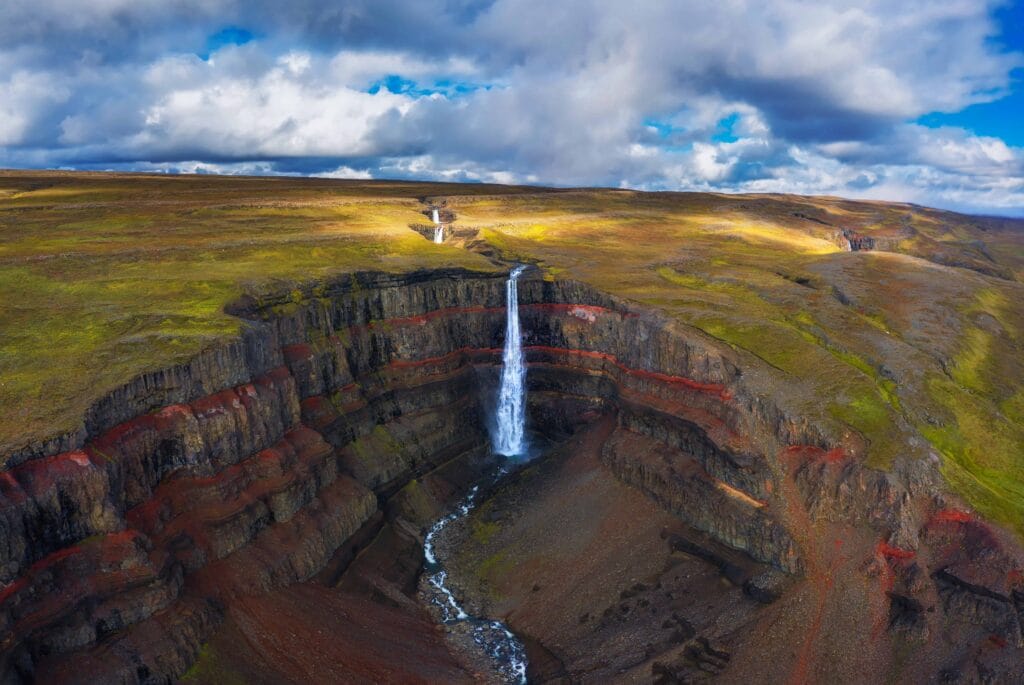
Running through the Hengifossá river in East Iceland, Hengifoss waterfall has a length of 128 feet. It is one of the highest and most beautiful waterfalls in Iceland. The waterfall trail is one of the most notable Icelandic hiking routes. Basaltic strata layers and red clay surround the waterfall. Geologists even discovered that the layers have fossilized trees that showcase evidence of warmer tertiary periods.
44. Litlanesfoss
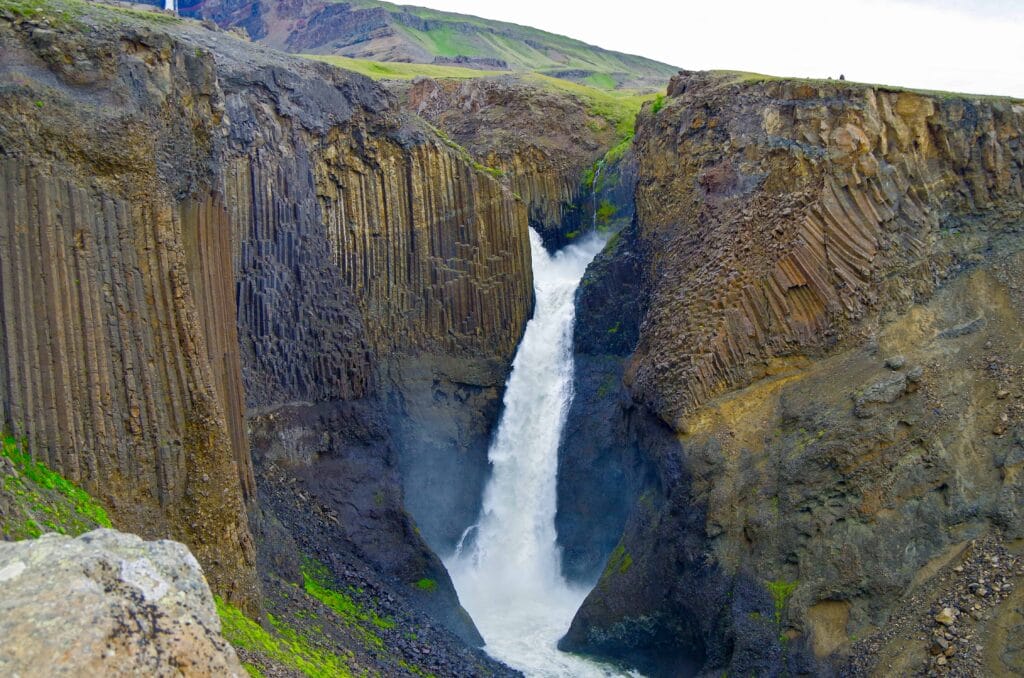
Found on the Hengifoss trail, Litlanesfoss is a two-tier waterfall with a length of 30-35 meters. The waterfall is also known as Stuðlabergsfoss because it is surrounded by 20-meter high basalt columns and is hidden from the hiking trail. Litlanesfoss, a.k.a, Basalt Column Falls, are renowned for these marvels.
45. Folaldafoss
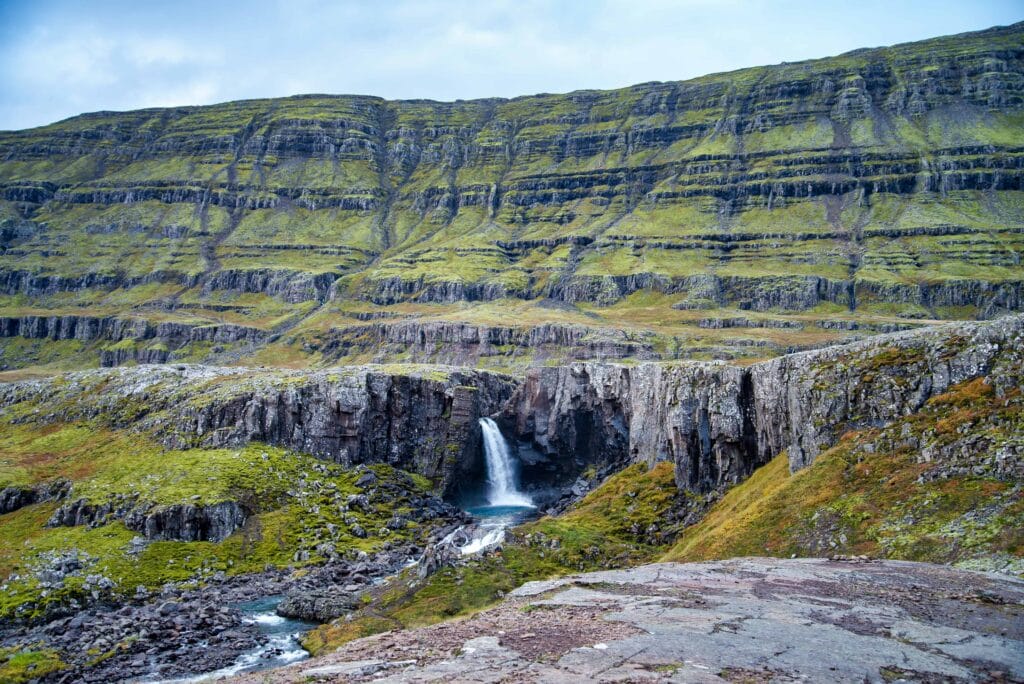
Folaldafoss waterfall is a hidden waterfall in East Iceland. The waterfall has a 20-meter drop and is visible from the main road over Öxi. A quick walk towards the attraction from the parking lot takes you into a serene environment of Icelandic scenery with high cliffs and Route 939 landscapes. The waterfalls divert the water of the southern flowing stream almost northwards and land in an attractive pool.
46. Fauskasandur

A hidden black sand beach, Fauskasandur is a perfect stop for self-drivers. The black sand beach in East Iceland is renowned for green top standing monolith with a demeanor colored in black and a massive rock amid the ocean. The dark black sand, stone, side basalt rocks, and sea create a glimmering contrast.
47. Rjúkandi Waterfall
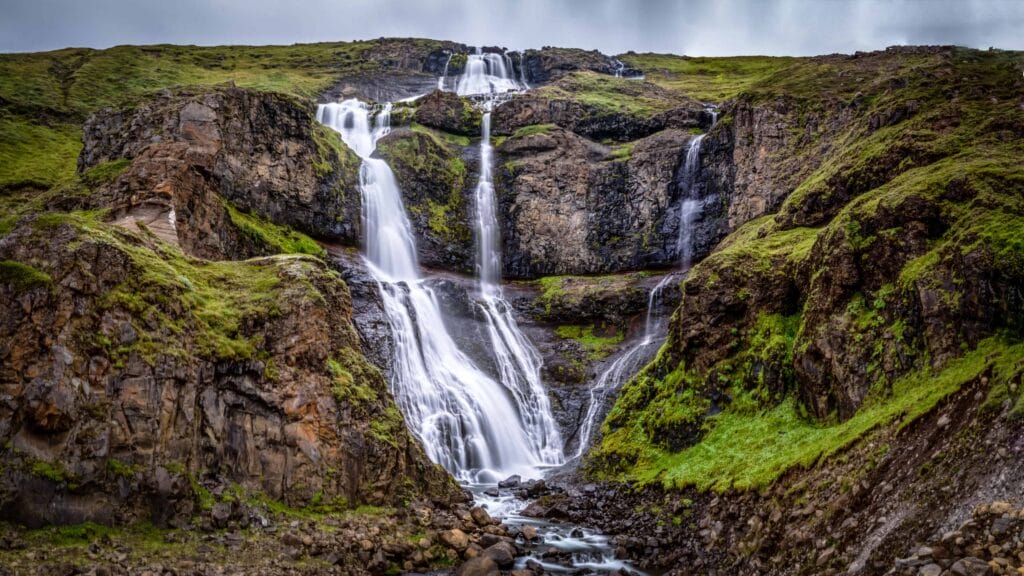
The Jökuldalur valley’s Rjúkandi waterfall offers geological uniqueness and receives water from Jökulsá á Brú river harnessed through the Kárahnjúkar Dam project. The water falls 305 and 109 feet drops surrounded by greenery make a picturesque view.
48. Stuðlagil Canyon

Stuðlagil Canyon has become one of the most popular location in Iceland in the recent years. And for a good reason. This magical place is on top of every photographers list. The basalt columns light up in the sun and the water streaming below is simply beautiful.
NORTH ICELAND
Contrasting North Iceland has peninsulas, mountains, lava fields, smooth hills, and curved rivers. The northern coast also showcases lush vegetation, vicinity to the arctic circle, awe-inspiring midnight sun, and other barrens. The natural marvels spread through unpopulated and vast areas.
The Diamond Circle is one of the most significant routes beginning from the Akureyri port, covering the glacial canyons, powerful European waterfalls, and the Mývatn lake. You can even view shores with unrecognizable volcanic landforms.
Whale watching is best experienced in north Iceland, and the tours take on picturesque journeys of the North Atlantic cetaceans. However, one of the most commonly missed places is the Árskógssandur’s beer spa located in a community on the Eyjafjörður Fiord shores.
49. Goðafoss
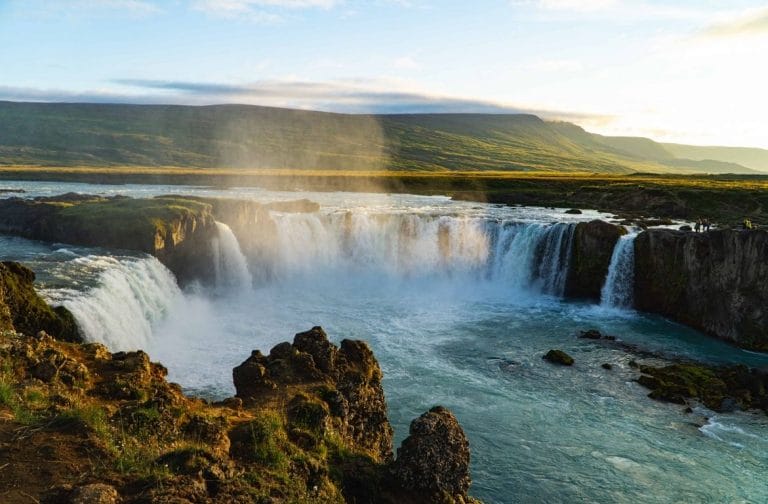
Situated near the Skjálfandafljót river, the Goðafoss waterfall has a 12 meet drop and 30-meter width. Formerly referred to as “God’s waterfall,” Goðafoss has become a part of the Diamond Circle close to the Mývatn lake, Ásbyrgi canyon, and other landmarks.
50. Akureyri
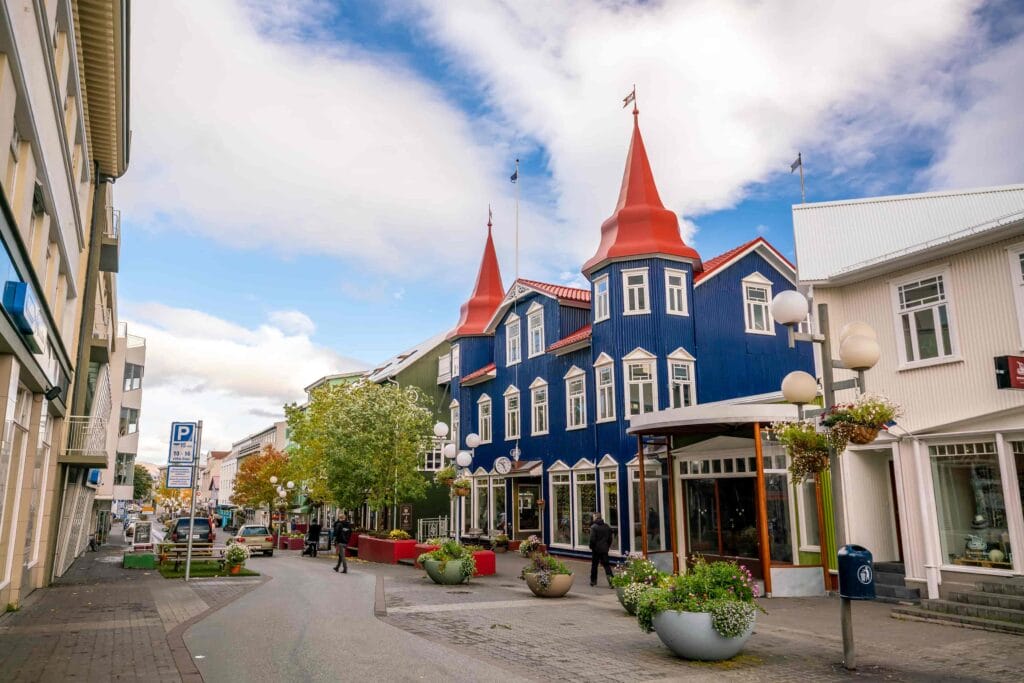
Northern Iceland’s capital and second-largest city, Akureyri, is home museums, art exhibitions, restaurants, local residences, and green spaces. You can enjoy activities like horseback riding, whale watching, dipping in a swimming pool, and Northern Lights hunting from Akureyri.
51. Mývatn
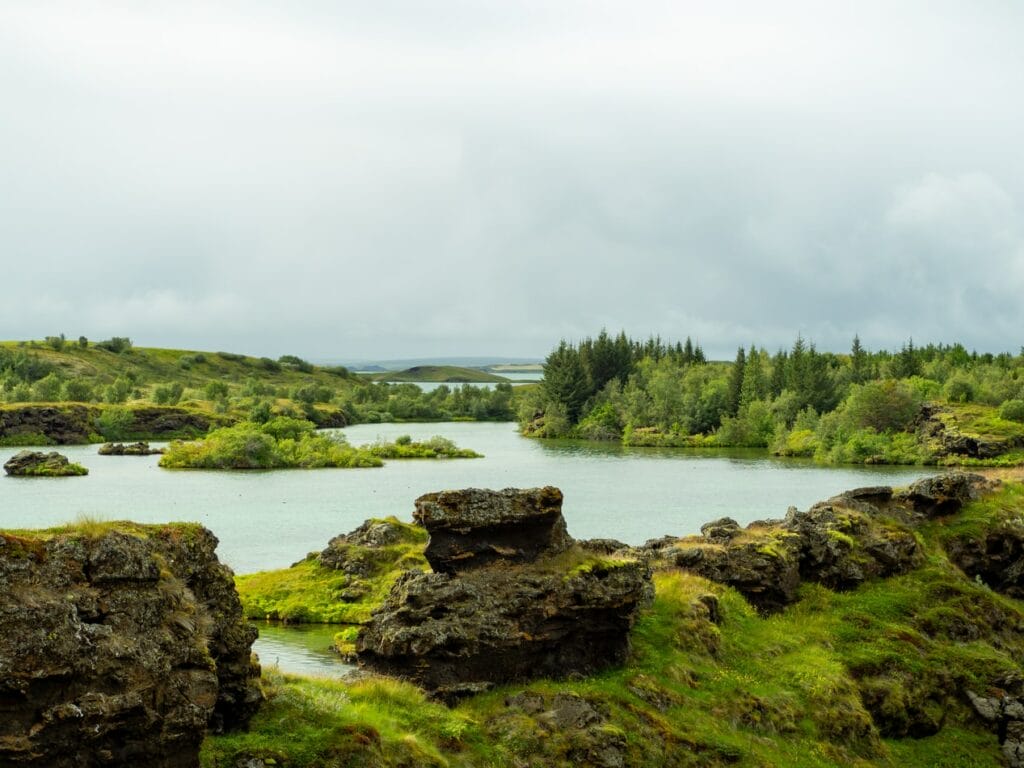
A natural lake surrounded by a small northern island, volcanic activity, and birdlife, Mývatn is a sight for sore eyes. The attraction is a nesting ground for thirteen duck species and is located below a water surface and on an active geothermal area.
52. Krafla

Situated on the northern side of Mývatn lake, Krafla caldera is an explosive volcano with 29 eruptions since settlement. The caldera is known for 90 km fissure zone extensions and has a peak height of 818 meters, and lies in the vicinity of Ásbyrgi horseshoe structured canyon.
53. Dettifoss

A 45-meter drop and 100-meter width represent the Dettifoss waterfall. You can enjoy a walk through the easy paths leading to the promenade. Dettifoss is the most powerful waterfall in Euorpe.
54. Mývatn Nature Baths
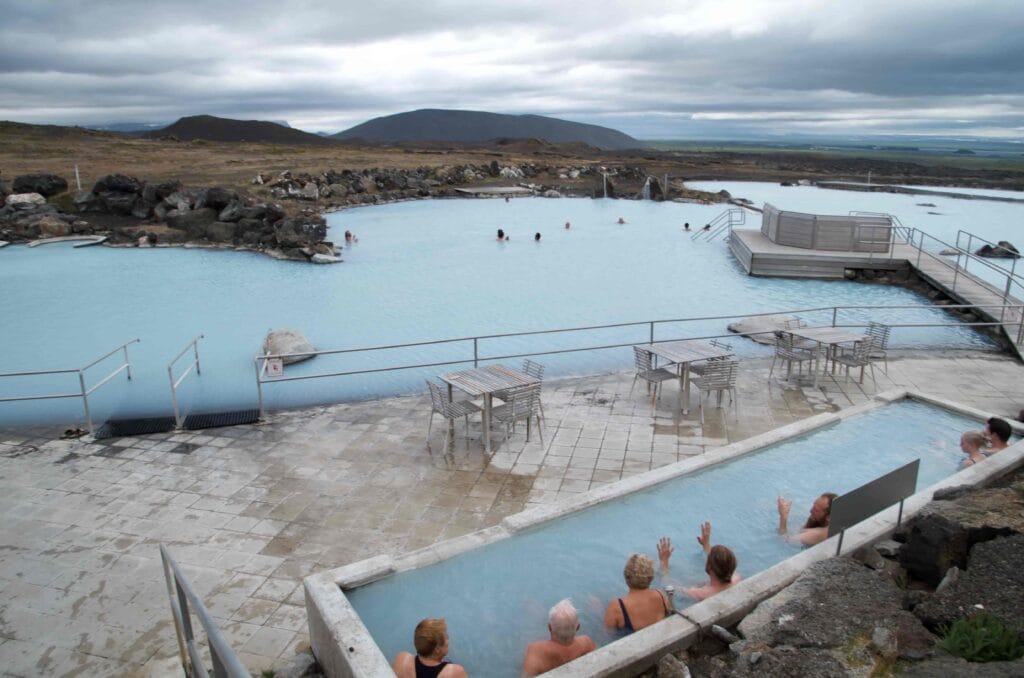
Experience the magic of northeastern Icelandic mineral water at Mývatn Nature Baths, a.k.a. Northern Blue Lagoon, located along the Ring Road. Get soaked in spring steam baths colored in turquoise blue and 36-40°C with surreal surroundings and invisibility inside the water due to high mineral density.
55. Hverir / Námaskarð

Northern Iceland’s Hverir/Námaskarð is a geothermal area situated on the east side of Mývatn lake. Get a view of boiling mud pots, smoking fumaroles, colorized sulfur crystal surroundings, geothermal acidic soil, and egg smell. Hverir is next to hiking spots Mt. Námafjall and Námaskarð pass.
56. Grjótagjá
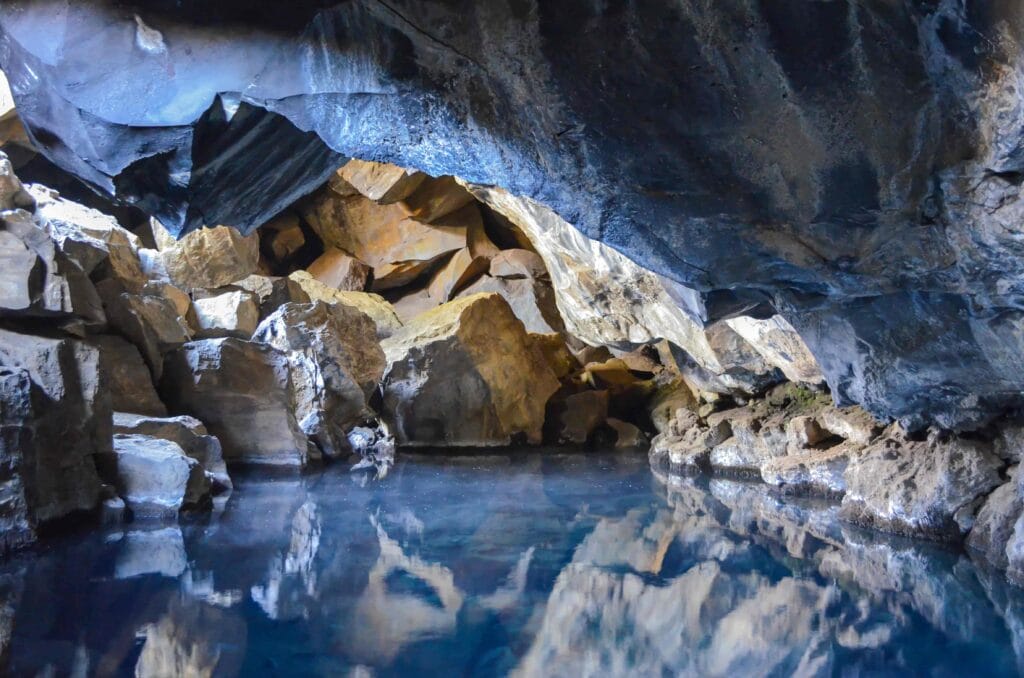
Located near Mývatn lake is a small lava cave named Grjótagjá, famous for its geothermal hot springs within its depth. The 18th-century landmark is no longer a bathing hotspot but televised in the Game of Thrones TV series. A rocky path beginning from Dimmuborgir leads to the cave.
57. Siglufjörður
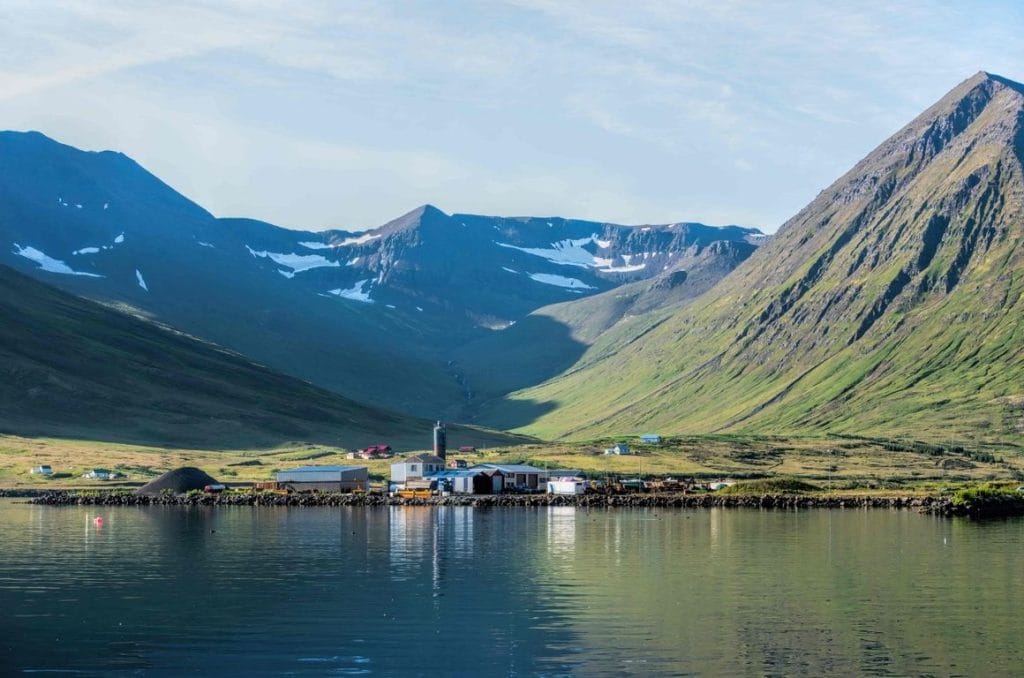
A 1,300 resident northernmost town, Siglufjörður hosts the best harbors of the country. It is home to folk music festivals, 18 bird species, Herring Era Museum, and the Grana factory. The early 20th-century town is also renowned for Hestskarð and Hólsskarð passes leading to the Hedinsfjörður fjord.
58. GeoSea
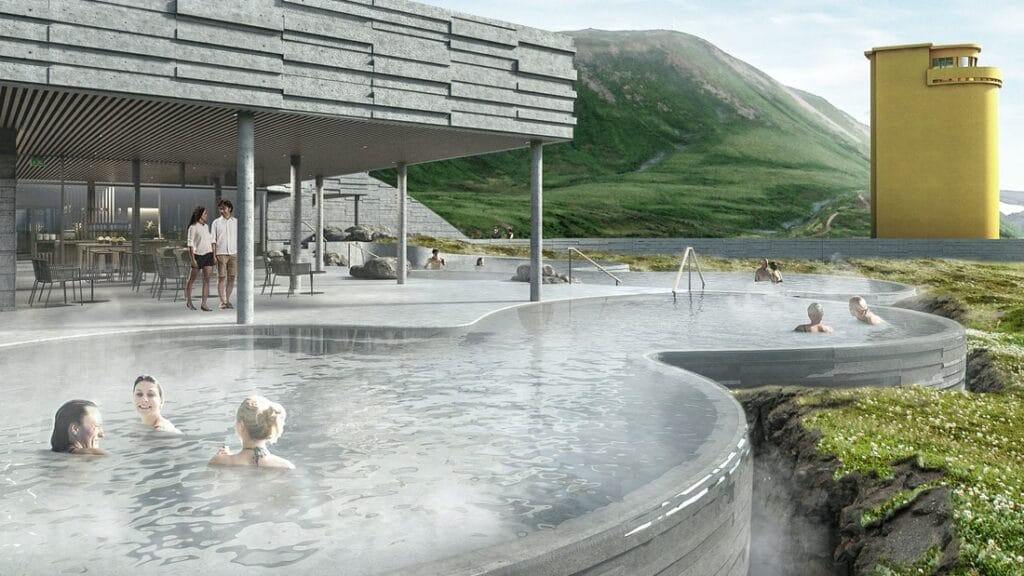
The Husavik GeoSea is a relaxing geothermal bath pool with nature’s heated seawater instead of earth bubbling freshwater. The 38 – 39°C bathing water is often a part of the Diamond Circle tour and has a view of the glistening ocean, Skjálfandi bay, and rare whale-watching experiences.
59. Arctic Henge
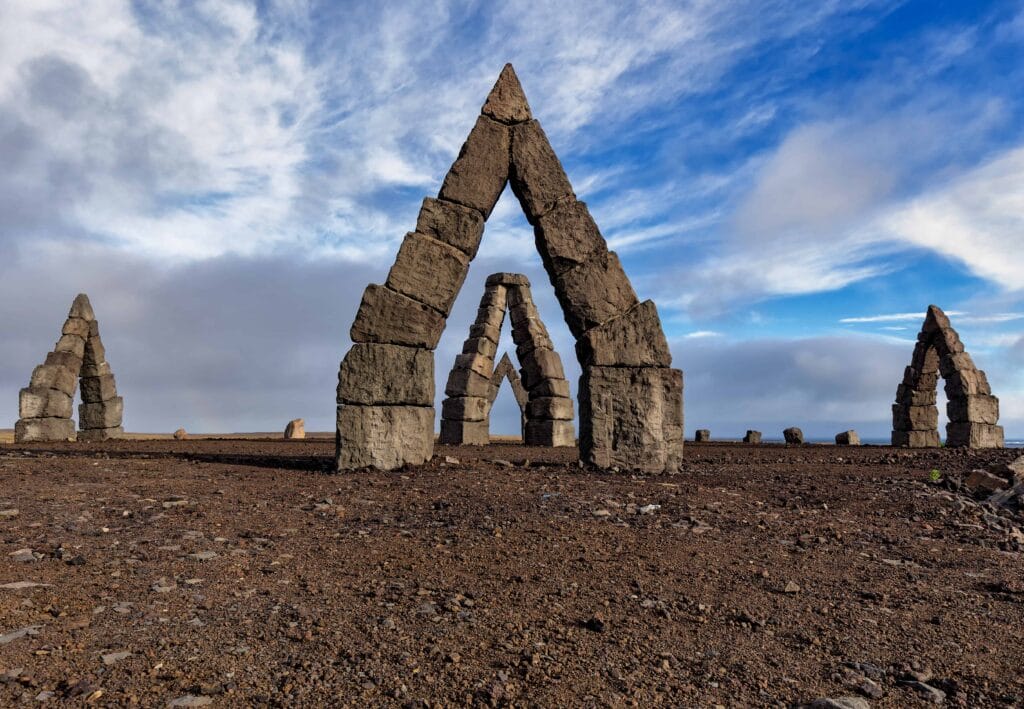
Lying off the Arctic Circle, a northernmost remote village of Raufarhöfn, is Arctic Henge, a.k.a. Heimskautsgerðið. The place is renowned for precise shadow casting and capturing light amidst gateways and sunrays with 68 huge sundial shapes or circular dwarf trails.
60. Selfoss Waterfall
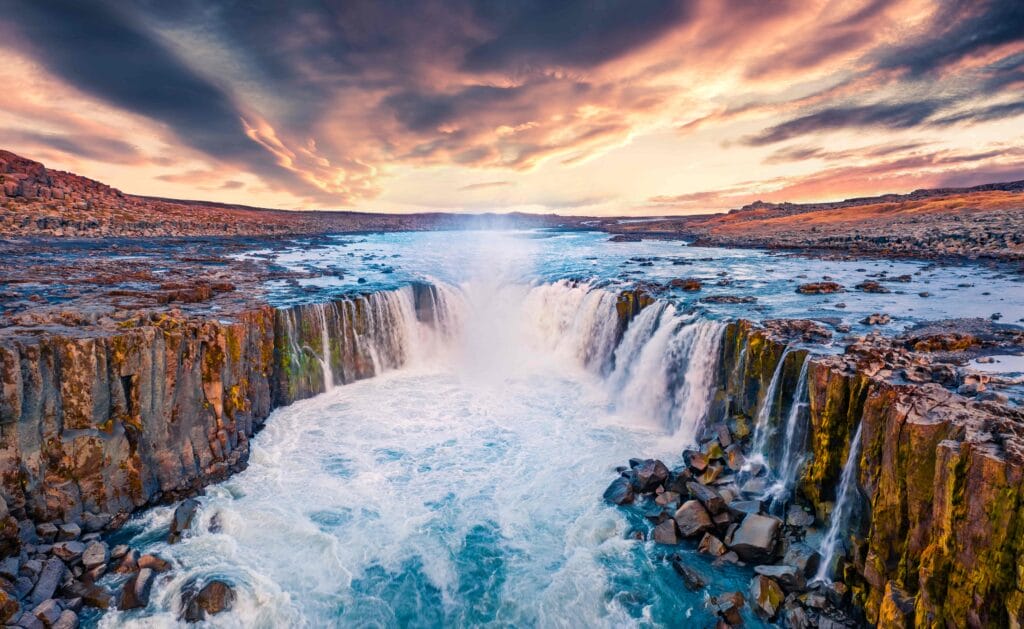
Often visited during the Diamond Beach tour, the Selfoss waterfall has a 36 feet elevation and 330 feet width. The Vatnajökull’s Jökulsá á Fjöllum glacier feeds water to the waterfall, and visitors that move close to it get wet or could slide through the slippery rocks. The waterfall is located close to Dettifoss waterfall. You can park your car at Dettifoss and hike between the two waterfalls.
61. Ásbyrgi
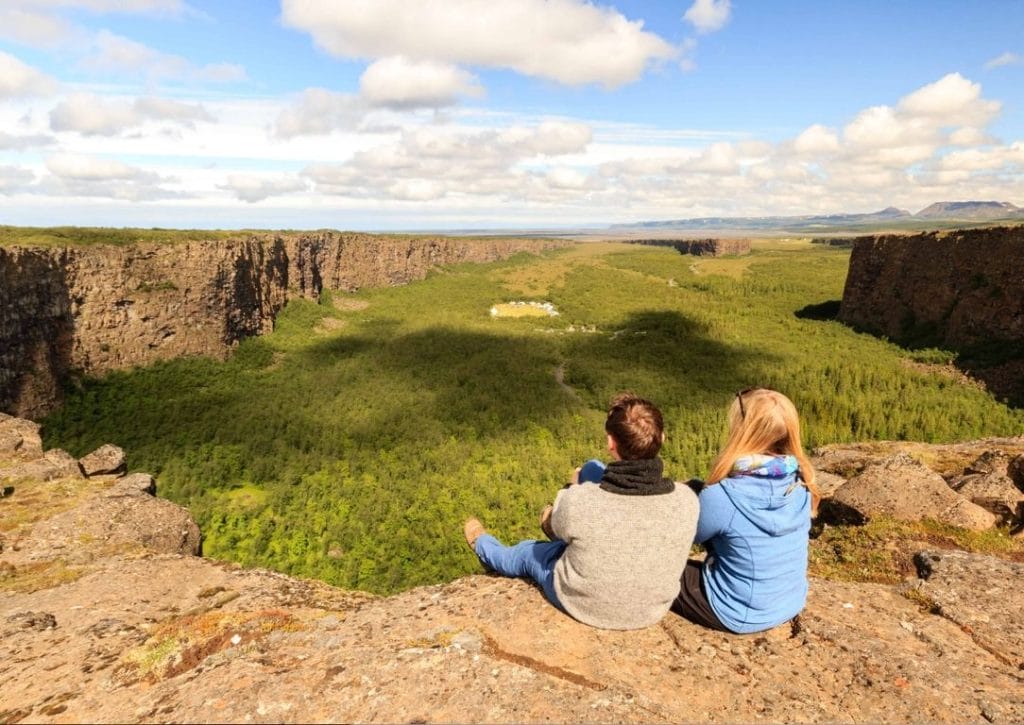
With a 3.5 km length and 1.1 km width, Ásbyrgi is a horseshoe-like canyon associated with Icelandic folklore. Located in the Vatnajökull National Park, the canyon has a 328 feet cliff face, birch woodland, and a willow underneath. Eyjan, a rock formation, is the most distinct feature of the canyon. This is one of the most unique location in Iceland and not possible to descripe in words. You simply have to visit.
62. Kolugljúfur
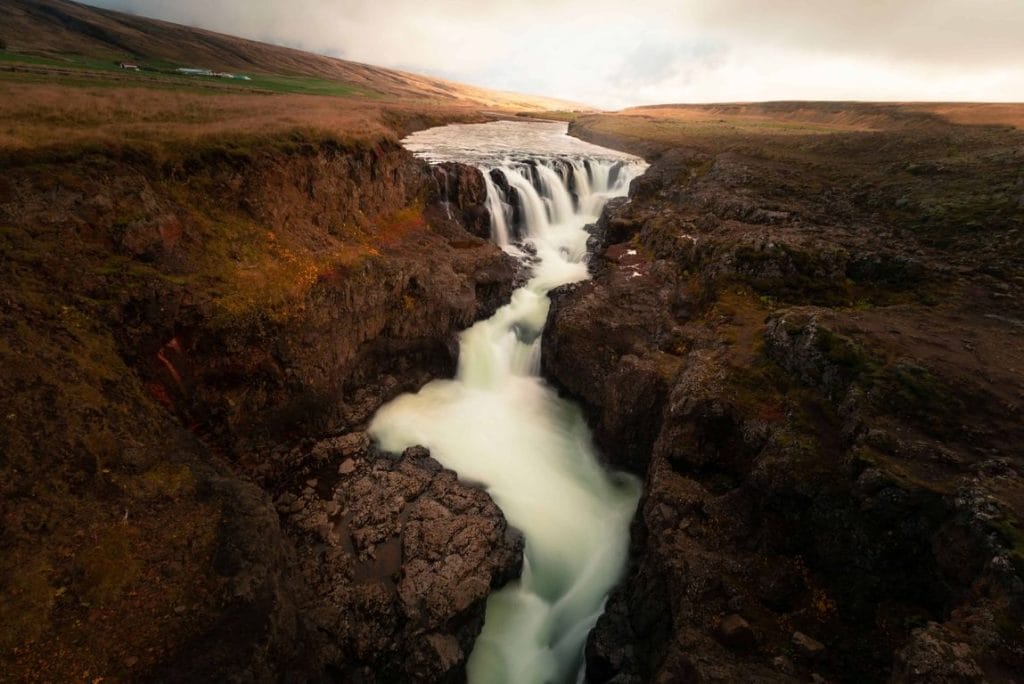
A rugged and deep gorge below the Víðidalsá river water, Kolugljúfur canyon is the pathway for the Kolufossar Falls. The valley has a length of 1 km and 197 feet width visible between the Blönduós and Hvammstangi towns through Route 715. The falls and the gorge bear the name after the historical giantess Kola.
63. Dimmuborgir

The Black Fortress, a.k.a. Dimmuborgir, situated in the Mývatn lake area, is a dramatic lava expanse. Drenches in folklore, Dimmuborgir formed 2,300 years ago and near geothermal Námaskarð Pass, Krafla fissure, and Grjótagjá hot spring cave. Walk through the lava fields and spot the trolls that are watching over you.
64. Hvítserkur
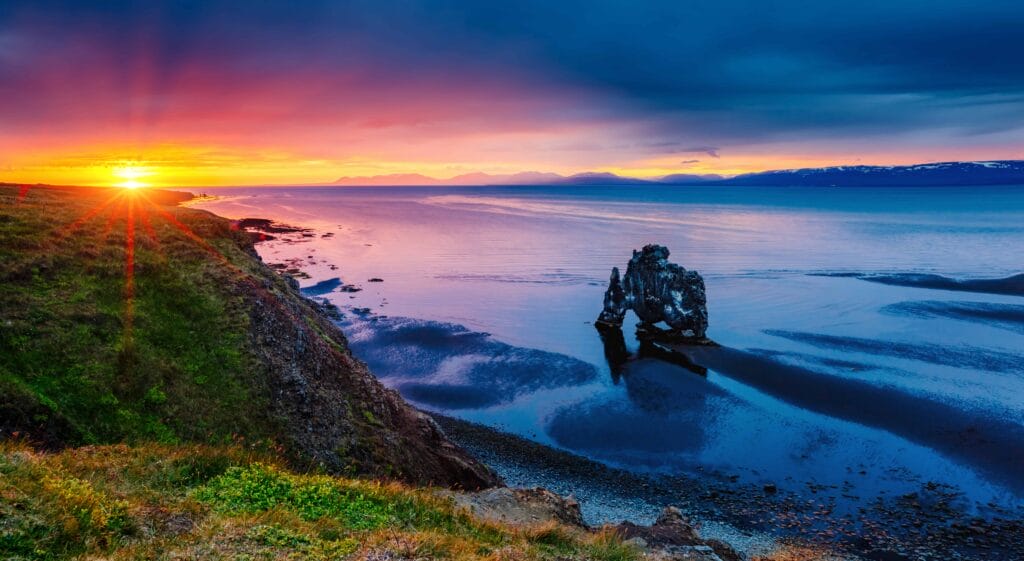
The Northwest Icelandic Troll, a.k.a. Hvítserkur, is a 49 feet basalt rock on the Húnaflói Bay. Viewable through the eastern Vatnsnes Peninsula shore, it is named after the nesting birdlife and associate with the folklore of a peninsula troll. The rock is formed through basalt column cascading waters.
65. Húsavík

A 2,000 resident town by the northern Skjálfandi Bay, Húsavík is the European whale watching capital with 100% sightings, especially humpback whales. Besides this, you can even spot blue whales, fins, white-beaked dolphins, and harbor porpoises. The place is also renowned for Húsavíkurkirkja church and Exploration Museum. Húsavík is also the town from the movie Eurovision Saga.
66. Hofsós Swimming Pool
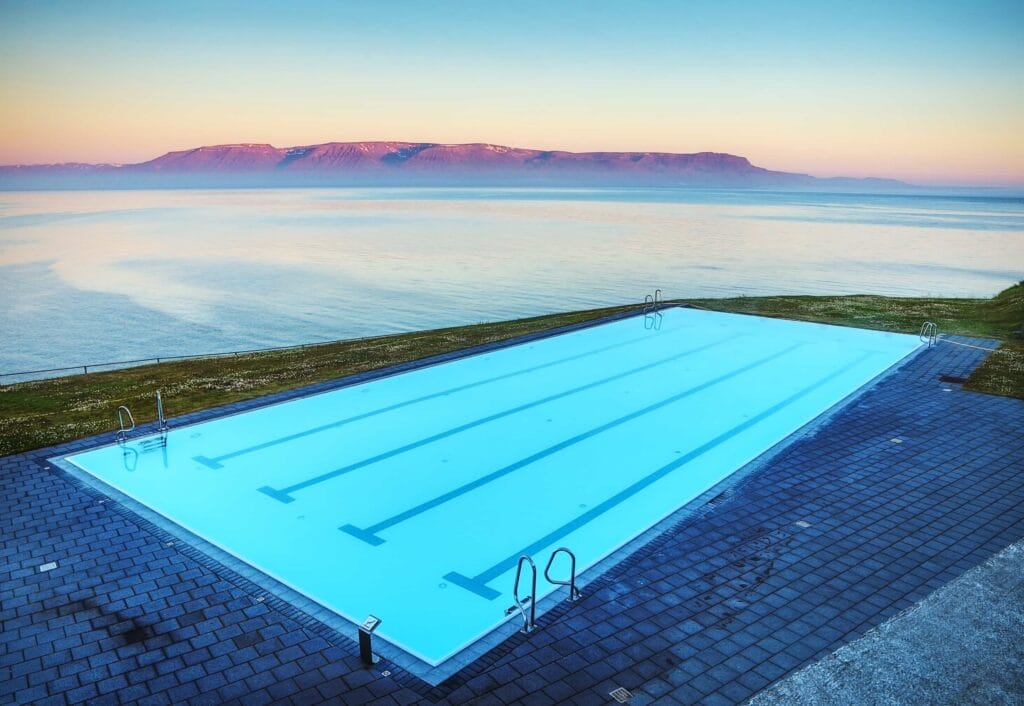
An uprising Skagafjörður attraction, the Hofsós Swimming Pool overlooks the fjord and Drangey islands. The geothermal water next to the sea edge and Staðarbjargavík basalt formations below it are noteworthy. Hofsós, on the west side of the Trollaskagi Peninsula and the opposite side of Akureyri, and often visited during Ring Road detours.
67. Grettislaug Hot Spring
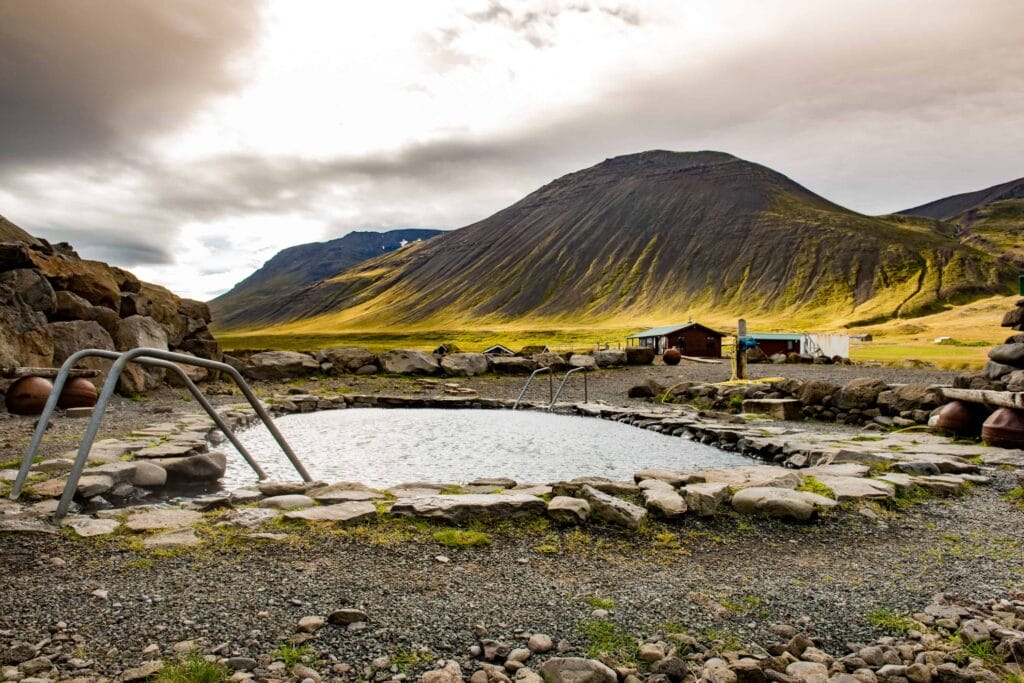
Named after the famous character Grettir in the Grettis Saga, the Grettislaug Hot Spring is on the northern Skagifjörður shores. Picturesque sea and mountains surround the hot spring with a temperature of 39°C based on private property. Grettislaug was formerly located near the Reykjalaug pool until it washed away in a storm and was rebuilt in 1992 by Grettislaug. Travelers love to bathe in this hot spring.
68. Hverfjall

Joint with the Krafla volcanic system, Hverfjall was built 2,500-years-ago and has experienced 29 eruptions. The tuff-ring-shaped volcano has a massive crater of 1 km in diameter, located near the Mývatn lake. The perfect formation crater has two strict walking paths and forbids you to take other routes.
WEST ICELAND
The west end of Iceland is Reykjavík’s capital city home and an impressive array of natural sites such as distinct lava tubes, hot springs, eye-capturing glaciers, thrilling waterfalls, historical treasures, and more. Although the Reykjanes Peninsula and Westfjords also lie in the west, they are part of other Icelandic regions.
West Iceland is reachable via Reykjavik using a 6 km tunnel beneath the Hvalfjordur fjord; however, explorers can even take a scenic Hvalfjörður bay’s one-hour route. This pathway takes you through an extensive birch forest and Glymur waterfalls.
69. Glymur Waterfall
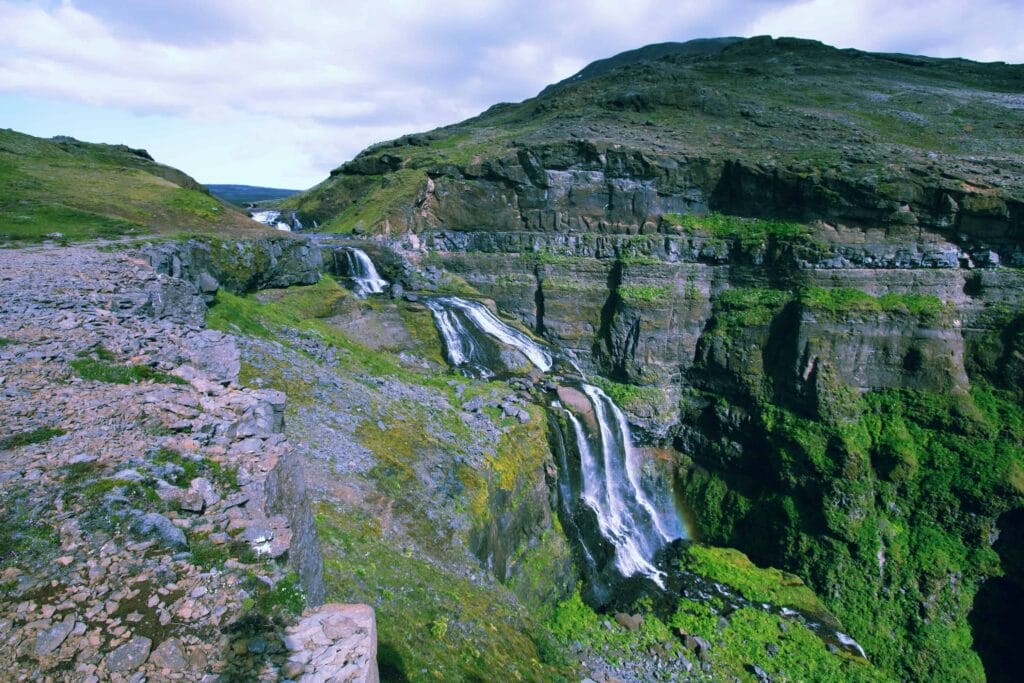
The second tallest Icelandic waterfall after Morsárfoss with a height of 650 feet, Glymur receives water from the Botnsá river. Located in Hvalfjordur fjord, The best season to visit Glymur waterfall is between June and September. Reaching Glymur requires some hiking, and for the best conditions choose these months. As a result, the surrounding view seems unreal and picturesque green during summer.
70. Hraunfossar
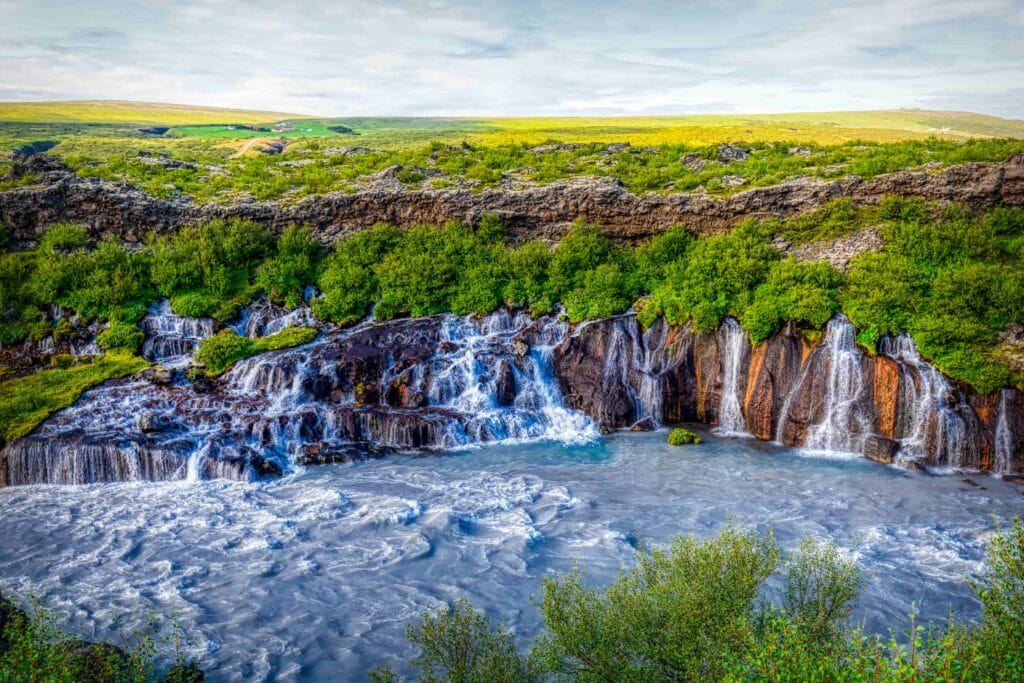
The Lava Falls, a.k.a. Hraunfossar shaped by Hallmundarhraun rivulets, are located in the Borgarfjörður district. The Hraunfossar trickling is due to volcanic eruptions near the Langjökull glacier and received by porous lava rock before landing in the Hvítá river. The cascades become a visitor hub during Ring Road detours.
71. Barnafossar
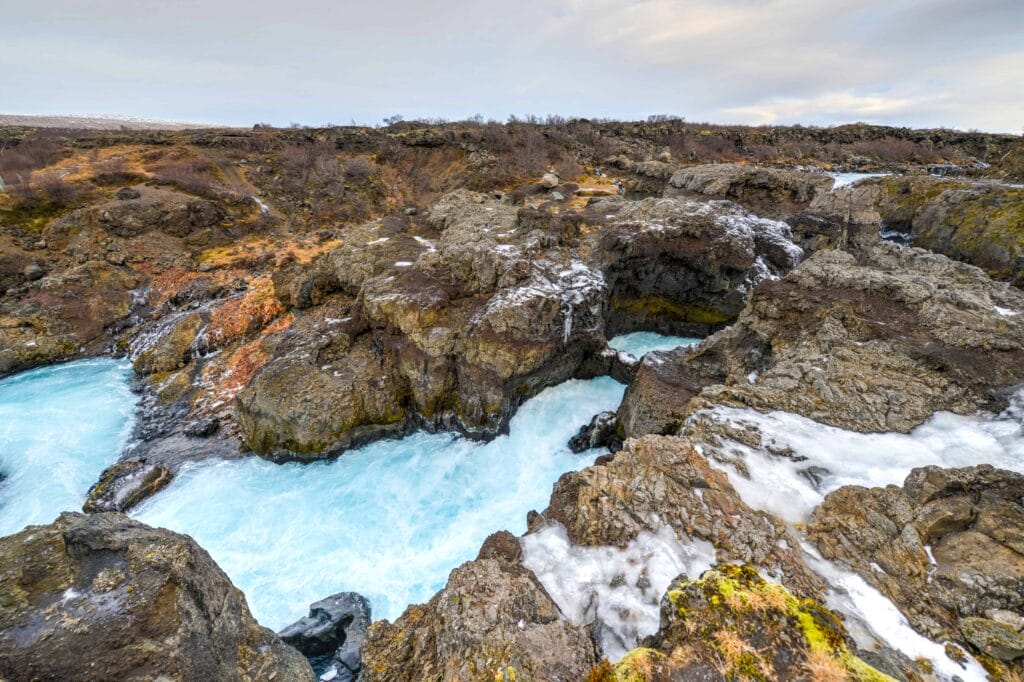
Flowing from a rocky and narrow valley with powerful force creating amazing churns and foams is Barnafossar waterfall in the vicinity of Hraunfossar. The dark folklore associated falls are also near Deildartunguhver hot springs and Borgarnes & Reykholt settlements. Barnafossar, a.k.a. Children’s Falls, pours rapidly through the White River water.
72. Glanni
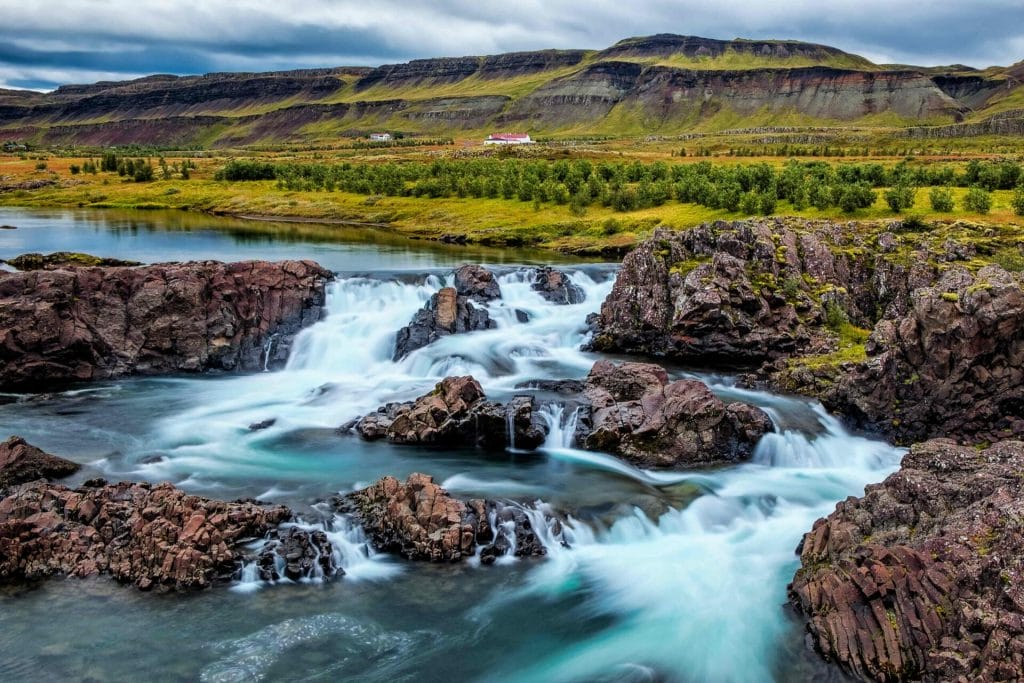
A west Icelandic waterfall near the Bifrost village and Grabrokarhraun lava field, Glanni is named after the water’s bright colors and means “brightness.” The small Glanni waterfall has three tires with multiple layers and receives water from the Norðurá river. The people believe that the place houses trolls and elves.
73. Borgarnes

A 2,000 resident town near Snaefellsnes Peninsula, and at the Borgarfjörður shore, Borgarnes is one of the earliest settlements. The place is renowned for the Centre for Puppet Arts, environmental Bjössaróló playground, and the Settlement Centre. The historic Viking town has mild weather with Icelandic water on all sides.
74. Krauma
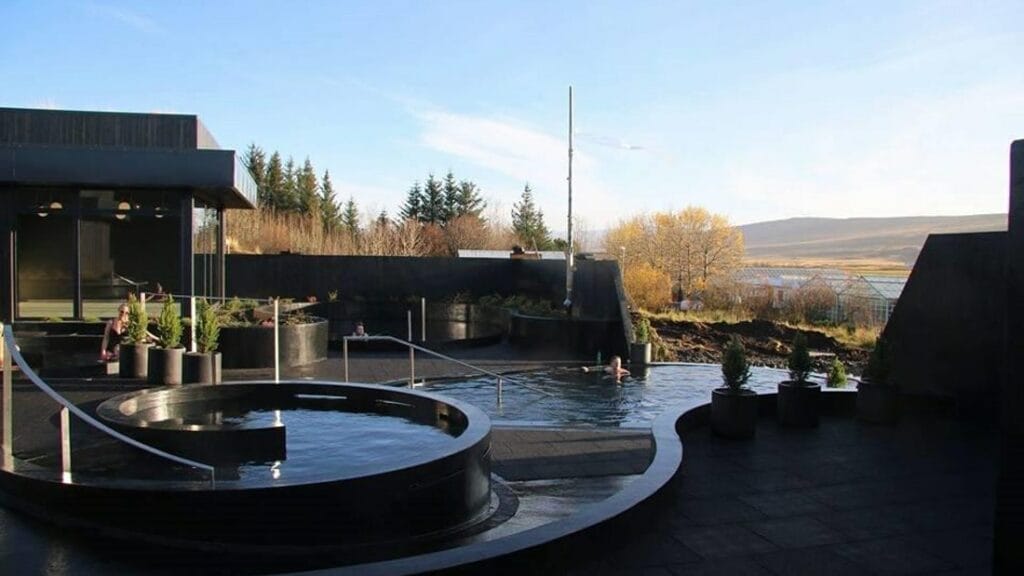
A spa resort and geothermal bath, Krauma is located near Deildartunguhver, the highest flowing European hot spring. In 2017, Krauma spa had a single cold tub, dual steam baths, and five hot tubs. The 140 guest capacity spa is close to Barnafoss and Hraunfossar falls, Víðgelmir lava cave, and Borgarnes town.
75. Víðgelmir Lava Cave
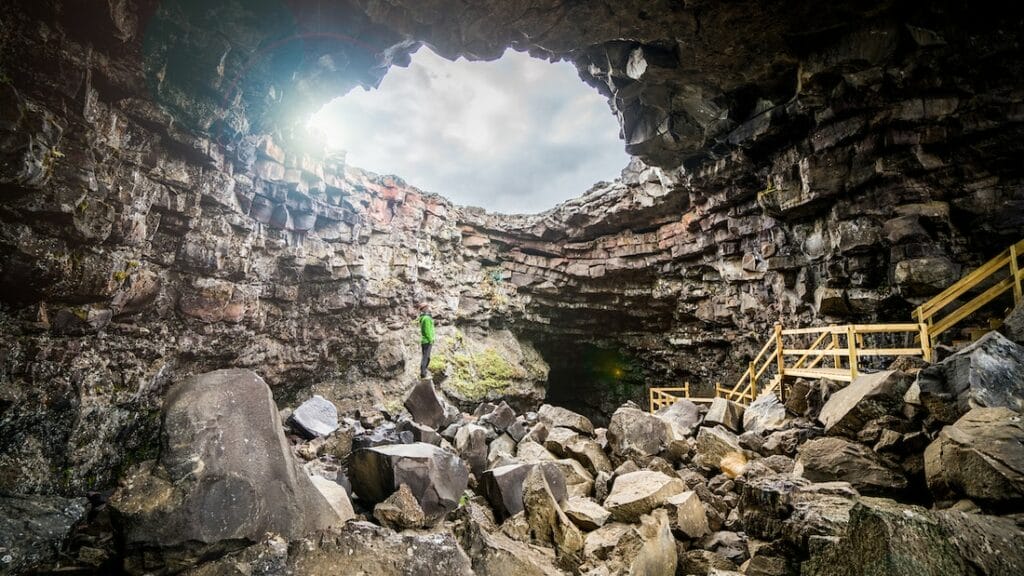
The 5,200 feet long Víðgelmir lava tube is located in Borgarfjörður below the Hallmundarhraun lava area formed after the 900 AD lava flow. The tube also has a width of 54 feet and a ceiling height of 52 feet. Viðgelmir has installed lights, paved pathways, and the history of bandit residents. It is highly recommended to take a tour to Víðgelmir to experience the lava caves of Iceland to the fullest.
SNÆFELLSNES PENINSULA
The Snæfellsnes peninsula, a.k.a. Iceland in Miniature, has a glacier tip volcano crown. If aptly translated, it means The Snow Mount’s Peninsula. The peninsula hosts magnificent craters, lava fields, volcanos, picturesque mountains, villages, towns, fishing hamlets, beaches, glaciers, coastline, rugged rocks, and frozen Atlantic wave trolls. So basically everything you might want to see in Iceland.
You can see many attractions of the peninsula on Roads 54 and 56. The peninsula has black, golden and pink beaches with breathtaking beauty. The driving tour from Reykjavík to the Snæfellsnes south-coast is a chronological order of covering unforgettable sights.
The dormant Snæfellsjökull glacier with a 1446-meter height and 200-meter crater depth lies on this course, and views over the Snæfellsnes National Park located on the west end of the 90 km peninsula.
76. Kirkjufell

Church Mountain or Kirkjufell is a distinct peak on the Snæfellsnes peninsula’s northern shore in the vicinity of the Grundarfjörður town. With a height of 1519 feet, Kirkjufell has become a notable Icelandic landmark despite the striking slopes. The arrowhead-like mountain is a hiker’s paradise with a magnificent river, coastline, and field panoramas.
77. Kirkjufellsfoss Waterfall
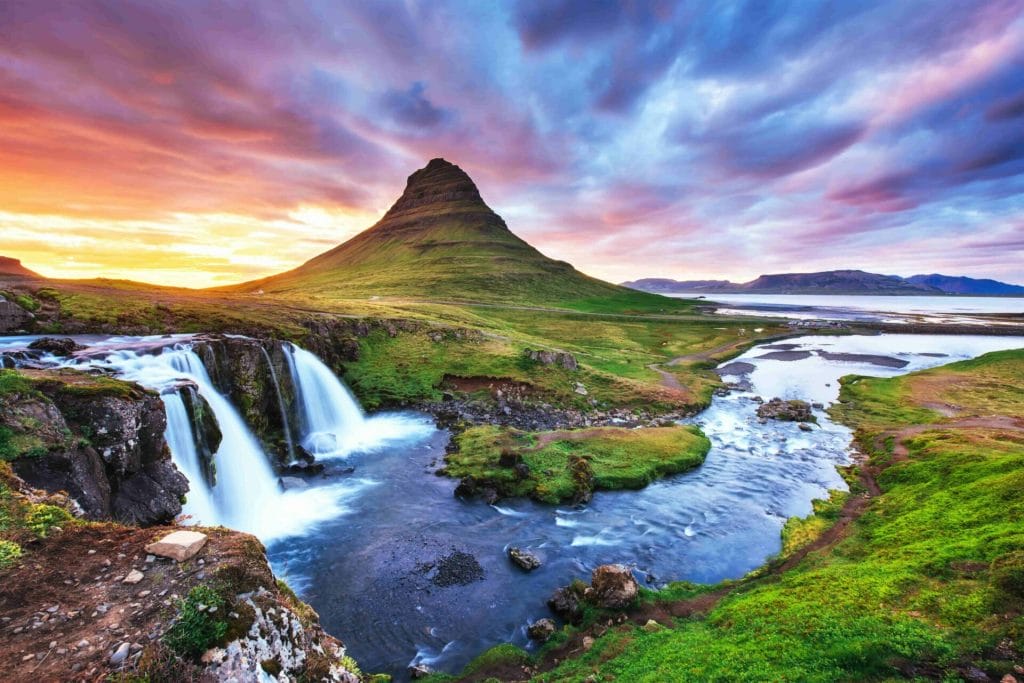
The three-tier Kirkjufellsfoss waterfalls receive water from the Kirkjufellsá river running through the Helgrindur volcano. Renowned as Church Mountain Falls, it is an excellent photo capturing place with Mt. Kirkjufell in the background and gentle yet seasonal changing flowing water, surrounded by local Icelandic farmer’s land and a nearby parking lot.
78. Arnarstapi
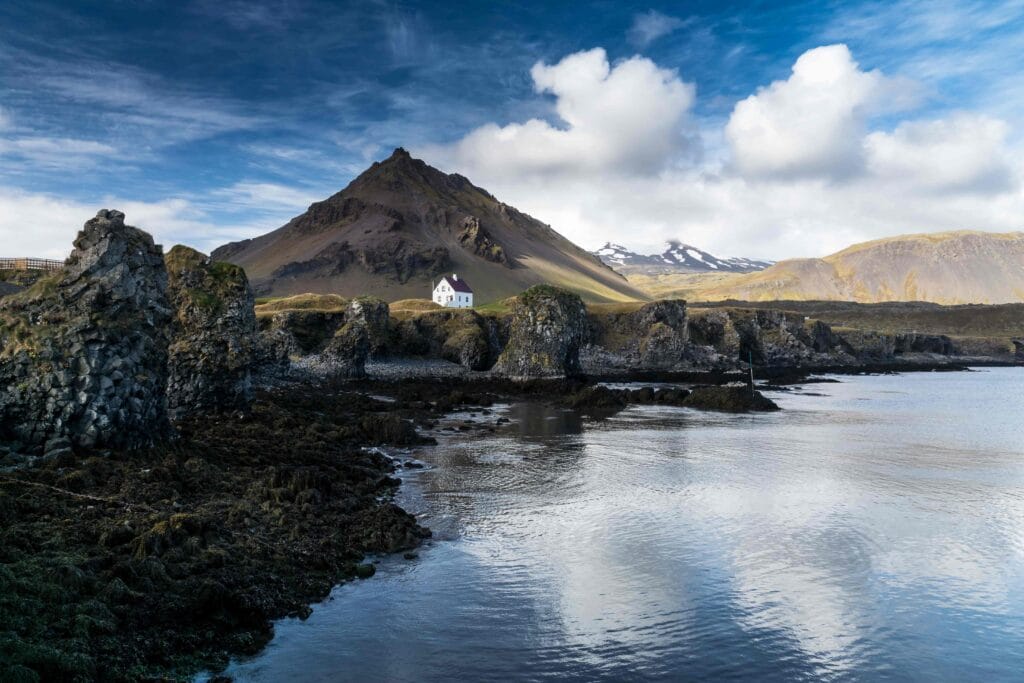
A southern Snæfellsnes peninsula village, Arnarstapi is a former fishing hub and presently a food stop while visiting the Snæfellsnes National Park. The village has some charming houses and nature’s beauty surrounding it. The nearby Arnarstapi beach with a circular and eroded stretch arch and waves make a fascinating spectacle during the day.
79. Stykkishólmur
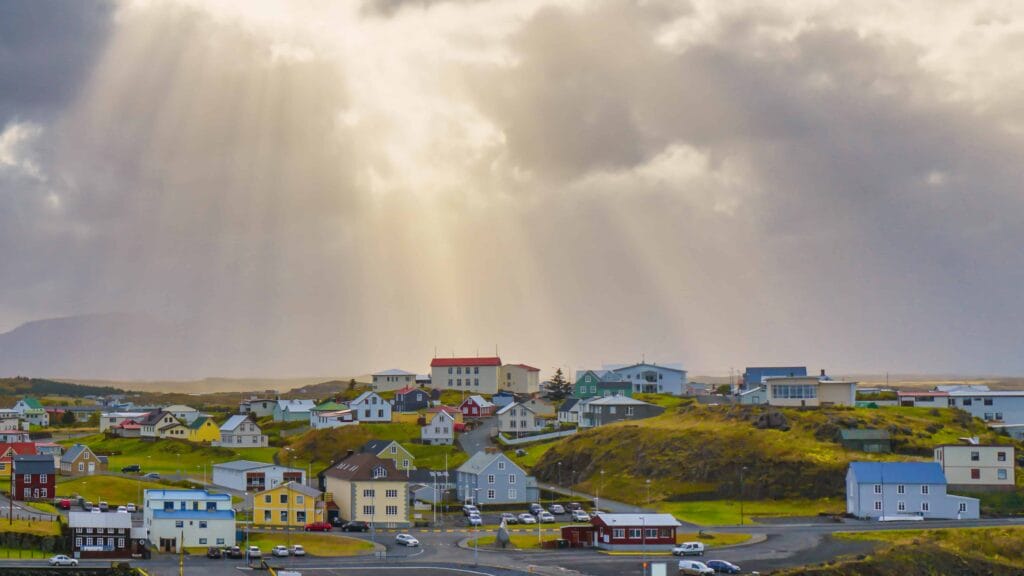
A 1,100 resident town, Stykkishólmur lies on the Snæfellsnes peninsula’s northern shore and is renowned for Brjanslaekur, Westfjords ferry sails. The cultural hub is home to the Norwegian House of 1828 and Volcano Museum of 1845. You can find variety of activities in this town, including some great restaurants, and boat trips. The town is close to Snæfellsjökull National Park and Mt. Kirkjufell.
80. Gerðuberg

Running along a cliff and located on the Snæfellsnes peninsula’s southern side is a series of immaculate basalt columns in a row known as Gerðuberg. The 1 km long Gerðuberg columns have a 23 to 46 feet height and five feet width comparable with a fortress wall.
81. Djúpalónssandur

An arch-structured bay, Djúpalónssandur, has black sand and dark cliffs. Djúpalónssandur was a former fishing village and a port for the fishing villages Hellnar & Búðir. The black pebble beach named after it has lava rocks and Snæfellsjökull glacier visible through a hole. You can even spot Svörtulón and Djúpulón freshwater lagoons behind the lava rocks.
82. Búðir
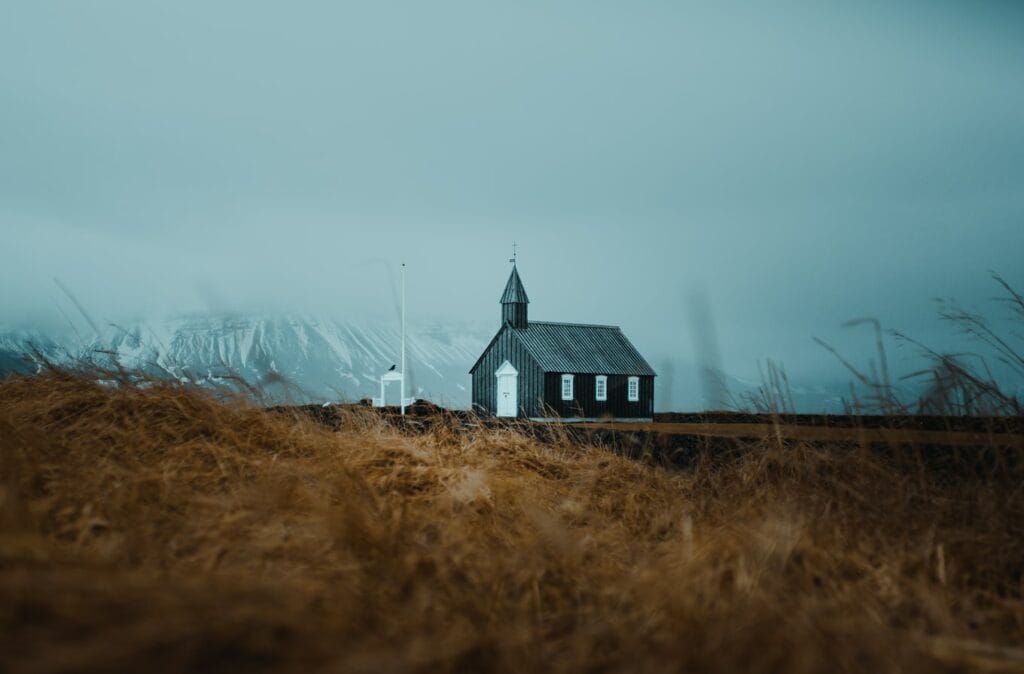
Snæfellsbær municipality’s small hamlet Búðir lies in the westernmost tip of the peninsula, and formerly a fishing village. Archaeological evidence even suggests that Búðir was an important port during the early settlement time. The famous shore is near the Snaefellsjokull glacier and boasts of Búðahraun lava field, windswept grass, jet black rocks, and a golden beach. The location is known for the beautiful black church. Hotel Búðir is also considered one of the best hotels in the area.
83. Rauðfeldsgjá
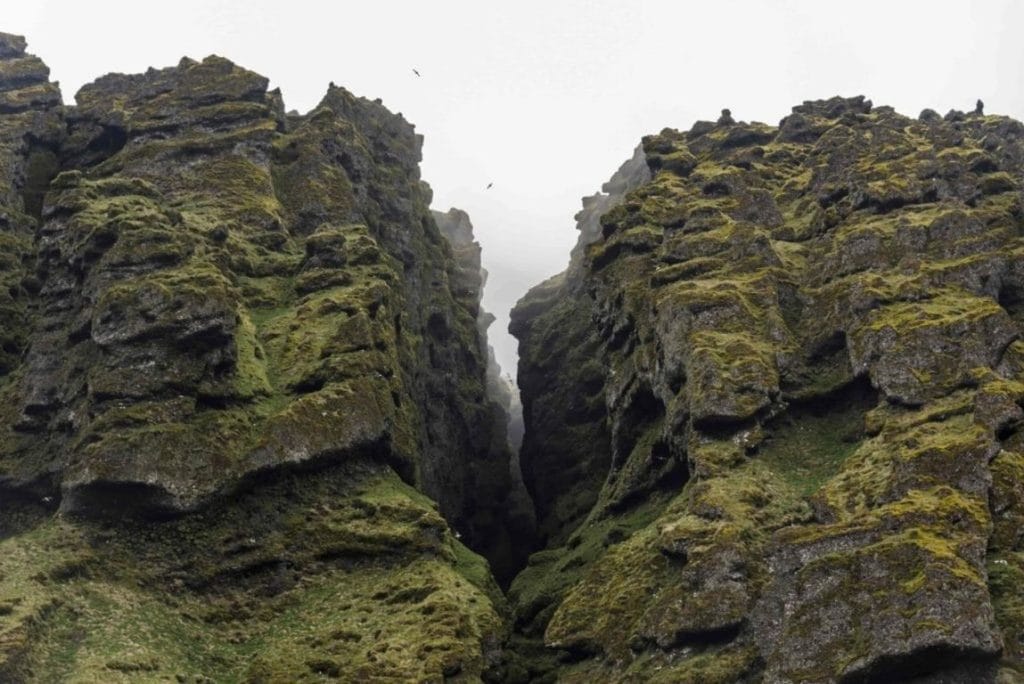
The Red-Cloak Rift or Rauðfeldsgjá is a mountains gorge with significance in the Bárðar Saga Snæfellsáss saga. The gorge is located next to Snæfellsjökull National Park and glacier and 410 feet from the trail of the parking lot and extends for many kilometers inside the fissure. It feels like entering another world when walking into the gorge.
84. Lóndrangar
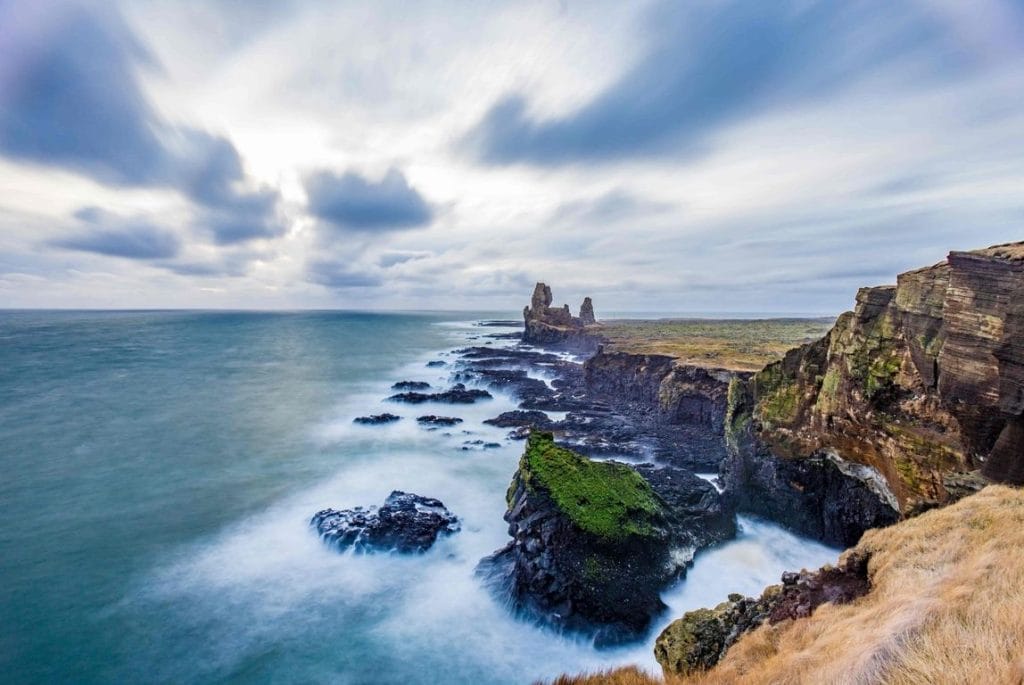
The basalt cliffs of Lóndrangar are geological wonders with two pillars of 246 and 200 feet height. The elves rumored site earned the name “the Rocky Castle” because of the incredible formations and offers access through the Visitor Centre of Snæfellsnes, crossing mossy lava fields and viewing the sea.
WESTFJORDS
The Westfjords are one of the most awe-inspiring Icelandic regions with sparse and small settlements. The dramatic featured landscapes seem untouched because of low awareness, and covering the land requires time. The 16 million-year-old region has ancient landscapes and verdant stretches but lacks lava fields and active volcanos.
The warmth of the Westfjords sites compensates for the needs of hikers, wildlife enthusiasts, nature lovers, photographers, and general tourists. Unfortunately, the steep mountains and limited lowland areas make agriculture scant in the region.
But the place is still a paradise with birds, natural resources, fishing, tourism, and beaches. Ísafjörður town is the region’s capital even though 3,000 yearly inhabitants and fishing villages have a population lower than 1,000.
85. Dynjandi Waterfall

The “Thunderous” or Dynjandi waterfall is a seven-tier pouring system with a 100 feet cumulative height tumbling extremely naturally through steps. The Icelandic Westfjords jewel has a breathtaking and majestic view seeming like a bridal veil. The waterfall also has a top and bottom width of 30 and 60 meters. Definitely the top location to explore in the Westfjords.
86. Patreksfjörður
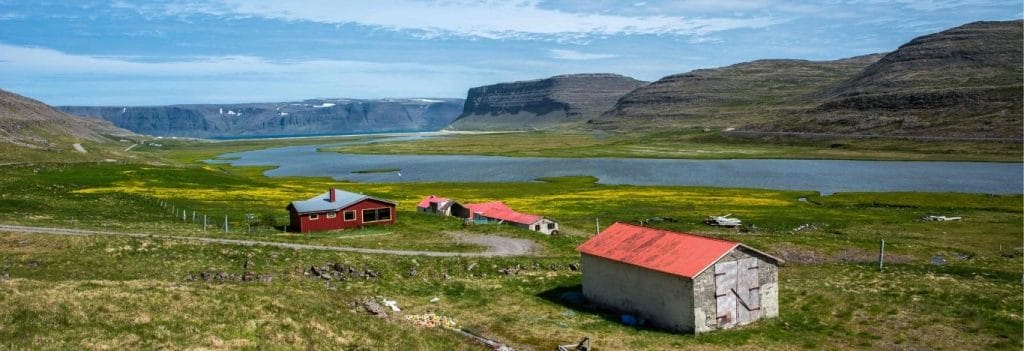
The charming Patreksfjörður village with almost 650 residents has become an uprising tourism industry spot, even though it has a primary interest in fisheries. The southern settlement is near Rauðasandur beach, Dynjandi waterfall, and Látrabjarg cliffs. Patreksfjörður is also in the vicinity of natural hot spots and houses a newly built swimming pool.
87. Hellulaug Hot Spring
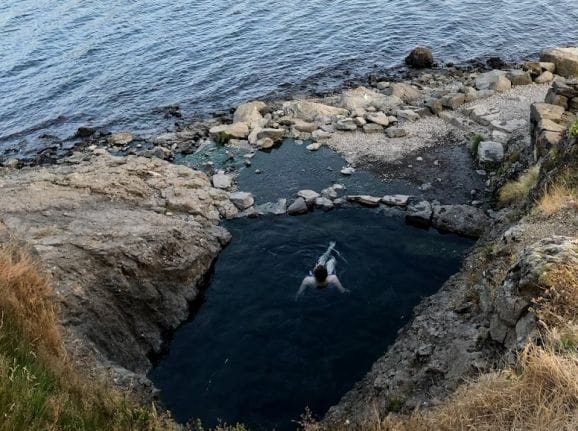
The remotely located Hellulaug hot spring offers a perfect Vatnsfjörður fjord and ocean view. The pool has a 38°C temperature, 60 cm depth, and 3-4-meter diameter. Hellulaug is situated next to the Vatnsfjörður beach, and the trail for the hot spring begins from a parking lot and crosses a cliff. It can be hard to find this hot spring because it is wrongly marked, so it is necessary to have the correct location for the hot spring. The walk from the parking lot to the hot spring is very short but there are no changing facilities there, so you will have to change in your car.
88. Látrabjarg
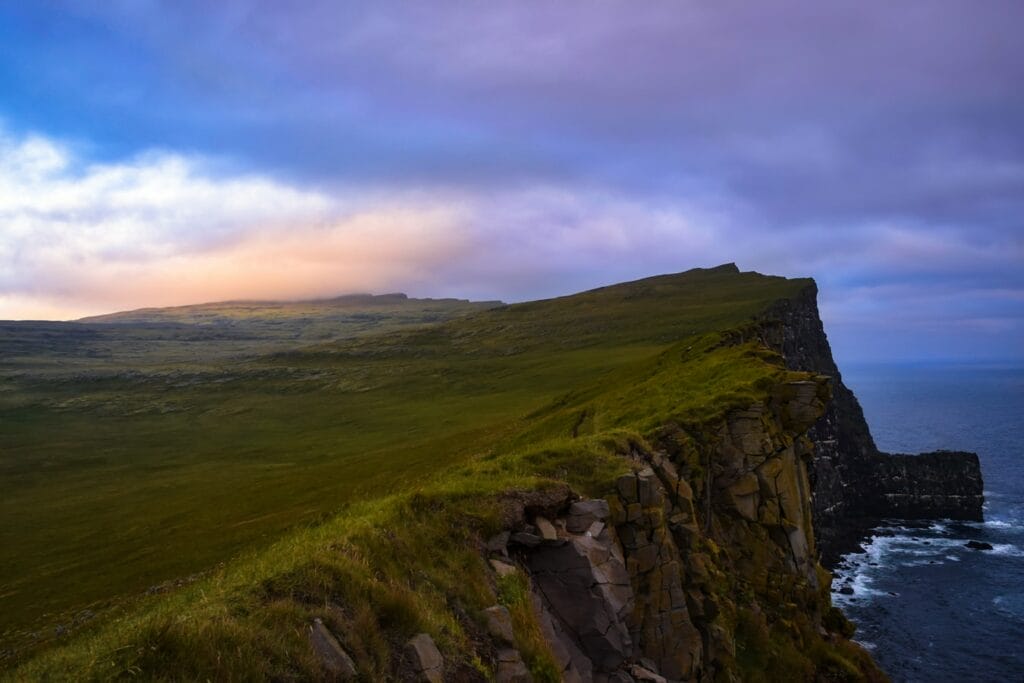
Prominent as Westfjords seabird cliff, Látrabjarg is home to fulmar, razorbill, guillemot, puffins, and other bird species. The destination is presumed to have the largest razorbill nesting colony in the world. The four-sided divided cliffs have painted white lines to inform about maintaining distance from the edge.
89. Rauðisandur
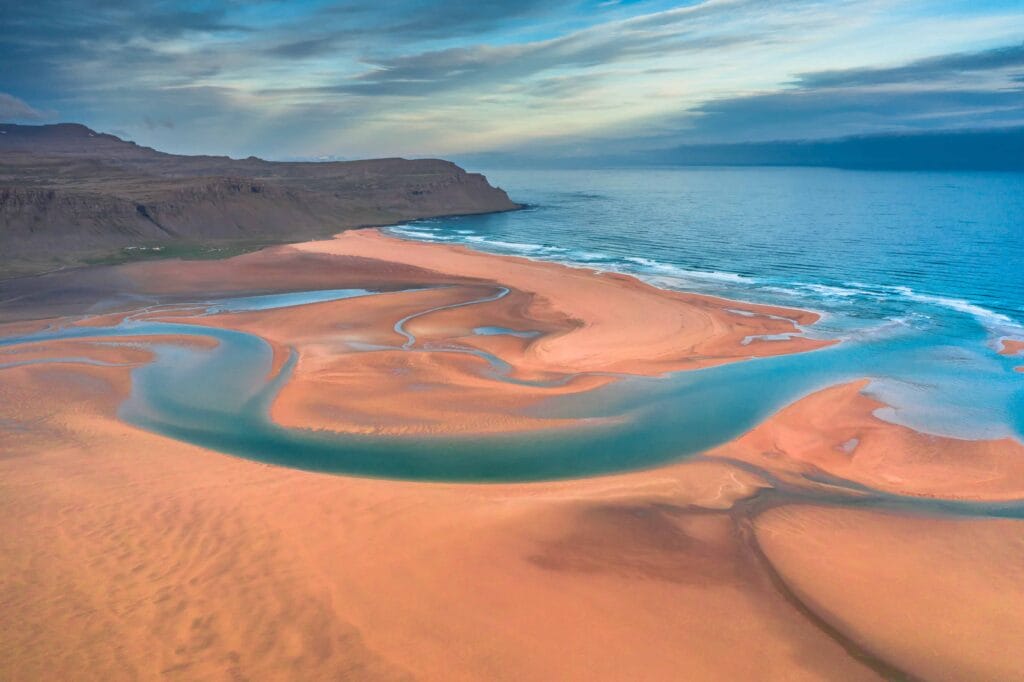
The Red Sand Beach or Rauðisandur is situated in Westfjords and significantly differs from Iceland’s black, golden, and pink beaches. The reddish color of the beach is the most likely reason for the name. The road to Rauðisandur is hard to drive and not recommended during winter.
90. Ísafjörður
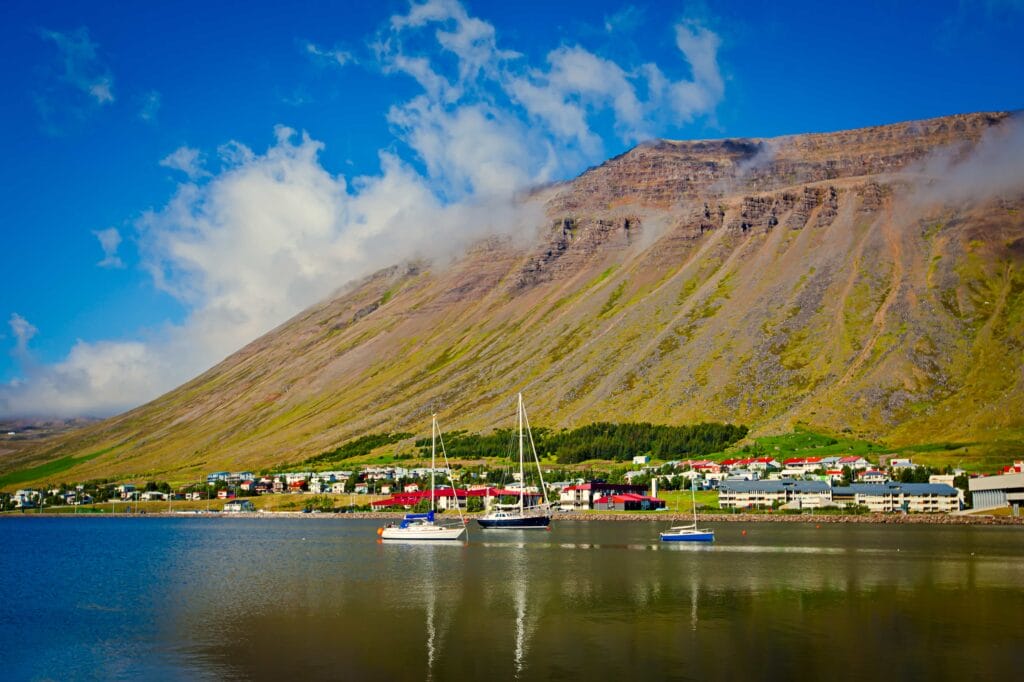
The region’s largest settlement, Ísafjörður town, is the center for fishing, tourism, trade, and commerce. The Book of Settlement mentions the city in the 9th Century and lies in the Skutulsfjörður fjord. Bordering the subarctic, the place is a tundra icy and cool winters and summers. You can find great restaurants in the town, including Tjöruhúsið, one of the most popular restaurant in Iceland. If you are staying overnight in the town we also recommend the bakery to start your day.
91. Garðar BA
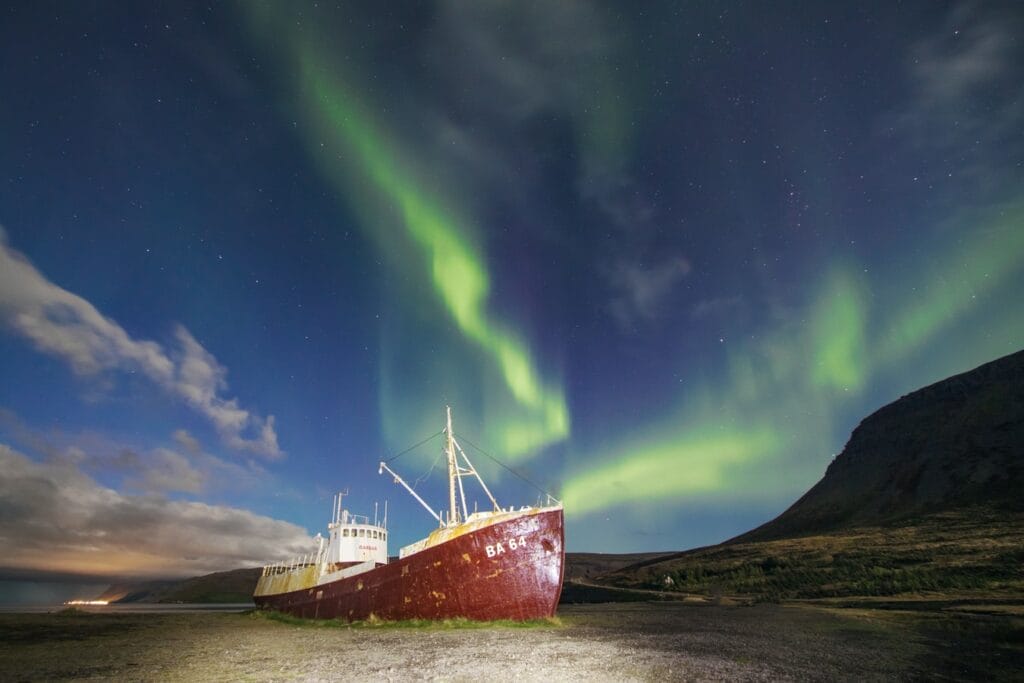
Sitting on the Patreksfjörður, Westfjords shoreline is the oldest steel ship Garðar BA 64. The escapades and high tide lines are a short distance from the rusting ship. The destination has become a photographer’s paradise because of the paintwork’s colors and rust. The place is reachable via the 612 route for Látrabjarg Bird Cliffs.
HIGHLANDS
Iceland has highlands throughout the country. The natural and impressive attractions take you away from crowds and noisiness while offering stunning sites, peace, silence, and serenity. You witness the tallest mountains, active survey volcanos, walkthrough geothermal areas, and snowmobile on glaciers.
The highlands divide into Central, Southern, Northeast, Central-North, and Northwest parts. The 1640 feet Central Highland has 3,281 to 6562 feet tall mountains, most of which are glacier-covered.
The Southern Highland is home to Eyjafjallajökull, Hekla, and Katla active volcanos. Northeast has the famous Lakagígar Craters, and basalt formations are visible in the Central-North and Northwest Highlands. The Highlands extend 40,000 square kilometers altogether and rank among the most prominent European unpopulated areas.
92. Landmannalaugar
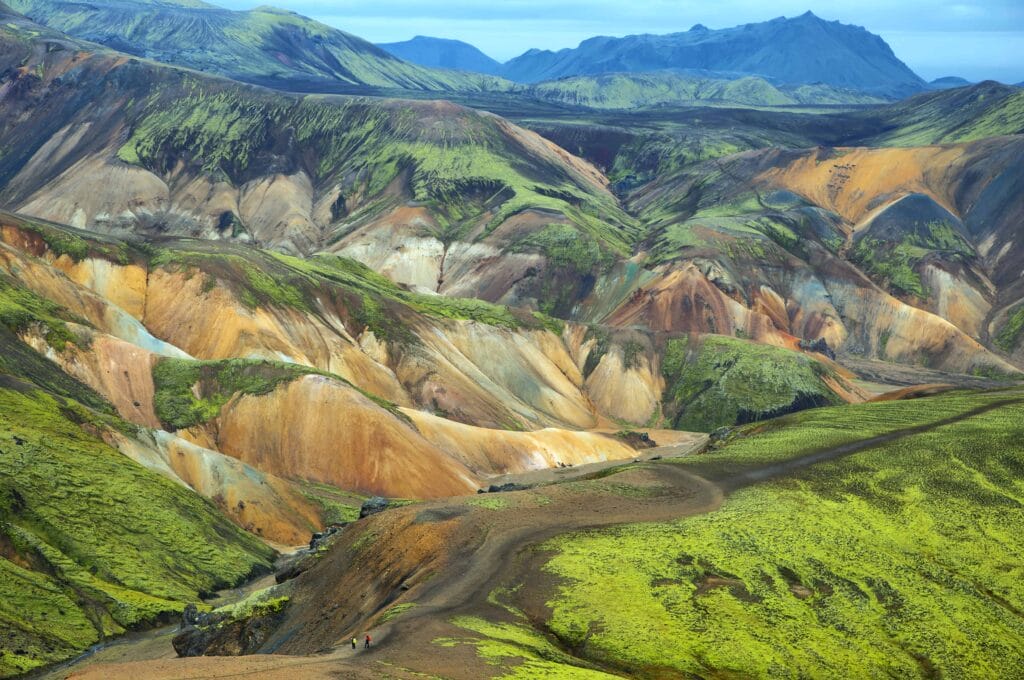
The Icelandic Highland Pearl, Landmannalaugar, has rich colored slopes and contrasting obsidian lava fields. The region’s natural hot springs remain open throughout the year for bathing and the Laugavegur Trail starting point is among the world’s top twenty hikes. The highland is a pearl because of rhyolite mountains, geothermal pools, and colorful landscapes.
93. Þórsmörk
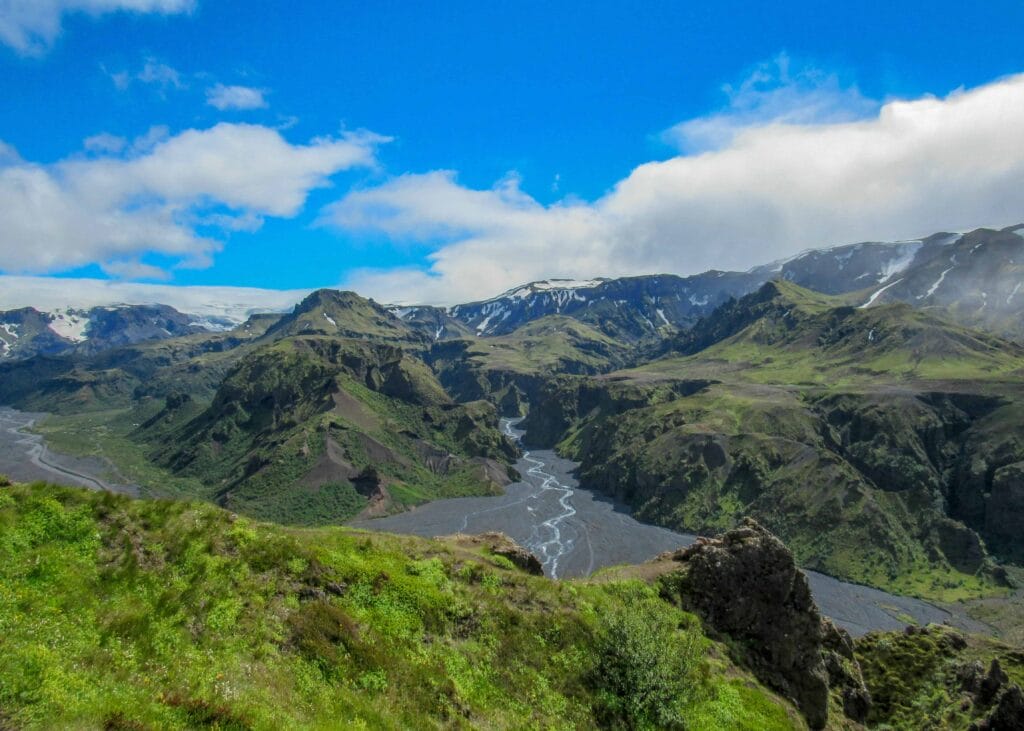
Located amidst the Mýrdalsjökull, Eyjafjallajökull, and Tindfjallajökull glaciers, Þórsmörk is a nature reserve and a famous hiking destination. Renowned as the Valley of Thor, Þórsmörk has glacier rivers, lush oases, and black desert expanses. Mountains, hills, slopes, gullies, and small valleys surround Þórsmörk. Þórsmörk is considered to be one of the best hiking locations in Iceland.
94. Háifoss Waterfall
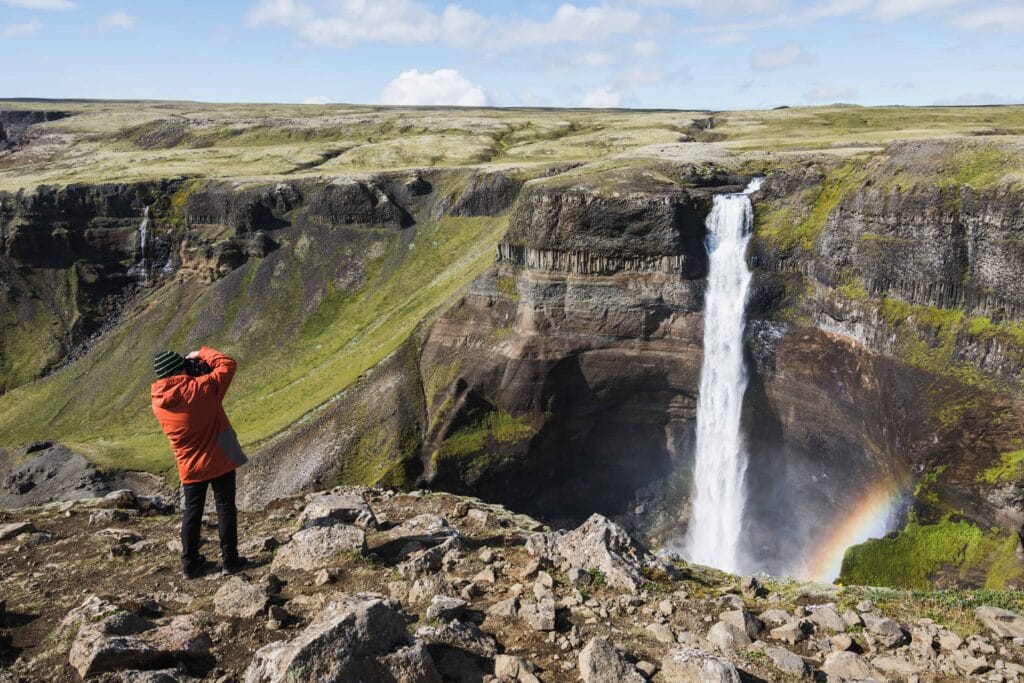
Háifoss waterfall is found in the Fossárdalur valley and takes pride as Iceland’s third tallest fall with a 400 feet height. The water of Háifoss arrives through the Fossá river, and the Hekla volcano lies within its sight. The folklore steeped Háifoss waterfall requires a four-wheeler to pass through the roads with bumpy gravel.
REYKJAVÍK
Iceland’s capital Reykjavík is on the southwest end next to Faxaflói Bay. The city’s landscape changes shape by volcanic eruptions, earthquakes, geothermal areas, and glaciers. The Reykjavík coastline sits beside islands, coves, straits, and peninsulas with seasonal visitation by whales and seabirds.
Eye-captivating annual festivals and events constantly happen in Reykjavík. Museums, galleries, and exhibitions showcase the culture of the country and the city. Prominent attractions like Harpa music hall, Grótta lighthouse, Viðey island, and others have contributed significantly. Swimmers, photographers, and nature lovers would love the Laugardalur valley experience.
Almost 70% of the country’s population, reside in Reykjavík. You can enjoy sightseeing, swimming, concerts, whale watching, shopping, and other activities in the region.
95. Reykjavík City
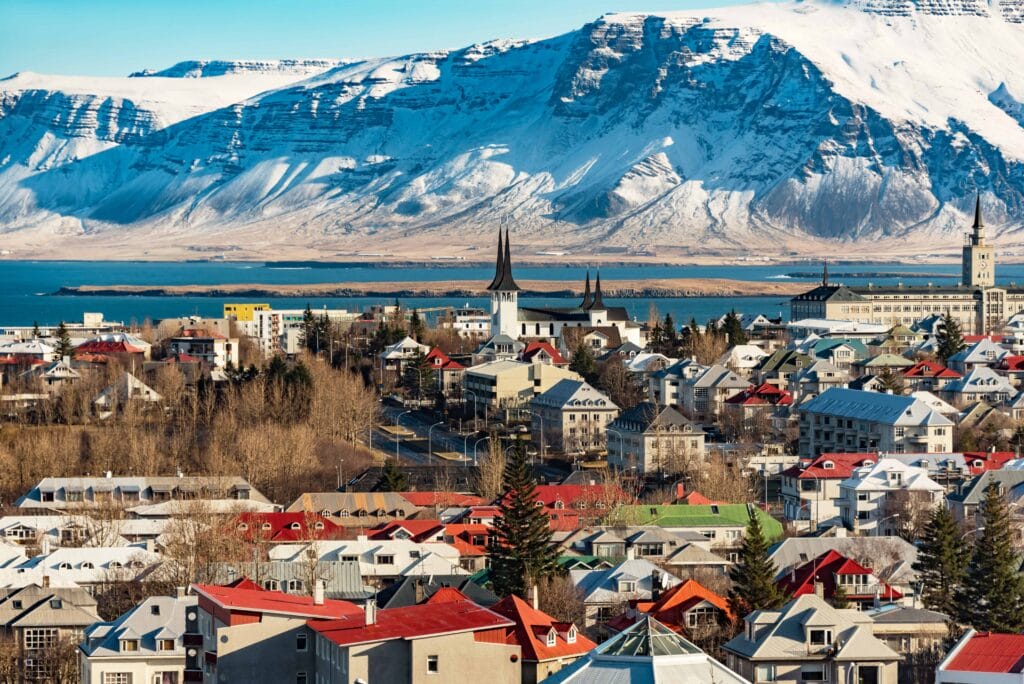
The country’s capital city, Reykjavík, is home to 123,000 locals and offers a vibrant culture with adventure tours, modern museums, vivid nightlife, galleries, restaurants, clubs, bars, and shops. In addition, breathtaking natural wonders such as the Blue Lagoon, the Golden Circle, and the Northern Lights close from the base.
96. Hallgrímskirkja
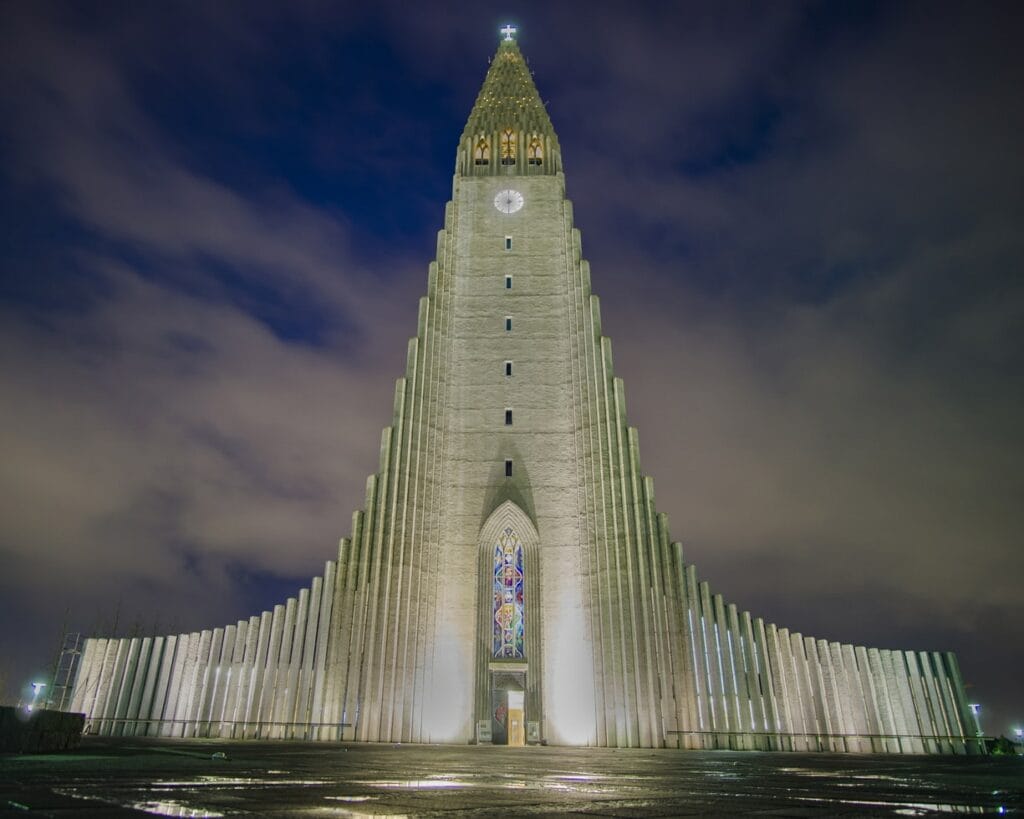
Located on the peak of Skólavörðuhæð hill is the Hallgrímskirkja Lutheran church with a height of 245 feet. The church designer, Guðjón Samúelsson, received inspiration from natural elements of the country like lava formation, hexagonal basalt columns, glaciers, and mountains. The design also resembles the historic Thor hammer.
97. Sun Voyager
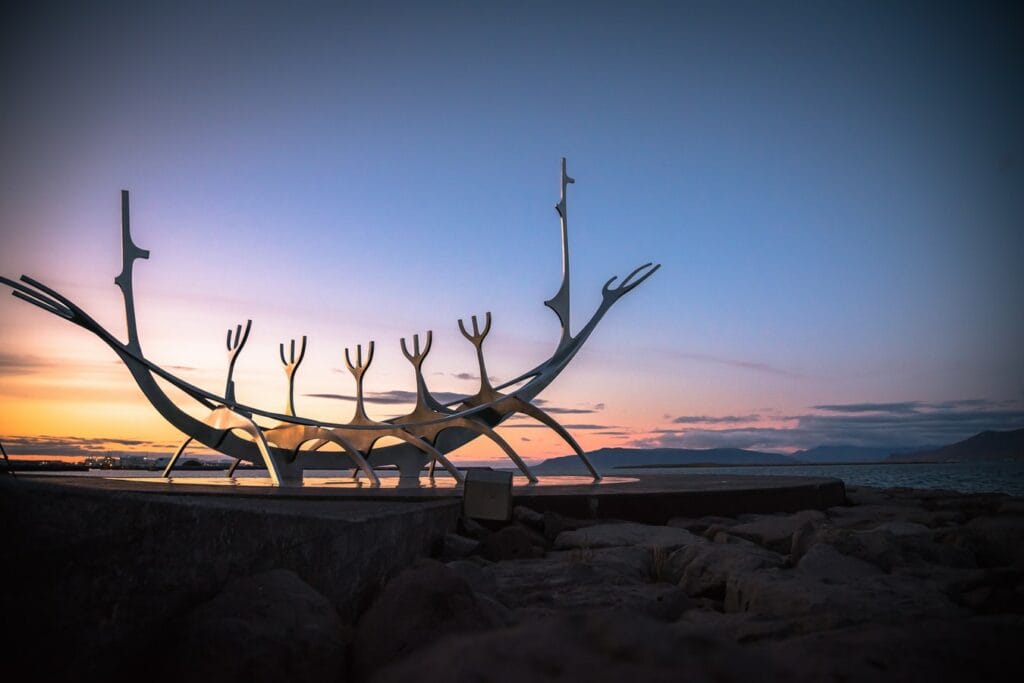
The Sun Voyager or Sólfarið is a ship’s large steel model situated on the Sæbraut road on central Reykjavík’s seaside. An aluminum prototype of the sculpture was donated to Reykjavík city after winning the 1986 competition for 200 years. An ode to the sun, the model faces north, crossing Faxaflói Bay.
98. Harpa Concert Hall

The Harpa Concert Hall has designs influenced by Iceland’s dramatic nature. Situated on a sea and land boundary, the conference center, and concert hall building are gleaming, city, sky, and harbor contrast. Olafur Eliasson designed the glass facade of the architecture, and the landmark has been the home of the Icelandic Symphony Orchestra and artists.
99. Perlan
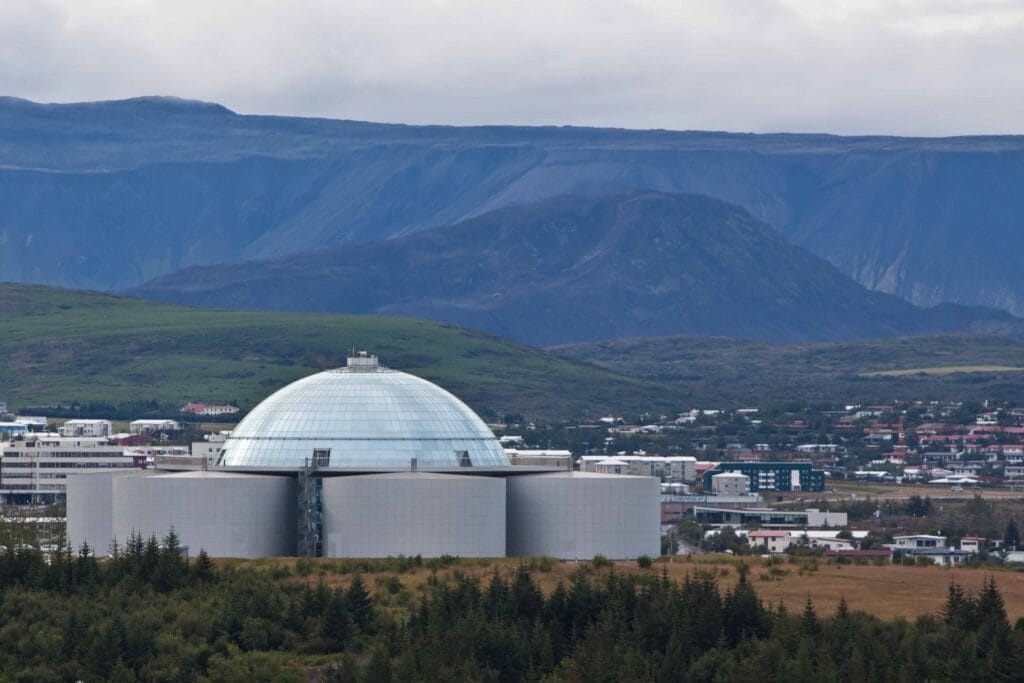
The Pearl or Perlan rotating glass dome and museum is located atop the Öskjuhlíð hill and covered with forests on all sides. The distinct landmark of the capital is seated atop 24 million liters in six water tanks. Perlan hosts numerous displays and exhibitions throughout the year. You can find a restaurant and a café inside Perlan. It is the ideal place to have a cup of coffee and enjoy the view of Reykjavík.
REYKJANES PENINSULA
The Reykjanes peninsula runs through the drifting North American and Eurasian tectonic plates and experiences extreme volcanic activities like earthquakes, lava fields, and eruptions. The peninsula is renowned for the Keflavik International Airport and the Blue Lagoon, besides other natural wonders.
The Krýsuvik geothermal area by the Kleifarvatn is one such spot with geothermal activity and mud geysers. The shore-side cliffs on the way to Grindarvík city offer an unforgettable lifetime experience. While driving towards the Gunnuhver area, you will find the fierce Gunnuhver hot springs, Reykjanestá, Atlantic Ocean, Eldey island & Reykjanesvíti lighthouse view from the cliff.
The peninsula has 20,300 inhabitants, a US Army base, offers views of Reykjavik downtown from the Mt. Keilir, and is referred to as the “Smokey Peninsula.”
100. Blue Lagoon
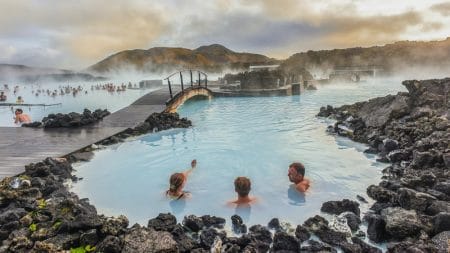
The milky-blue color “Blue Lagoon” contrasts the grey moss and black lava fields surrounding it. The 39°C bathing water of the Reykjanes Peninsula is renowned for cone-like volcanos and barren landscapes. The soothing water also provides skin nourishment and is the most popular tourist attraction in Iceland.
101. GeldingadalurVolcano
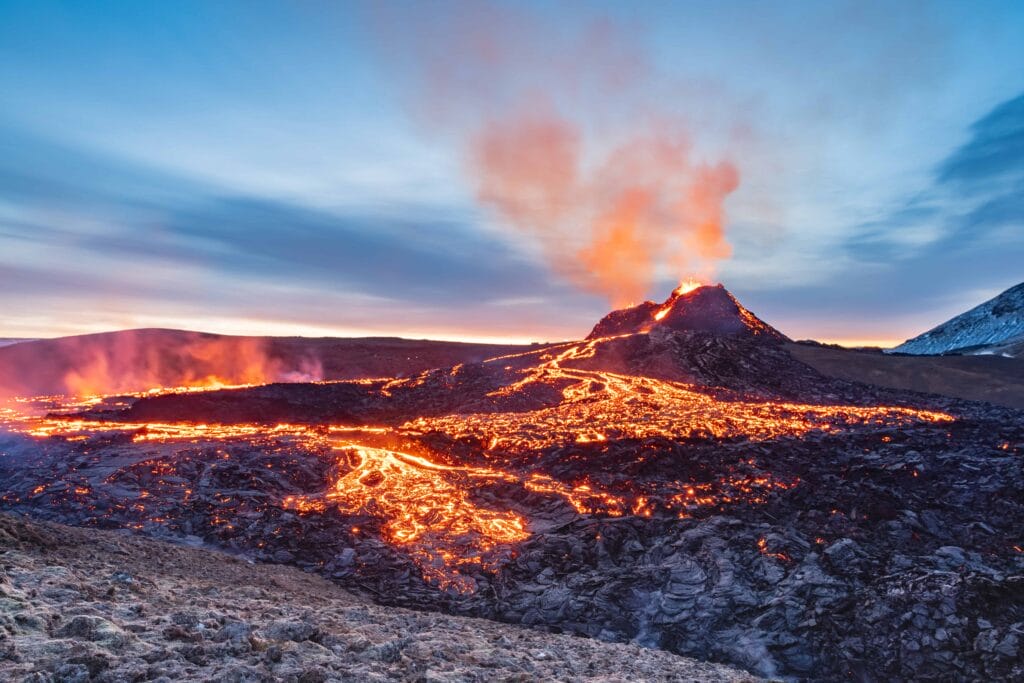
Visiting an active volcano is definitely a once in a lifetime experience. It’s not every day that you get to hike through lava fields to see an active erupting volcano. Look at the melting lava flow from the volcano, feel the heat from the volcano and enjoy your time. Geldingadalur Volcano is 100% a must do when visiting Iceland.
102. Bridge Between Continents
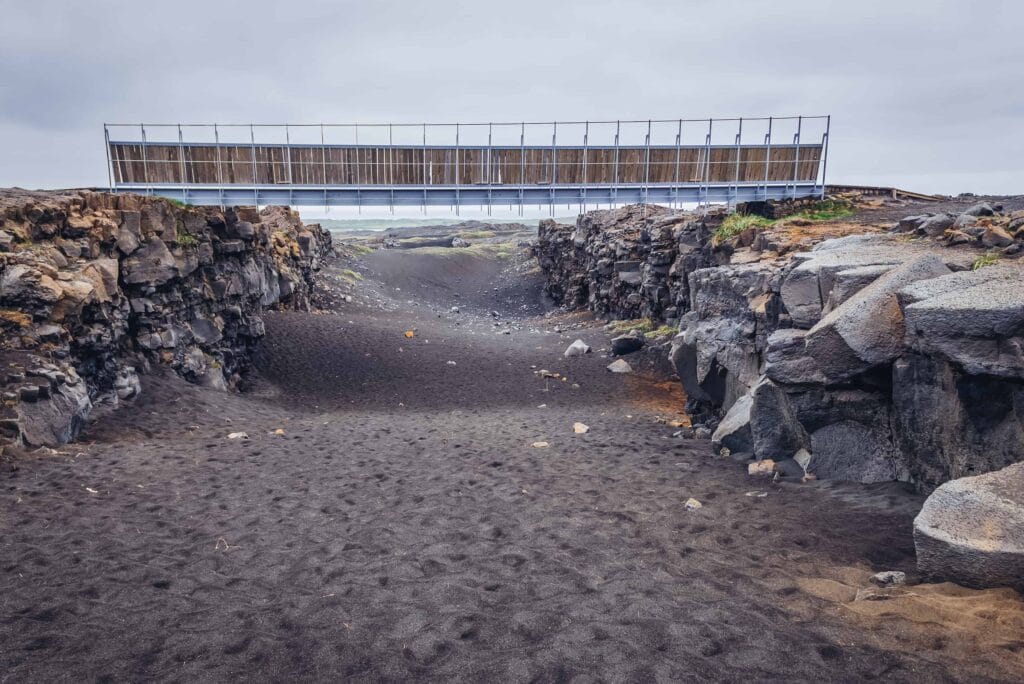
The slowly drifting Eurasian and North American tectonic plates are connected via the Bridge Between Continents. Located on the Reykjanes Peninsula’s end, the Bridge connects the west and north Iceland with the North American Highlands and Eurasia. The 50 feet footbridge has a crevasse below it and offers a splendid view of the Eldey island.
103. Krýsuvík
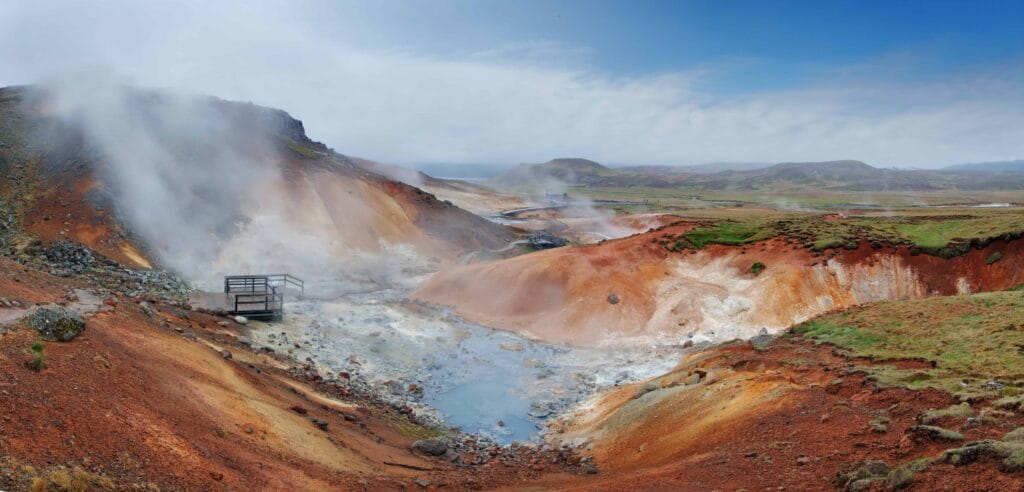
The Krýsuvík geothermal area has numerous mud spots, steaming vents, different colored mineral deposits, and hot springs. Located amid the Reykjanes Peninsula, Krýsuvík is visited chiefly along with other sites such as Krýsuvíkurbjarg bird watching, Brimketill oceanside pool, Kleifarvatn lake, and Bridge between the Continents’.

